
Calamintha grandiflora
Lamiaceae
calamint
Calamintha is literally translated as “beautiful mint,” which accurately summarizes the virtues of this genus. The calamints are close relatives of the mints and have strongly aromatic foliage—plant one beside a path and every time you brush against it the garden will be filled with a pleasant fruity, minty scent. The flowers are mint-like too, small but abundant, clustering in the leaf axils, tubular with a pair of lips framing the mouth. Calamints typically bloom for six weeks or more, attracting hosts of birds, butterflies, and hummingbirds. Calamints have the adaptability and persistence of mints, thriving in virtually any well-watered, well-drained soil, and in sun or part shade, but they lack mint’s aggressive nature, and are not invasive or prone to weediness.
Though deer and insect resistant, calamints may be susceptible to powdery mildew; grow them in an open, airy location, especially where humidity is high. Propagate by seed or division in spring.
Calamintha grandiflora
syn. Satureja grandiflora
• pink
• late spring to early fall
• 18–24 in. × 12–15 in.
• sun, part shade
• Z5–9
Showy calamint. Southern Europe. This erect and bushy species bears bright pink flowers, 1–1.5 in. long, with a large, pouting, three-lobed lower lip. The ovate leaves are opposite, 2–3 in. long, and strongly toothed around the edges. Cut back by half after the first flush of bloom to encourage rebloom.
‘Variegata’ has light green leaves attractively marbled with white. Makes a fine, summer-long underplanting for hybrid teas and other roses. Less vigorous than the species.

Calamintha grandiflora
Calamintha nepeta
• white, light blue
• summer
• 12–18 in. high and wide
• sun
• Z5–7
Lesser calamint. Central and southern Europe. Bushy, dense, and sometimes sprawling with ovate, gray-green leaves to 0.75 in. long, and tiny but abundant flowers. It is perfect for edging walks, patios, or herb gardens, or at the front of a border. Allow to spill over retaining walls or showcase in a container. Drought tolerance makes this species suitable for rock gardens too.
‘Blue Cloud’ is compact with light blue flowers and fine, gray-green foliage. To 15 in. high and wide. ‘White Cloud’ has white blooms.
subsp. glandulosa is more vigorous than the species, with 1.25-in. leaves and slightly larger flowers that bloom all up and down the stems.
Malvaceae
poppy mallow
This genus of North American prairie plants is a boon to gardeners in dryer regions who want long-lasting floral color with little investment in irrigation: poppy mallows’ deep taproots make these plants outstandingly drought tolerant, ideal subjects for xeriscapes and gardens where water is in short supply. Another common name for members of this genus is “wine cups,” which provides a vivid picture of its flowering: the five-petaled, upward-facing flowers are shaped like bowls, and range in color from an almost burgundy reddish purple through shades of rosé to a limpid white. The blooms make a fine showing against the lacy foliage and are borne abundantly for a couple of months or even longer, depending on the species and the local climate—a very hot, dry summer can shorten the display.
Callirhoes prefer a sunny spot and well-drained, even sandy soil; a persistently damp soil, especially in winter, is likely to prove fatal. Sometimes attacked by aphids and red spider mites; seldom browsed by deer.
Other than the species described here, Callirhoe alcaeoides and its white cultivar ‘Logan Calhoun’, C. digitata with its fringed flowers, and clustered poppy mallow, C. triangulata, are also interesting.
The taproot makes dividing or even transplanting older plants difficult. Propagation by seed is better, whether sown directly in spring or started in containers, thus minimizing root disturbance when transplanting.
Callirhoe involucrata
• pink, purple
• midspring to early fall
• 0.5–1 ft. × 1–3 ft.
• sun
• Z4–8
Purple poppy mallow. Prairies, fields, and roadsides from North Dakota east to Missouri, south to New Mexico and Texas. This species forms low, spreading mounds of palmately divided leaves; magenta flowers to 2.5 in. across are borne on slender stems above the foliage. Delicately textured, excellent as a groundcover at the front of borders, in rock gardens, or meadows. Especially attractive spilling over stone walls.
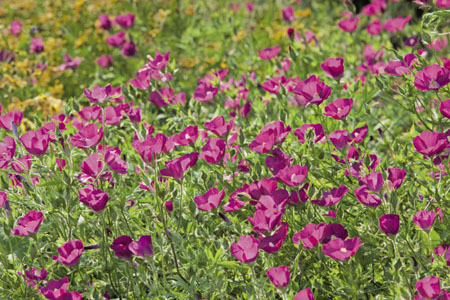
Callirhoe involucrata
Ranunculaceae
marsh marigold
Just how this genus acquired the common name of marigold isn’t clear, but it’s a misnomer, for caltha flowers are clearly close relatives of buttercups. The most widely cultivated species is Caltha palustris, which the Royal Horticultural Society describes as “an essential plant to brighten up the margins of a pond or a boggy area with sunny yellow flowers.” The only other species commercially available is C. leptosepala, a native of western US mountains, which shares C. palustris’s preference for wet or moist situations but blooms later, thus prolonging the marsh marigold show.
All parts of marsh marigolds are toxic—even the sap may raise a rash in sensitive individuals. This makes these perennials a poor choice for a landscape with children but endows the plants with resistance to deer. Marsh marigolds thrive in a wide range of soils, so long as they are rich in organic matter and consistently moist.
Propagate by dividing mature plants or by seed collected as soon as it is ripe; sow in late summer and overwinter in a cold frame or other cool but protected spot.
Caltha palustris
• yellow
• early to midspring
• 10–12 in. × 12–18 in.
• sun, part shade
• Z3–7
Yellow marsh marigold, kingcup. Bogs and other wet locations throughout the northern and coastal parts of North America, and northern temperate regions worldwide; flourishes inland if given sufficient moisture. Mounds of glossy, heart- or kidney-shaped leaves with stout, hollow, branching stems. Buttercup-like, waxy, bright golden-yellow flowers are 1.5 in. across, with five petal-like sepals, carried on upright stems 12–18 in. Sometimes reblooms in late summer or fall. May spread by seed on consistently damp soils.
var. alba bears single, white flowers.
‘Flore Pleno’ (possibly ‘Multiplex’, ‘Monstruosa’, ‘Monstrosa-Plena’), sometimes known as May blob, bears double yellow pompon-like flowers with greeny-yellow centers, similar in appearance to a florist’s ranunculus. Sterile and longer blooming.
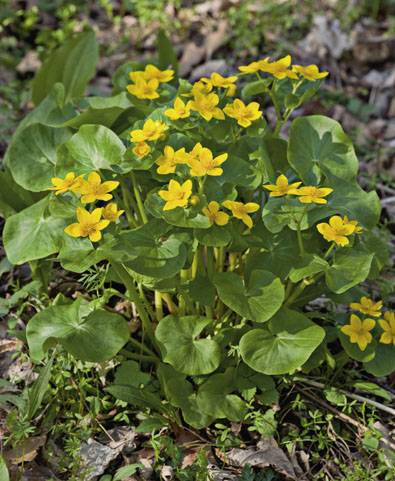
Caltha palustris
Campanulaceae
bellflower
This large and diverse genus of about 420 species includes plants of many different habits—from upright to creeping—whose diversity enables them to fill niches in plantings ranging from perennial borders to rock gardens. A large number of species is native to North America, with its western mountains being an especially rich source. Campanulas supply some of the finest, clearest blues in the garden, though the palette of floral colors found in this genus extends to a range of whites and pinks as well. It should be noted that the species Campanula armena was formerly sold under the name of Symphyandra, but since being reclassified, most nurseries are now advertising them under the new name.
As the common name indicates, campanula flowers are often bell shaped, although there are species with tubular, star-, or cup-and-saucer-shaped blossoms as well. Conscientious deadheading prolongs the season of bloom.
Note that several species described below tend to be invasive. Creeping or roving bellflower (C. rapunculoides—not described here) is one to avoid for all but the wildest, most informal and open spaces. Once introduced it is almost impossible to eradicate. Another hardy, though less aggressive species worth investigating is C. rotundifolia, native to most of North America and northern Europe.
Though usually easy to grow, bellflowers are susceptible to snails, slugs, spider mites, and aphids. Powdery mildew and rust may also be problems. As a group, campanulas attract hummingbirds, but resist deer browsing. The longer-stemmed species are decorative as cut flowers; sear the base of the stems to avoid the milky sap fouling the vase water.
Sow seed in containers in spring or early fall (overwinter with protection), by division in spring or autumn, or by basal stem cuttings from new spring growth.
Campanula armena
syn. Symphyandra armena
• blue, white
• late spring to early summer
• 15 in. × 12 in.
• sun, part shade
• Z7–8
Ring bellflower. Caucasus, Turkey, Iran. Deeply toothed, heart-shaped, hairy leaves on domed networks of branching stems. Nodding, bell-shaped, lavender-blue or white flowers are borne prolifically. At home in any light, well-drained garden soil. Long-lived treasure for rock gardens or border foregrounds.
• blue, purple, white
• early to late summer
• 6–12 in. × 1–3 ft.
• sun, part shade
• Z4–7
Carpathian harebell. Mountains of eastern Europe. A species of modest vigor and stature best suited to the front of a border, rock, or cottage garden, or for display in a container. Heart-shaped, dark green leaves form neat tussocks that in summer are covered with bell-shaped flowers with a diameter of 2–3 in. Well-drained soil—regularly moistened but allowed to dry between waterings—promotes good growth.
‘Blue Clips’ is low growing and spreading with violet-blue flowers.
‘Pearl Deep Blue’ blooms heavily with large, bright blue flowers.
‘White Clips’ is compact, 6–8 in., with pure white flowers.
Campanula cochlearifolia
• blue, purple
• early to late summer
• 2–4 in. × 6–8 in.
• sun, part shade
• Z3–8
Fairies’ thimbles. European mountains. This fast-growing, even aggressive, species has a low and spreading habit that makes it valuable for edgings or as an underplanting for taller perennials. The dense mat of diminutive leaves provides a pretty backdrop for the showy 0.5-in. bells.
‘Bavaria Blue’ has sky-blue flowers.
‘Bavaria White’ bears heavy crops of pure white flowers.
‘Elizabeth Oliver’ bears intricate double, pale lavender flowers.
Campanula glomerata
• blue, purple
• summer
• 12–24 in. × 15–24 in.
• sun, part shade
• Z3–8
Clustered bellflower. Europe, Asia. Free blooming; forms clumps of upright stems above basal rosettes of long-stemmed oval, toothed leaves 4–5 in. long. Lacking petioles, the stem leaves are sometimes clasping and smaller. Dense but rather ungainly clusters of funnel-shaped, 0.75- to 1-in., bright purple flowers clump at the stem tips and in leaf axils. Long lasting as cut flowers. Provide part shade in hot regions, full sun is preferable in cooler climates. Group with daylilies, tickseeds, Helen’s flower, and summer phlox.
‘Crown of Snow’ (‘Schneeckrone’) has pure white flowers. 18–24 in.
‘Freya’, named for the Norse goddess of love and fertility, produces starry, lilac-purple flowers on the top two-thirds of the stems. Late spring to summer. Non-invasive. 10–15 in. tall.
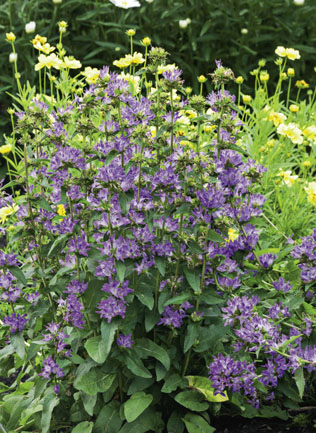
Campanula glomerata ‘Freya’
‘Joan Elliot’ blooms early with upward-facing, light purple-blue flowers. Good for cutting. Tolerates wet soils. 18 in.
‘Superba’ is a strong grower with bright purple-violet flowers. 24 in.
Campanula lactiflora
• blue, purple, white
• midsummer to early fall
• 3–5 ft. × 1–3 ft.
• sun, part shade
• Z4–10, HS
Milky bellflower. Caucasus. Long lived and imposing, milky bellflower forms a group of tall stems clothed with rounded leaves and topped with conical spires of sweet-scented, 1.5-in., bell-shaped flowers. Cut back to 1 ft. in midspring to encourage denser, sturdy growth that doesn’t require staking. Performs best on rich, moist but well-drained soils. Self-seeds. Combine at the back of the border with hollyhocks.
‘Alba’ has white flowers, but is otherwise similar to the species.
‘Dwarf Pink’ is compact but floriferous, bearing an abundance of pink flowers. Late spring to early summer. 18–24 in.
‘Lodden Anna’ bears pale pink flowers.
‘Pfouffe’ is dwarf, with an abundance of pale blue flowers. 1–2 ft. tall.
‘Pritchard’s Variety’ bears violet-blue flowers over an extended season. 3 ft.
• blue, purple, white
• late spring to early fall
• 1–3 ft. × 1–1.5 ft.
• sun, part shade
• Z3–8, HS
Peach-leaved bellflower. Mountainous areas of Europe, northern Africa, and northern and western Asia. Forms a rosette of narrow, glossy, bright green leaves. Cup-shaped flowers in shades of blue, lilac, or white borne along the full length of tall, slender stems. Prefers an evenly moist soil that drains well, and some afternoon shade in regions where sun is intense. Does not tolerate summer heat and humidity well. Self-seeds readily and also spreads by rhizomes. Appropriate in cottage gardens, borders, and open woodlands, and as a cut flower. Good companions include catmint, daylilies, hardy geraniums, and lilies.
‘Alba’ is white flowered.
‘Chettle Charm’ has flowers that are creamy white, edged with lavender-blue.
‘Kelly’s Gold’ has bright golden foliage and white flowers tinged blue around the edges.
‘La Belle’ is compact, with small, double flowers, deep blue with a silver gloss, borne all summer. To 24 in.
‘Telham Beauty’ is extra vigorous (to 4 ft. tall) with porcelain-blue flowers.
Campanula portenschlagiana
syn. C. muralis
• blue, purple
• late spring to midsummer
• 3–6 in. × 1–3 ft.
• sun, part shade
• Z4–8
Dalmatian bellflower. Rocky uplands of Dalmatia, Croatia. In favorable locations, this low, mat-forming plant spreads rapidly by rhizomes. Heart-shaped, dark-green leaves with toothed edges; abundant 1-in., funnel-shaped, blue to purple flowers. Protect from the early afternoon sun in hot climates. Suitable for rock gardens, edgings, and for containers.
var. alba is white flowered.
‘Aurea’ has golden foliage.
‘Birch Hybrid’ makes a neat cushion, 4–6 in. tall and 20 in. across, covered with cupped, blue-purple flowers from early summer into fall.
‘Resholt Variety’ bears intensely violet-blue flowers.
Campanula poscharskyana
• blue
• midspring to early summer
• 4–12 in. × 1–1.5 ft.
• sun, part shade
• Z3–8
Serbian bellflower, Dalmatian bellflower. Northern Balkans. A sprawling, prostrate species that forms a low, mounded groundcover of oval to cordate, medium green leaves to 1.5 in. long. Evergreen where winters are mild. Lilac-colored, star-shaped, 1-in. flowers borne in loose panicles along the stems. Excellent as edgings along a path or around a patio, in containers, or spilling over the top of a retaining wall or down a bank.
‘Blue Rivulet’ is a similar but more compact form of ‘Blue Waterfall’. Perfect for containers and small gardens. 6–7 in.
‘Blue Waterfall’ bears an abundance of lavender-blue flowers. 8–10 in.
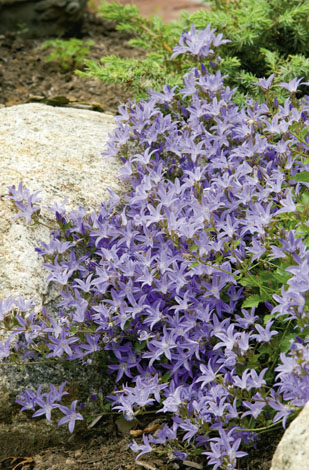
Campanula poscharskyana ‘Blue Waterfall’
‘E. H. Frost’ has white flowers. Excellent tumbling over walls and rocks. 8 in.
‘Stella’ has violet-blue flowers. 6–12 in.
Campanula punctata
• pink, white
• early to midsummer
• 1–2 ft. × 1–1.5 ft.
• sun, part shade
• Z5–7
Spotted bellflower. Siberia and Japan. Long blooming and easily grown; forms basal rosettes of rounded, toothed, green leaves to 5 in. long, from which rise arching stems. These sport racemes of nodding, tubular, white to pale pink flowers as much as 2 in. long, spotted purple inside to guide foraging bees. Spreads freely by rhizomes or self-sown seeds and can become thuggish; suitable for informal borders, cottage gardens, and lightly shaded woodland settings. Keep under control.
‘Bowl of Cherries’ has pink to dark purple-red bells on 15-in. plants. Remove spent flowers for later rebloom. Vigorous. Z5–9.
‘Cherry Bells’ has rose-red flowers. Tolerates heat and humidity well. 24 in.
‘Hot Lips’ is dwarf, with large, bell-shaped, pale pink flowers, speckled burgundy inside, above rich dark green foliage. 10–12 in.
‘Kent Belle’ has glossy violet-blue flowers on upright stems. Tolerates southern heat and humidity. Sterile. Striking with silver-leaved companions. 24 in. Z5–9.

Campanula punctata ‘Kent Belle’
‘Pink Chimes’ has nodding, pink flowers. 9–18 in. tall.
Campanula takesimana
• pink
• mid- to late summer
• 18–24 in. × 24 in.
• sun, part shade
• Z5–8
Korean bellflower. Korea. Rhizomatous roots produce basal rosettes of heart-shaped leaves, 3–4 in. long, above which rise winged flower stems. Branching sprays of nodding, tubular, pink-flushed, white flowers, 2–3 in. long, decorated inside with maroon spots and speckles. Deadhead routinely to keep neat. Spreads vigorously, valuable only in informal or very lightly shaded woodland, shrub, or wild gardens and for cutting.
‘Elizabeth’ blooms freely with plenty of purplish pink, speckled blooms. Vigorous.
Other Notable Cultivars
‘Bumblebee’ bears masses of small, upright, blue bellflowers in summer. Excellent in containers and crevices. 4 in. × 12 in. Z4–8.
‘Sarastro’ is upright and compact. Abundant large, purple flowers from early summer, repeating until fall. 18 in. × 24 in. Z3–8.
‘Viking’ displays tubular, light lavender flowers. Compact, excellent for the middle and front of borders, and cottage and cutting gardens. Spreads in a quiet, civilized way; sterile. Attracts hummingbirds and butterflies. 18 in. tall.
syn. Dentaria
Brassicaceae
bittercress, cardamine
The genus Cardamine now includes plants formerly known as Dentaria, although some nurseries still sell them under their former names. These modest plants are most effective in damp areas in wild gardens, under shrubs, or in the flower garden. They do best where winters are mild, and summers cool without too much humidity; the heat and humidity of the southeastern United States is not to their liking. Spikes of cruciform (petals arranged in a cross) flowers of white, pink, mauve, or lavender are carried above the leaves that may be entire or divided into leaflets. Several native American species, such as C. diphylla and C. bulbosa, are perfect for moist woodlands and native plant gardens but are difficult to find in the trade.
Propagate by seed or divide in spring or fall.
Cardamine pentaphyllos
syn. Dentaria digitata, D. pentaphyllos
• white, purple, lilac
• late spring
• 12–18 in. × 12 in.
• part shade
• Z5–9, HS
Showy toothwort, bittercress. Mountains of southern Europe. The mid-green, palmately divided leaves contrast well with loose clusters of 0.5- to 0.75-in., bright pink or purplish flowers. Lovely under spring shrubs or allowed to naturalize with bulbs.
Cardamine pratensis
• mauve, pink
• late spring
• 12–18 in. × 12 in.
• sun, part shade
• Z5–8, HS
Lady’s smock, cuckoo flower, milkmaid’s delight. Wet meadows and marshes of North America, Europe, and northern Asia. Short, scaly underground stems give rise to basal rosettes of glossy, dark leaves with several pairs of leaflets. Clusters of pale lavender or pink, 0.5- to 0.75-in flowers top unbranched stems. Leaf-tip cuttings and bulbils may also be removed for propagation. Allow to naturalize in rough grass around a pond or stream.
‘Flore Pleno’ has double, mauve flowers. 8 in. tall.
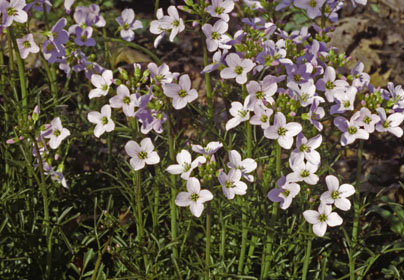
Cardamine pratensis
Cardamine trifolia
• white
• late spring
• 6–9 in. × 12 in.
• part shade
• Z6–8, HS
Trifoliate bittercress. Wooded areas in mountains of central and southern Europe. Dark green leaves with three leaflets may be reddish beneath. Cupped, white flowers crowd into short clusters, displaying bright yellow anthers, reminiscent of Arabis. Perfect for damp rock gardens or beside a pond or waterfall partnered with summer snowflakes and forget-me-nots.
Asteraceae
Cupid’s dart
According to tradition, plants of this genus earned their common name through their former use as the principal ingredient for love potions; certainly, any gardener is likely to fall in love with such an easy, adaptable, and showy flower as Cupid’s dart.
As natives of the lands bordering the western Mediterranean, Cupid’s darts prefer well-drained soils; a consistently damp soil may prove fatal, especially in winter. Its drought tolerance makes this genus a good choice for xeriscapes, and its grayish foliage is an attractive companion for wormwoods (Artemisia spp.), lamb’s ears, and other silver-leaved herbs. Cupid’s dart harmonizes especially well with lavenders; its airy foliage is useful for adding texture to beds and borders. Excellent cut, fresh or dried. The old-fashioned look of the fringed flowerheads makes this a natural for cottage gardens too. Pests and diseases, except powdery mildew, are seldom a problem. Deer tolerant.
Propagate by seed started indoors or direct sown in spring, divide in spring, or take winter root cuttings.
Catananche caerulea
• blue
• early to late summer
• 18–24 in. × 10–12 in.
• sun
• Z4–9, HS
Cupid’s dart. Clump forming, with wiry flower stems rising from a nest of narrow, grassy, gray-green leaves topped with 2-in., cornflower-like heads of blue to lavender-blue. The petal-like ray flowers are prettily fringed on the outer end; a darker-hued eye accentuates each flowerhead. Deadhead to extend bloom time. This species is mostly short lived but commonly self-sows.
‘Alba’ has white flowers accented with a blue eye.
‘Armor White’ has white flowers with a purple eye that bleeds a lavender tinge to the rays.
‘Major’ is deeper colored than the species, with a dark eye.
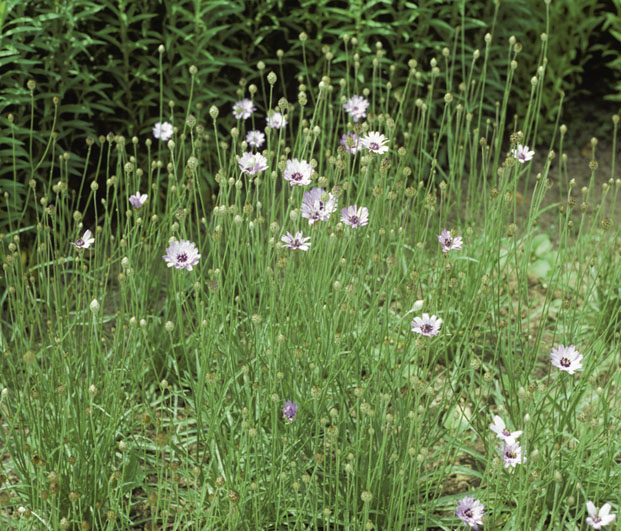
Catananche caerulea
Berberidaceae
blue cohosh, squaw root
A gem for native woodland gardeners. Unlike many of the spring-blooming natives that are ephemeral, this species retains its handsome bluish, airily divided leaves through the summer and into fall. Not only do they make good filler plants, but in autumn they mount a striking display of conspicuous bright blue berries that hang on even after leaf drop or until eaten by mice or other wildlife.
Each plant produces one or two large leaves on tall, grayish stems; in blue cohosh (Caulophyllum thalictroides) these appear as the flowers open, but slightly later in giant or purple-flowered blue cohosh (C. giganteum). The two species overlap in range along the eastern US seaboard inland to Mississippi, with the latter species reaching well north into upper Canada. An Asian species, C. robusta is seldom cultivated in the United States.
Blue cohosh thrives in moist woodland soil high in organic matter. In cold climates protect the overwintering crowns with dry leaves. Otherwise, maintenance is low; plants are seldom browsed by deer probably due to the bitter taste of the leaves, which are reputed to be poisonous to mammals. As suggested by the common names, blue cohosh has been used medicinally by generations of Native Americans. Today it is still widely used as a homeopathic remedy, especially for female complaints.
In woodland gardens or native plantings, group or mass with native ferns, Virginia bluebells, black snakeroot, and turtleheads.
Divide mature plants in spring and fall, when plantings become overcrowded; blue cohosh resents disturbance. Sow seed as soon as it ripens. Germination may be erratic and plants seldom flower until they are four to five years old.
Caulophyllum thalictroides
• yellow green
• early to late spring
• 12–30 in. × 8–15 in.
• part shade, shade
• Z3–8
Blue cohosh, squaw root, papoose root. Rich, well-drained mixed woodlands from southeastern Canada and Maine to Alabama, Oklahoma, and Mississippi including the eastern seaboard. Emerging stems are purple and carry grayish purple leaves reminiscent of meadow rue foliage; later they turn an attractive blue-green. The variably yellow-green or purple-green, 0.5-in. flowers are arranged in flat-topped clusters, but they are not memorable except to nectar-collecting bees. The grape-like clusters of fleshy dark, blueberry-like seeds, however, are eye-catching. Look but don’t eat, however, as these seeds cause gastrointestinal distress, especially in children; all parts of the plant can irritate the skin of sensitive individuals. Blue cohosh does not thrive in regions of intense heat.
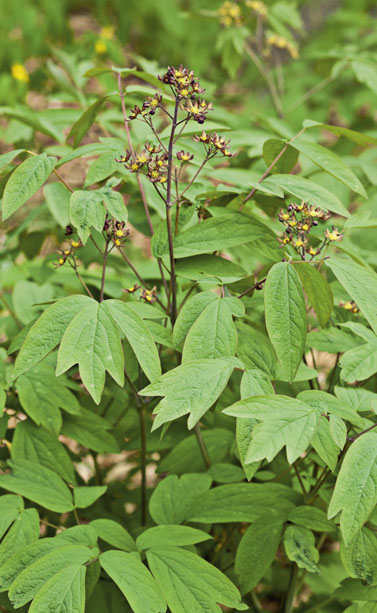
Caulophyllum thalictroides
Asteraceae
knapweed, cornflower
Although this is a large genus, only a few species are deemed worthy of ornamental gardens. These are most suitable for flower borders, but are also appropriate for less formal places, such as interplanted among grasses.
Their strong stems topped with showy flowerheads make the ornamental knapweeds ideal as long-lasting cut flowers, both dried or fresh. Butterflies, bees, and other insects enjoy the pollen and nectar, so they are excellent additions to wildlife gardens. Generally suitable for xeric gardens; wet feet in winter is often lethal. The soil should be sweet, preferably with a pH above 7. Deadhead almost to the ground after the first flush of bloom to encourage rebloom later. Be aware that some species have roaming roots and may become invasive. Staking is seldom necessary, and knapweeds usually require little maintenance. Deer generally ignore these plants, but rabbits find them tasty. The foliage is occasionally attacked by mildew, especially where air circulation is poor.
Propagate by seed sown in spring or by division in spring or fall.
Centaurea cineraria
syn. C. candidissima, C. gymnocarpa
• mauve
• late spring
• 36 in. × 12 in.
• sun, part shade
• Z7–11
Dusty miller. Italy. Commonly grown as an annual but perennial in milder climates. The common name, dusty miller, is also applied to a variety of other plants with silvery foliage, notably white- or yellow-flowered Senecio cineraria; beware of misidentifications in catalogs. Centaurea cineraria produces clumping mounds of velvety, lobed, white leaves that make an elegant foil for other, more brilliant colors in sunny beds or borders. The foliage seems to glow at night, making it perfect for moon gardens. Mauve, pincushion flowers on lanky 30-in. stems. Easy to grow in well-drained soils; tolerates drought but soon succumbs to wet feet; effective in coastal gardens.
‘Cirrhus’ is dwarf. 12 in.
‘Colchester White’ has intricately cut, filigreed foliage and lavender-blue flowers.
‘Silver Dust’ has lace-cut, white leaves. 14–24 in.
Centaurea dealbata
• pink
• late spring to summer
• 20–30 in. × 18 in.
• sun
• Z3–8
Persian cornflower, whitewash cornflower. Caucasus Mountains. Coarsely divided leaves, white with hairs below, and solitary, fluffy, pink or lavender 2- to 3-in. flowerheads; outer florets are deeply fringed. The plants tend to stretch and flop in hot, humid areas, requiring staking to be presentable. In cooler climes their strong stems remain upright.
‘Steenbergii’ is the most often grown selection. Full, white-centered, thistle-like, hot-pink heads grace this attractive plant. Bees and butterflies flock to the flowers that make excellent long-lasting cut flowers. This vigorous grower may become invasive. Tolerates drought well. 1–2 in. Z4–8.
Centaurea hypoleuca
• pink
• late spring to midsummer
• 15–24 in. × 18 in.
• sun
• Z3–7
Knapweed, Persian cornflower. Armenia, Iran, and Turkey in alkaline soils. Similar to Centaurea dealbata, but smaller. Dull green leaves with white-woolly undersides. The species is seldom cultivated but the following is popular:
‘John Coutts’ has 4-in.-wide, deep rosy-pink flowers enclosed in a “thistlehead” of white, papery bracts. Deeply cut stem leaves are white beneath. Deadhead hard to encourage a second flush of bloom. Sometimes listed under C. dealbata. 24 in. Z4–8.
Centaurea macrocephala
• yellow
• early to midsummer
• 3–4 ft. × 1.5–2 ft.
• sun
• Z3–8
Armenian basket flower, yellow hardhat, globe centaurea. Caucasus region. Armenian basket flower displays stiff-stemmed, egg-sized, toast-colored buds that burst into bright yellow, 3- to 4-in.-wide, thistle-like flowers. Long blooming and fine for cutting, both fresh and dried. Requires little maintenance, and tolerates dry soil, even drought, when established. Excellent as specimen plants or grouped in flower borders where they provide vertical accents. Catmints and speedwells make good companions; effective massed with grasses in rough grass or meadows.
Centaurea montana
• blue
• early to midsummer
• 12–24 in. × 18–24 in.
• sun
• Z3–8
Mountain bluets, perennial cornflower, perennial bachelor’s buttons. This European native bears showy, blue, 2-in. flowers on unbranched stems for several weeks. A second crop may bloom in late summer; cut back to the ground after the first flush. Drought tolerant, mountain bluets thrive where soil is moisture retentive but drains well. Maintain vigor by division of the rhizomatous rootstock every few years, which also helps control plant’s roaming ways. Prefers slightly alkaline soils in cool-summer climates. Eye popping with Euphorbia polychroma ‘Bonfire’.
‘Alba’ has delicate, sparsely rayed, white flowerheads flushed with lavender in the center. Drought tolerant. Z5–8.
‘Amethyst Dream’ has light amethyst-blue flowers on 1- to 2-ft.-tall stems. Z4–8.
‘Amethyst in Snow’ sports showy white ray flowers surrounding a small purplish blue central boss of flowers. Silvery foliage. 15 in. Z5–8.
‘Black Sprite’ has startling dark purple, spidery flowers, dramatic when grown with Artemisia ‘Powis Castle’ or other silver-leaved plants. A Skagit Gardens introduction. 14 in.
‘Gold Bullion’ is dramatic with its bright yellow foliage in contrast to black flower buds and cornflower blue flowers. Compact. 12–15 in. Z4–8.
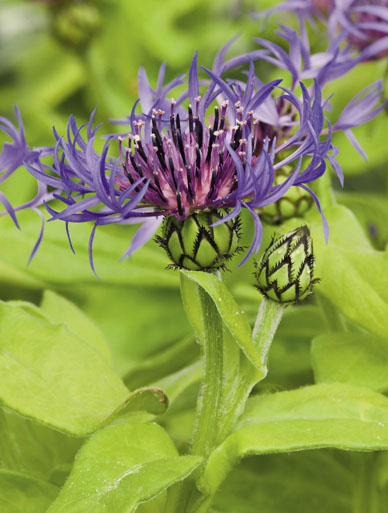
Centaurea montana ‘Gold Bullion’
Caprifoliaceae
Jupiter’s beard, valerian
Though this genus includes a dozen or so species, only Centranthus ruber is popular with gardeners. Easy to grow and extremely undemanding, Jupiter’s beard was a favorite of old-time cottage gardeners. It is an ideal beginner’s plant, very forgiving and flourishing even in poor, infertile, and droughty soils, and yet its rewards are sophisticated enough to please connoisseurs.
Jupiter’s beard prefers a slightly alkaline pH, but succeeds in any average, well-drained garden soil; its tolerance for drought makes this an excellent choice for xeriscapes and coastal gardens. Unless saving seed, remove fading flowers to promote a second flush of bloom; Jupiter’s beard tends to be short lived so it is wise to have replacement seedlings handy. Cut stems back to 6 in. in late summer to stimulate new vegetative growth for overwintering. Attractive to butterflies and bees; seldom browsed by deer, and mostly reported resistant to rabbits. A good groundcover for sunny banks; seeds itself into crevices between pavers or in walls. Commonly found seeded into the mortared walls of European castles and ruins.
A traditional choice for cottage gardens, Jupiter’s beard partners well with other alkaline-loving, old-fashioned flowers such as baby’s breath, pinks, and pin-cushion flower. Useful source of cut flowers.
Propagate by seed, by division of mature plants in early spring or fall, or by spring basal cuttings.
Centranthus ruber
syn. Valeriana rubra, V. coccinea
• red, pink, white
• late spring to late summer
• 1.5–3 ft. × 2–3 ft.
• sun, part shade
• Z5–8
Jupiter’s beard, fox’s brush, keys-of-heaven. Native of Europe, northern Africa, and the Middle East, this plant has naturalized in our Pacific Coast states, Arizona, Utah, and Hawaii. The fleshy leaves are bluish green and lance shaped, borne on ascending, often sprawling stems. Dense cymes of fragrant, small, star-shaped flowers.
‘Albus’ bears creamy-white flowers. Compact to 2 ft.
‘Atrococcineus’ flowers are deep brick red.
‘Coccineus’ has carmine flowers. To 2 ft.
‘Roseus’ has rosy-pink flowers.
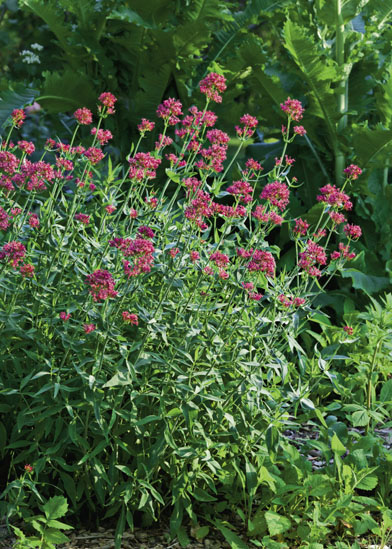
Centranthus ruber
Dipsacaceae
yellow scabious
Few plants have the combination of bulk and grace to furnish the back of large borders better than yellow scabious. If space allows, mass for dramatic effect as a summer hedge or naturalize informally in meadows and wildlife gardens where the flowers attract butterflies. An asset for cottage and cutting gardens if space permits.
Start new plants from seed (stratify to aid germination), or divide mature clumps in spring.
syn. C. tatarica
• yellow
• early to midsummer
• 5–6 ft. × 3–4 ft.
• sun
• Z3–8
Yellow scabious, Tatarian cephalaria, giant scabious. Caucasus Mountains to Siberia. Grows naturally in moist, sweet soils that seldom dry out. Best in sheltered, full-sun sites; even part shade encourages the stems to flop. Vigorous with large bushes of dark green foliage to about 5 ft. Individual leaves are deeply cleft and may reach 15 in. long. Slender, striped flower stems topped with 2.5-in.-wide, pale yellow flowers rise above the mass of foliage. The blooms, similar to related scabious, consist of countless four-parted florets, the outer ones are enlarged. Deadhead to encourage further bloom but leave the late heads for winter interest.
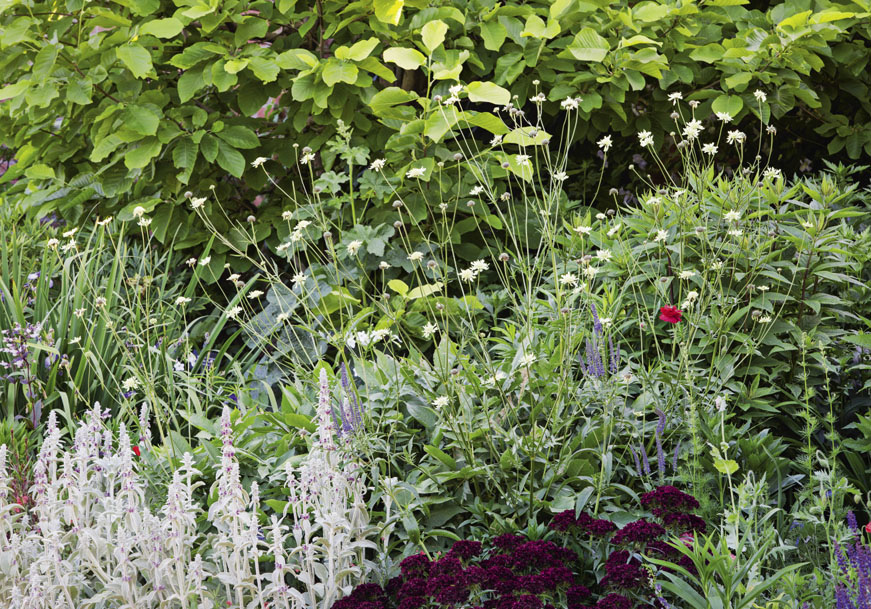
Cephalaria gigantea
Caryophyllaceae
snow-in-summer
Of this genus’s 100 species, only Cerastium tomentosum is of interest to perennial gardeners. Other species, including the similar Taurus cerastium, C. biebersteinii from the Crimean region, differ in a few minor botanical details and some authorities include them with C. tomentosum, as the C. tomentosum Group.
Snow-in-summer prefers full sun in the northern regions, but requires midday shade where sun is intense. High heat and humidity cause plants to melt out, or rot at the crown. Well-drained, average to poor soil is satisfactory; neutral to sweet soil is preferable, typical of many members of the Caryophyllaceae. Aggressive and may become invasive under good conditions, spreading quickly by underground stems. Shear after bloom time to prevent seeding. Pests and diseases are seldom a problem; deer and rabbit resistant.
Provides a restful foil for speedwells, bellflowers, and spurges. Good as a groundcover, especially in sandy coastal gardens, rock gardens, or rough, dry banks where it tolerates drought; ideal tumbling over rocks or walls. Eye-catching in winter gardens combined with purple-leaved bergenias.
Propagate by division in spring or fall, or direct sow seed in spring or sow indoors in fall before the last frost.
Cerastium tomentosum
• white
• late spring to early summer
• 6 in. × 12–24 in.
• sun
• Z3–7, HS
Snow-in-summer, mouse-ear chickweed. Italy. A well-grown patch of snow-in-summer is a cool delight to the eyes. The softly hairy, silver leaves, each less than 1 in. long, form dense mats that are topped with short-stemmed clusters of glistening white, starry flowers. Individual blooms have five petals, notched at the tips.
‘Columnae’ is somewhat more refined and is hardy to zone 8. Possibly tolerates light foot traffic. Avoid all but poor soils to maintain habit. ‘Silver Carpet’ is similar and may be a synonym.
‘Yo-Yo’ is a compact cultivar, better suited for growing in limited space such as containers, or crevices between rocks. Not as aggressive as the species.
Plumbaginaceae
leadwort, plumbago
Some flowers charm not through sheer brilliance but through their timing. The leadworts, for example, cannot rival such stars as summer phlox in brilliance of floral display, but they open their blossoms during the late summer lull when the garden needs them most. Commonly, they continue blooming well into the fall, when their small but abundant flowers make a piquant contrast to the red, orange, and yellow hues of autumn foliage.
Moderately moist, well-drained garden soils are ideal, but plumbagos also thrive on poor soils. Extra fertilizer is unnecessary; drought tolerant once established. Protect from intense sun in hot regions. Cut back to the ground to promote fresh, vigorous regrowth in early spring.
Attractive to butterflies, deer resistant, and generally trouble free, the cultivated species of Ceratostigma are as undemanding as they are rewarding.
Propagate by cuttings taken in spring or layer stems in fall.
Ceratostigma plumbaginoides
syn. Plumbago larpentiae
• blue
• midsummer to fall
• 9–12 in. × 12–18 in.
• sun, part shade
• Z5–9, HS
Blue leadwort, plumbago. Native to western China, this mat-forming, woody-based perennial spreads by rhizomes to form an attractive groundcover. Oval to obovate, shiny medium green leaves, 2–3.5 in. long, are bristly with wavy margins, and turn bronze-red in fall. Five-petaled flowers, to 0.75 in. across, cluster at the stem tips; spiky, red buds open to brilliant deep blue blossoms. Blue leadwort is outstanding as a groundcover, especially for slopes, with trees and shrubs, and in rock gardens. A perfect companion for spring bulbs: blue leadwort foliage emerges late as bulbs fade, camouflaging the bulbs’ ripening leaves. Prone to powdery mildew. Not suitable where summers are hot and humid.
Ceratostigma willmottianum
• blue
• late summer to fall
• 24–36 in. × 3–4 ft.
• sun, part shade
• Z6–9, HS
Chinese plumbago. China and Tibet. This woody perennial is shrubby in mild regions, but dies back in cold-winter regions. Lanceolate, green leaves, often edged with purple, turn red in autumn. Five-petaled, 1-in., cobalt-blue flowers borne abundantly in dense clusters at stem tips. Attractive as a color echo and foil with russet ornamental grasses; Chinese plumbago’s shrubby form hides the naked grass bases. Doesn’t thrive in the southern United States.
‘My Love’ has golden-yellow foliage.
Plantaginaceae
turtlehead
Never did a flower’s common name do it such a disservice. In fact, chelones bear only the most notional resemblance to a reptile’s head; instead, they rank among the most desirable, if underutilized, native North American wildflowers.
Chelones’ unusual blooms have an intriguing form, and their foliage is bold and handsome. They are undemanding and require only humus-rich, consistently moist, or even wet soil. Pinch back stem tips at 6–9 in. during spring to encourage bushy, compact growth and eliminate the need for staking. Mildew may be a problem where air circulation is poor.
Use versatile turtleheads to serve as focal points in shade or woodland gardens, moist meadows, bog gardens, and the edge of ponds or slow-moving streams. Their tolerance for wet feet equips them to be stars in rain gardens, although they are sufficiently refined to also hold their own in formal settings. Attractive to butterflies. Partner them with other damp-loving plants: ligularias, rose mallows, blue lobelia, and cardinal flower, for example.
Propagate by seed or division in spring or fall.
Chelone glabra
• white, pink
• midsummer to early fall
• 2–3 ft. × 1.5–2.5 ft.
• sun, part shade, shade
• Z3–8
Turtlehead, snakeshead. United States east of the Mississippi, except for Florida and Louisiana. Clump forming, with stiff, erect stems well clothed with dark green, coarsely toothed, lance-shaped leaves, 3–6 in. long. The 1.5-in.-long, white, sometimes pink-tinged flowers are hooded, two-lipped, and snapdragon-like, borne in tight, spike-like, terminal racemes.
This plant is the main larval food source of the lovely and rare Baltimore checkerspot butterfly. Deer often browse these plants.
Chelone lyonii
• pink, purple
• midsummer to early fall
• 2–4 ft. × 1.5–2.5 ft.
• sun, part shade
• Z4–8
Shellflower. Southeastern United States. Similar to Chelone glabra, except with ovate, 6- to 7-in. leaves and rose-pink flowers; in general it is somewhat bolder and taller. Shellflower spreads by rhizomes and may self-seed to form a colony. Keep soil moist with a shredded leaf mulch in sunny sites. Reputedly, deer avoid this species.
‘Hot Lips’ has blooms of a richer pink than the species, red stems and purple-green foliage.
Chelone obliqua
• purple, pink, white
• midsummer to early fall
• 2–3 ft. × 1–2 ft.
• sun, part shade
• Z4–9
Red turtlehead. Throughout the United States east of the Mississippi. Dark green leaves are coarsely toothed and lance shaped. Flower color is variable, though most commonly a rich rose to rosy purple. Seldom browsed by deer.
Crassulaceae
lamb’s tail
This genus is prized for its succulent evergreen mats of foliage and “lamb’s tails” of small, yellow flowers. Excellent in rock gardens or tucked into crevices between rocks or pavers, it is also useful as a neat groundcover, in raised beds, rock gardens, and containers with other succulents. A lovely and unusual companion for coral bells, rock cress, and creeping bellflowers.
Lamb’s tail prefers average, well-drained soil, and tolerates drought when established. Thrives in full sun in the Pacific Northwest but elsewhere is best protected from intense summer sun. Adapts poorly to heat with humidity. Slugs may be a problem.
Start seed indoors in spring. Mix the dust-like seeds with fine sand to simplify even distribution; do not cover. Germination takes one to two months. Propagate by division in early summer or take soft cuttings from side shoots in summer.
Chiastophyllum oppositifolium
syn. C. simplicifolium, Cotyledon simplicifolia
• yellow
• late spring
• 2–4 in. × 6 in.
• sun, part shade
• Z6–9
Yellow lamb’s tail, golden lamb’s tail, golden drop. Native to areas of limestone rocks in the Caucasus Mountains. Plants expand slowly by rhizomes, but do not become aggressive; basal rosettes of waxy, evergreen, rounded, succulent leaves, scalloped along the margins. In late spring flowering stems rise to 6–8 in., adorned with dangling chains of small, bright yellow bells. Cut back after bloom time.
‘Jim’s Pride’ (‘Frosted Jade’). Waxy foliage is gray green, edged and variegated with cream and pink tones in cold weather. Pale yellow flowers.
Asteraceae
chrysanthemum, mum
Cultivated chrysanthemums derive from an Asian tradition that focused on the development of spectacular blossoms, often at the expense of the vigor and hardiness of the plant. This trend has been perpetuated by many Western breeders who have created a wide variety of hybrids (often listed in catalogs as Chrysanthemum ×morifolium) whose magnificent blossoms make them the ultimate florist’s flowers, but which generally will not flourish outside a greenhouse. As a rule, the plants sold in bloom by retailers in the fall belong to this category and should be regarded as annuals. However, a handful of perceptive horticulturists have focused on developing garden-hardy types that integrate readily into beds and borders, and overwinter reliably outdoors throughout much of North America and elsewhere. Typically, plants of this category are available only by mail order.
Hardy chrysanthemums have the virtue of timeliness, bearing their flowers of golds, russets, oranges, reds, pinks, and white in late summer and fall when most other perennials are winding down. The foliage—typically rich green and deeply lobed—is attractive and, when well grown, chrysanthemums have a bushy form that makes them desirable garden elements even when not in flower. Although not long lived, hardy mums are easily propagated.
For best results, give garden chrysanthemums a spot with at least six hours of direct sun daily and a well-drained, organic-enriched soil. Because they are shallow rooted, chrysanthemums need regular irrigation during dry spells to keep the soil consistently moist—these plants will survive some drought but their bloom will be severely diminished. Avoid setting chrysanthemums near a strong night-time light source, including street lamps, as this can prevent them from setting flower buds.
An early to midspring planting is best, although container-grown hardy chrysanthemums can be planted successfully in early summer. To keep plants compact and maximize bloom, pinch off the tip of each shoot every two to three weeks from the time when new growth reaches 4–6 in. until early June. Deadhead for neatness in warm regions, where the foliage will remain green into winter. In colder climates, leave the fading flowers and withering stems intact to provide winter protection. Cover dormant plants with a protective winter mulch, such as evergreen boughs, where winters are cold.
Hardy chrysanthemums combine well with other fall bloomers such as sedums, goldenrods, and Russian sage, and provide an attractive counterpoint to the russet fall foliage of ornamental grasses. Little troubled by pests aside from occasional visits from slugs and infestations of aphids and mites. Susceptible to a variety of diseases, but usually only when plants are stressed by an overly shady spot or poorly drained soil.
Divide established plants every third year in spring to renew their vigor. Propagate by stem cuttings taken from new growth in mid- to late spring.
Chrysanthemum arcticum
syn. Arctanthemum arcticum
• white, pink
• late summer
• 10–16 in. × 12–24 in.
• sun
• Z4–9
Arctic daisy. Native throughout the northern parts of the Northern Hemisphere, including most of Canada and Alaska. Forms cushions of medium green leaves, wedge shaped, semi-pinnatifid with three to five lobes or teeth; daisy-like flowerheads with up to a diameter of 2 in. with yellow disk centers are solitary, but often borne in great profusion. Suitable for the border, rock garden, edging paths, or in mixed containers.
‘Red Chimo’ bears lavish crops of bright pink flowers. Continues to bloom even after light frost. Canadian bred.
• yellow, orange, pink, red, white
• late summer to late fall
• 30–36 in. × 36 in.
• sun, part shade
• Z4–9
Korean hybrids. Originals bred by Alex Cumming of Bristol Nurseries in Connecticut, from a plant collected in Korea, Chrysanthemum zawadskii var. sibiricum, which is also the principal parent of the rubellum hybrids. Korean hybrids were originally shorter and bushier than their ×rubellum relatives, with double, semi-double, or single, daisy-like flowers, although interbreeding has blurred the distinction.
NYBG Series. Bred at the New York Botanical Garden; large, single flowerheads in a range of colors. Excellent cut flowers. Selections include ‘Painted Lady’, ‘Cambodian Queen’, and ‘Arizona Sunset’.
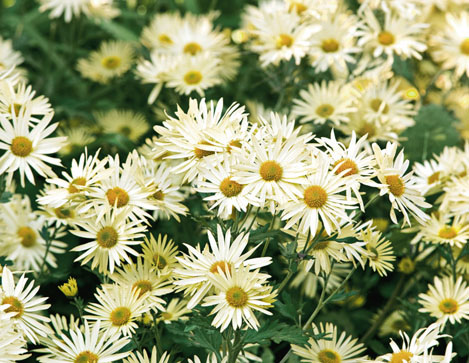
Chrysanthemum ×koreana ‘Painted Lady’
Chrysanthemum ×rubellum
• yellow, pink, red
• late summer to fall
• 24–36 in. high and wide
• sun, part shade
• Z5–9
Korean mum, rubellum hybrids. This is the other major group of hardy garden hybrids, bred in Britain during the late nineteenth and early twentieth centuries. Several excellent examples are still commercially available.
‘Clara Curtis’ has pink, single, daisy-like flowers, with a diameter of 3 in. More shade tolerant than most chrysanthemums. 18–24 in. × 18 in.
‘Emperor of China’ has double, rose-pink flowers in midfall; foliage turns mahogany-red as weather cools. 3–4 ft. × 1.5 ft. Z4–9.
‘Mary Stoker’ has single, apricot-yellow flowers in early fall. 24–30 in. × 16 in.
Chrysanthemum weyrichii
syn. Dendranthema zawadskii
• white, pink
• late summer to late fall
• 6–12 in. × 18–24 in.
• sun, part shade
• Z4–8
Miyabe. Native from northern Japan to Alaska. Mat forming with toothed leaves and single flowers with yellow centers to 2 in. across, borne on short stems. Equally at home in rock gardens or the front of borders.
‘Pink Bomb’ has pale pink flowers.
‘White Bomb’ has white flowers, dark green leaves, and purplish stems.
Chrysanthemum yezoense
syn. Dendranthema arcticum subsp. maekawanum
• white, purple
• early fall to late fall
• 3–8 in. × 2 ft.
• sun, part shade
• Z5–9
Groundcover chrysanthemum. Ground-hugging Japanese coastal native, spreads slowly by rhizomes to an indefinite width. Long-stalked, evergreen, lobed and toothed leaves. Abundant display of 2-in., white or purplish flowers. Drought tolerant; handsome additions to rock gardens or cascading down a bank.
Other Notable Cultivars
‘Autumn Moon’. Abundant 2.75-in., single flowers of pale yellow touched with pink. Late fall. 18–24 in. Z4–9.
‘Glowing Ember’ bears prolific crops of 2.5-in., semi-double, red flowers edged with gold. Late fall. 22–24 in. Z4–9.
‘Mei Kyo’ has small, double, lavender blooms in late fall; doesn’t require the regular division needed to reinvigorate many other chrysanthemums. 36 in. high and wide. Z4–9.
‘Ruby Mound’ has burgundy-centered, double, deep red flowers. 16–24 in. × 16 in. Z5–9.
‘Sheffield Pink’. Loose sprays of large, yellow-eyed, pale, single, salmon-pink flowers. Early to midfall. 24–36 in. high and wide. Z5–9.
‘Single Apricot Korean’ bears 2.5-in., pale apricot-pink flowers. Midfall. 2–3 ft. × 2 ft. Z4–9.
Asteraceae
goldenstar
This low, mat-forming native contributes a shot of bright early spring color to woodland gardens. Easy to grow, it spreads by leafy runners that create patches 2–3 ft. or so across. The leaves, 1–2 in. long and oval, are notched along their margins and are covered with soft hairs. Evergreen in mild climates. The single, 1-in.-wide daisy flowerheads consist of five showy golden ray flowers surrounding a central cluster of brownish stamens. Bloom time is long, especially in cool regions, and may last into summer with sporadic repeat bloom when nights become cool. Goldenstars are valued in the garden as groundcovers, especially in shaded places; in cool climates they tolerate sunny spots too. Soil must be well drained; enrich with organic matter to retain moisture. Goldenstars mix well with early spring bulbs including squills and mini-daffodils, and are good companions for ferns, wild blue phlox, may apples, polemonium, bleeding hearts, and other woodlanders. Pests and diseases are few; deer are seldom a problem.
Divide in spring, or start from seed.
Chrysogonum virginianum
• yellow
• early spring to summer
• 6–12 in. × 12 in.
• sun, part shade, shade
• Z5–9
Goldenstar, green-and-gold, gold star. Rich woodlands and open shade from Pennsylvania to Mississippi and Florida. A variable species. The type makes a thicker groundcover, spreading by underground stems. Flower stems are often branched, and lift the flowers well above the mat of leaves. Bloom extends into summer, especially in cool climates. Several named but similar cultivars are available.
‘Allen Bush’, a dense, fast grower to 8 in. Excellent along shaded pathways and as a groundcover.
var. australe spreads quickly by long aboveground runners that root at their tips. Flowering stems and bloom time are shorter than those of the species and the leaves are darker and glossier. Native to the southern part of the species’ range; may be more susceptible to cold, wet winters.
‘Eco Lacquered Spider’ has shiny purple-tinged foliage. Golden ray flowers are prominently notched or “pinked” at the tips. Rapid spreader by purplish runners that can reach 3–4 ft. annually. 4 in.
‘Norman Singer’s Form’ (‘Superstar’) is excellent in dry, partly shaded conditions. 4–6 in.
‘Pierre’ is more clumping and tolerates dryer soil conditions.
‘Quinn’s Gold’ produces yellow flowers that mature to light yellow and cream so that differently colored flowers decorate the plant at any one time.
‘Springbrook’ is the most compact cultivar. 5 in.
Asteraceae
golden aster
Got a dry, sunny spot beyond the reach of a hose? Golden asters are just the plants to fill it. These wonderful but underused plants are tough sun lovers that tolerate droughty conditions well and thrive on average or even poor soils, as long as they drain well.
The leaves of golden aster are borne alternately on stems crowned with clusters of bright yellow daisies, each about 1.5 in. across. Deadheading encourages further bloom. Cut down after hard frost but allow a few stems to self-seed and feed seed-eating birds. All species cited here are suitable for native plant, meadow, or wildlife gardens where they make good companions for purple and mauve asters, grasses, blazing stars, and other drought-tolerant wildflowers.
Nomenclature of this genus has been unsettled in recent years. Formerly classified as Chrysopsis villosa, hairy golden aster is now known as Heterotheca villosa. It grows to 5 ft. tall and is native to our western states; hardy in zones 3 to 8. Sickle-leaved golden aster, formerly known as C. falcata, is now classified as Pityopsis falcata. Native to coastal areas from Massachusetts to New Jersey, this last species doesn’t exceed a height of 1 ft. and is hardy in Z5–9. Both are found in catalogs under their old names as well as the new, so be forewarned.
These taprooted plants are best propagated by seed in containers and transplanted to the garden as seedlings. They self-seed on hospitable sites.
Chrysopsis mariana
syn. Heterotheca mariana
• yellow
• midsummer to midfall
• 1–2 ft. × 1.5 ft.
• sun, part shade
• Z5–9
Maryland golden aster, broad-leaved golden aster, shaggy golden aster. Open spaces and rocky woods in dry sandy soils from New York to Ohio, and south to Texas and Florida. Mounding clumps of erect silky stems are clothed with alternate, 6-in.-long, shiny, spatula-shaped leaves on short petioles. Branched stems are topped with golden, 1-in. flowerheads that crowd into tight showy clusters. They continue to bloom throughout hot weather. This species is the most drought tolerant of the clan.
Astereaceae
plumed thistle
Gardeners are far more accustomed to eradicating members of this genus than planting them, for the plumed thistles include 200 species and such wide-ranging noxious weeds as the bull thistle (Cirsium vulgare), native to Europe, Asia, and northern Africa, and the so-called Canada thistle (C. arvense), a native, despite its common name, of Europe and northern Asia. There is, however, a pair of Cirsium species that do make rewarding garden perennials. These attract butterflies and make striking cut flowers; seedheads provide food for finches and other seed-eating birds. Although their spiny foliage and stems makes plume thistles hard to handle even with gloves, you must protect them from deer and rabbits.
Propagate by seed, or by division of mature clumps in spring.
Cirsium occidentale
• crimson
• early to late spring
• 3–4 ft. × 2 ft.
• sun, part shade
• Z9–10
Cobweb thistle. Deserts, mountains, and valleys of California, into western Nevada, southern Oregon, and southwestern Idaho. White, spiny foliage and stems. The crimson thistle flowers perch on spiny, globular, white bases wrapped in a cobweb-like net of hairs. Drought tolerant; not invasive. This hummingbird favorite may self-seed sparingly.
Cirsium rivulare
• pink-purple
• early summer to early fall
• 36–48 in. × 18–24 in.
• sun
• Z4–9
Brook thistle. Native to southern and central Europe, available only as the cultivar ‘Atropurpureum’. This statuesque selection bears densely packed, dark crimson flowers on upright, branched, leafless stems. The prickly leaves—narrow and jaggedly scalloped along the edges—form a new rosette each year, making a slowly spreading colony. Requires a consistently moist soil. For drama, partner with other purple-flowered perennials with a similar bloom time such as Papaver orientale ‘Patty’s Plum’, or contrast it with Pennisetum setaceum ‘Rubrum’ or other red-hued grasses.
Montiaceae
spring beauty
Most spring beauties are native to North America, though they also range south into Central America and across the Bering Straits into northeast Asia. Indigenous peoples valued these plants for their starchy, chestnut-like corms and edible, succulent greens. Contemporary gardeners seldom grow them outside of native plant or wild gardens despite their lovely delicate blooms and vigorous trouble-free nature. Only two species, Claytonia virginica and C. sibirica, are in cultivation and no cultivars or selections of either are presently available in the nursery trade.
Both species are woodland natives that prefer an organic-rich, moist but well-drained soil. In a hospitable site, both will spread, eventually forming a solid, often extensive groundcover. But whereas C. sibirica’s coverage lasts through the gardening season, that of C. virginica is more seasonal; this species is a spring ephemeral and goes dormant with the onset of summer heat. This makes it unsuitable for formal displays in beds and borders, where the sudden disappearance of a groundcover leaves an obvious gap. Claytonia sibirica, however, is useful in such a setting, due to its adaptability in a wide range of exposures. In general, the fragile delicacy of spring beauties makes them best suited for woodland gardens, rock gardens, and meadows, where larger, bolder neighbors won’t outshine them.
Propagate by seed sown in fall and overwintered outdoors in a cold frame or protected spot. Clumps of C. virginica may also be divided in spring after flowering is finished and before the plant retreats underground.
Claytonia sibirica
syn. Montia sibirica
• pink-and-white
• early to late spring
• 12–18 in. × 12 in.
• sun, part shade, shade
• Z4–10
Peppermint candy flower. West Coast from southern California, north through coastal Alaska. Short-lived perennial best adapted to shady sites, although it also flourishes in full sun if the soil remains consistently moist. Individual plants form rosettes of fleshy stems with broadly lanceolate leaves borne in opposing pairs. The five-petaled, candy-striped, pink-and-white flowers measure no more than 0.75 in. across but make up in quantity what they lack in size. Blooms over a long season, sporadically through summer and even into fall in temperate locations. Individual plants rarely survive more than three years but reseed freely, typically forming a self-perpetuating colony.
Claytonia virginica
• pink, white
• late winter to midspring
• 6–9 in. high and wide
• sun, part shade
• Z3–8
Spring beauty. Rich, moist woodlands, valleys, and prairies throughout the eastern half of North America, except Florida. Narrow, grass-like leaves usually grow in pairs; the star-shaped flowers have five pink-veined, white or light pink petals, and are borne atop slender, 4- to 6-in. stems, usually as soon as the weather moderates at winter’s end. The foliage persists for some weeks past bloom time, but retreats back to the fleshy roots with the onset of hot weather.
Performs best in a moist, rich soil. Reseeds and spreads vigorously, so best planted in a spot that can accommodate this trait and where it won’t overrun herbaceous neighbors. It naturalizes well in a lawn combining well with other early-blooming bulbs, such as crocuses and squills, for a charming spring tapestry.
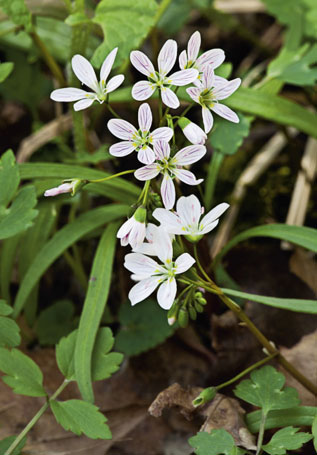
Claytonia virginica
Ranunculaceae
clematis
Mention clematis and most gardeners think of tall vines sporting large open flowers in bright jewel tones, or clouds of small, white blossoms enveloping arbors. But there are also several non-climbing, upright weavers or sprawling species that deserve a place among herbaceous perennials. The weavers bring a sense of random informality in otherwise orderly beds; the sprawlers, supported by small shrubs, pea sticks, or rustic tepees, provide height in midborder.
Clematis have opposite leaves that are generally compound and composed of several leaflets. Instead of petals, flowers have four or five petaloid (petal-like) sepals that surround a central cluster or boss of yellow or white stamens. Some produce interesting plumed fruits. In chilly climates clematis do best in sun, but where sun is more intense they prefer lightly shaded spots. Averse to drought, they require evenly moist, average to rich soil, ideally amended with compost, and should never dry out. Stake as necessary. Blooms are borne on new growth; prune hard in spring. Slugs may damage young foliage; deer are seldom a problem. Clematis wilt is not as widespread on the herbaceous species as on the vining types, but gardeners should watch for the symptoms.
Propagate by cuttings taken from new shoots emerging from the base of the plant in spring, or by seed sown outdoors in fall, or stratified and sown indoors in containers in spring. Dividing non-climbing clematis is possible but risky, and best accomplished in late winter or early spring while the plant is still dormant.
Clematis heracleifolia
• blue
• late summer
• 2–3 ft. × 4 ft.
• sun, part shade
• Z3–7
Tube clematis, shrubby clematis, bush clematis. China. Tubular, variably fragrant, light blue flowers about 0.5 in. long are borne in dense clusters at the stem tips and leaf axils and are quite showy. Tips of the sepals reflex backward as with hyacinths. Bloom is more abundant in full sun, but the roots need cool, evenly moist conditions; mulch in spring. Large, three-parted leaves, with a larger middle leaflet. Mostly upright and bushy; plants can be staked if preferred. Attracts bees and butterflies. Tolerates deer and the toxic roots of black walnut trees. Rabbits dine on the young growth. Plants are reportedly poisonous. Most named selections are actually hybrids with other species.
‘Blue Mood’ is best planted among low shrubs such as fothergilla, bush cinquefoil, and Russian sage for support. True blue flowers. Z5–9.
‘China Purple’ has clusters of small, violet-blue flowers. Prefers full sun. 2 ft. Z5–9.
‘Mrs. Robert Brydon’ (Clematis tubulosa × C. virginiana) is a hybrid with bold dark leaves and a multitude of hyacinth-like, pale blue flowers. Excellent as a groundcover to suppress weeds.
‘Rosea’ has fragrant, pink flowers similar to the species.
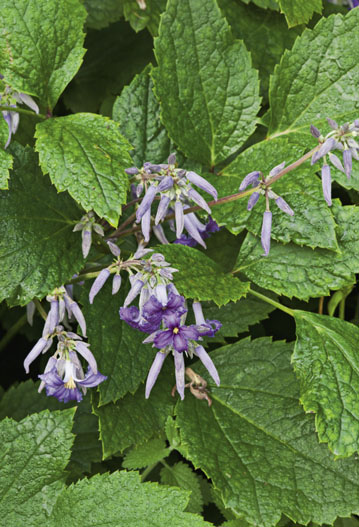
Clematis heracleifolia
Clematis integrifolia
• blue
• summer
• 1.5–3 ft. × 4 ft.
• sun, part shade, shade
• Z3–8
Solitary clematis. Southern Europe. Solitary, 2-in., nodding, blue-lavender flowers, each with four twisted sepals borne at the tips of wiry stems; attractive heads of silvery seeds follow. Pairs of dark green, lance-shaped leaves sparsely clothe the stems. This sprawling species is excellent in beds and borders where it benefits from being staked with twiggy branches or pea sticks. In cottage and meadow gardens allow it to ramble through other plants. Stems are less robust in shaded sites. Hardy geraniums, meadow sages, ornamental onions, and coreopsis are good companions.
‘Hendersonii’, often listed as a cultivar of solitary clematis but in fact a hybrid (Clematis integrifolia × C. viticella), is larger flowered and indigo-blue. Long blooming.
‘Rooguchi’ is a lax climber with non-woody stems. Fleshy plum-colored bell flowers.
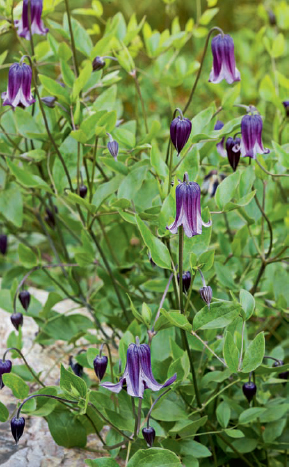
Clematis integrifolia ‘Rooguchi’
Clematis recta
• white
• late spring to summer
• 2–4 ft. × 2.5 ft.
• sun, part shade, shade
• Z3–9
Ground clematis. Native to southern Europe. Scrambling or more erect, with up to nine pointed, oval leaflets per leaf. Silvery seedheads follow frothy clouds of fragrant, 1-in., starry, white flowers borne in large clusters. Provide obelisks, tepees, or other structures for support or plant alongside low shrubs through which the plants can ramble. Ground clematis may be confused with similar but vining sweet autumn clematis (Clematis terniflora).
‘Purpurea’ displays bronzy purple foliage. Variable; select a well-colored form.
‘Purpurea Select’ has more intensely purple foliage; best in full sun.
Clematis tubulosa
syn. C. tubulosa var. davidiana, C. heracleifolia var. davidiana
• blue
• midsummer
• 4 ft. high and wide
• sun, part shade
• Z3–7
Tube clematis. Central and northern China. Dense clusters of very fragrant, open, violet flowers that bloom a little earlier than most clematis. Leaves are also fragrant.
‘Wyevale’ is clump forming with fragrant, reflexed, mid-blue flowers. Attractive fluffy seedheads follow. Some authorities consider this to be a hybrid; others, a selection of Clematis heracleifolia.
Liliaceae
clintonia
Native to rich woods of the eastern United States, clintonias (also known as “Clinton’s lilies”) are increasingly difficult to find in the wild and should never be collected for transfer to the garden—look for them at native plant nurseries. The genus is named after New York’s Governor DeWitt Clinton, a key promoter of the Erie Canal and keen amateur naturalist.
Clintonias do best in moisture-retaining, rich to average, acid, damp soil. Amend with plenty of compost or rotted leaves, and apply a mulch of rotted leaves in summer to moderate soil temperatures. These delightful natives thrive in woodland gardens.
Young growth is a magnet for slugs and snails. Rust can also be a problem.
Clean and sow fresh seed in containers in fall; overwinter in a cold frame. Divide established plants in spring; recovery and reestablishment may be tediously slow.
Clintonia borealis
• yellow
• spring to midsummer
• 9–15 in. × 12 in.
• part shade, shade
• Z2–7
Blue-bead-lily, dogberry, snakeberry. Woodlands of eastern North America. Rhizomatous; produces two to four glossy, slightly succulent, light green leaves, 4–12 in. in length, with a conspicuously depressed central vein. Leaves clasp the stem, and curve outward. Open, bell-shaped, six-petaled flowers, each 0.5–0.75 in. across and with prominent stamens like sparklers, are borne in umbels; somewhat drooping blooms are a delicate greenish yellow. Shiny blue berries follow. Very slow growing; protect from deer.
Clintonia umbellulata
• white
• midspring
• 9–12 in. × 12 in.
• part shade, shade
• Z4–7
Speckled wood lily, Clinton’s lily. Mountains of New York to Ohio, south to Georgia and Tennessee. Foliage of this species is very similar to that of Clintonia borealis, although not quite as tall. Tiny, white, starry flowers, sometimes green and purple dotted, cluster atop scapes in rounded umbels of five to thirty blooms, 6–10 in. above the leaves. Round, black berries, appreciated by wildlife, follow. Deer reportedly ignore this plant, but it is prudent to take precautions anyway. Easier to cultivate than C. borealis.
Campanulaceae
bonnet bellflower
Herbalists have used these Asian relatives of campanulas to treat everything from memory loss to hypertension, but in the garden it is the exquisite beauty of the bell-shaped blossoms that earns them a place. Display these plants where the fine detail of the flowers’ interiors can be appreciated. However, keep them away from paths or steps as the oval to lanceolate leaves emit a strong odor when bruised.
Humus-rich, moisture-retentive soil and full sun or light shade are ideal for these plants. Mulch in late fall where winters are cold to keep the plants from breaking dormancy early; the soft new growth is vulnerable to sharp winds and late frosts. These are twining, sprawling plants that, when not cascading, show to best advantage staked with twiggy branches or pea sticks, or where they can clamber up through small shrubs. Slugs, snails, and rabbits relish codonopsis, though the strong-smelling foliage deters deer.
Propagate by seed sown in spring or fall.
Codonopsis clematidea
• blue
• late summer
• 2–3 ft. × 2 ft.
• sun, part shade
• Z4–9
Asian bellflower. Rocky slopes of eastern Asia. This pubescent, delicate-looking, sprawling semi-vine is splendid for trailing over rocks and walls, especially where the intricate markings within the pendent blossoms can be appreciated from a lower vantage. Milky white tinged with blue, the solitary, 1-in. bells are etched within with yellow, blue, and black. Branched stems bear alternate, pointed, gray-green leaves about 1 in. long. Easy to grow and deserving of wider usage. Kashmir bellflower (Codonopsis ovata) is similar but not as easy to grow.
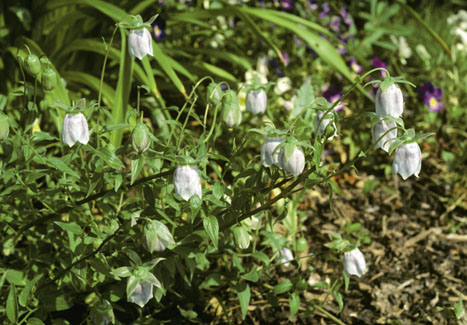
Codonopsis clematidea
Araceae
elephant ear
The flowers are modest, with the hooded spathe and spadix blossoms typical of members of the aroid family. But colocasia leaves live up to the common name: they can be every bit as large as an elephant’s ear. Foliage colors include near-black purples and chartreuses as well as green, and variegations in a host of patterns with black, silver, and gold veining, marbling, and splashes. Shade tolerant and fast growing, elephant ears invite flamboyance, turning a container into a statement, or a shady border into a tropical fantasy.
Such assertive foliage overwhelms understated partners, so match colocasias with hot reds, oranges, and yellows. Indeed, hues that would seem lurid or extravagant in other surroundings look perfect in such an association. The orange- and green-striped leaves of canna ‘Phasion’, for instance, look only exotic, not gaudy, when stirred into a pot of green-leaved Colocasia esculenta. Likewise, a knot of white-flowered calla lilies makes a most elegant counterpoint to the black-leaved C. esculenta ‘Black Magic’.
The stoloniferous or rhizomatous roots, or corms of elephant ears tolerate ordinary garden soils if well irrigated, but grow most vigorously in organic-rich, moist, even wet ones. They flourish in semi-shade and shade, but tolerate full sun (except in hot, dry regions) if their roots remain moist.
These tropical plants can be surprisingly cold tolerant; some cultivars are reported to overwinter outdoors in zones 7 or 6 if the crowns are buried a foot deep with shredded leaves after the first killing frost. Alternatively, dig roots and overwinter indoors in moist peat moss or perlite. Move container plantings into a sunny, frost-free spot such as a sunroom or conservatory; water sparingly.
Propagate by fresh seed sown on moist, soil-less mix. Propagate named cultivars by division, by removing and replanting offsets from the corms, or from new clumps sprouted at the ends of stolons.
Colocasia esculenta
• yellow
• summer
• 2.5–5 ft. high and wide
• sun, part shade, shade
• Z8–11
Taro. Native to southeast Asia but distributed globally as a starchy food crop and widely naturalized in tropical and subtropical regions; an invasive weed in Florida. Tiny, yellow flowers and heart-shaped leaves to 3.5 ft. long and 2.5 ft. wide. Many ornamental cultivars, some reputedly hardy in mild parts of zone 7.
var. antiquorum ‘Illustris’ is compact, to 30 in.; black leaves with contrasting green veins. Z7–10.
‘Black Magic’ bears dusky purple-black leaves to 2 ft. long.
‘Mojito’ has medium green leaves flecked with dark purple. Z7.
‘Pineapple Princess’ forms a low 3 × 5 ft. clump of 18-in., matte gray-lavender leaves, each highlighted by dramatic purple veins. Flowers have a fruity scent. Z7.
‘Tea Cup’ has upright, bright green leaves that curve into a teacup shape. Dark purple stems and leaf veins. To 6 ft.
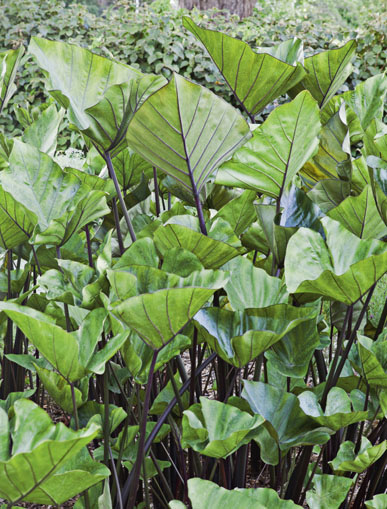
Colocasia esculenta ‘Tea Cup’
Colocasia fallax
• yellow
• summer
• 18 in. × 24 in.
• sun, part shade, shade
• Z7–10
Taro, silver-leaf elephant ears. Thailand and Vietnam. Dwarf with green leaves accented by a central silver midrib radiating silver veins. Small, yellow spathe-and-spadix flowers borne all summer long. Spreads vigorously by short, aboveground stolons on moist soils. Winter hardy into the warmer portions of zone 7.
Colocasia gigantea
• white
• summer
• 8–10 ft. high and wide
• sun, part shade, shade
• Z7–10
Giant elephant ear. Available chiefly as the Thailand Giant strain, this southeast Asian species is fast growing, producing leaves that may reach 5 ft. long and 4 ft. wide. These are an attractive glaucous-gray. Unlike most colocasias, the flowers of this species, though not in scale with the leaves, are large, sweetly scented, and borne in clusters.
Commelinaceae
day flower, widow’s tears
This large genus includes some notable weeds, such as Commelina benghalensis that is included in the federal noxious weeds list, but also a few garden-worthy perennials, mostly useful as groundcovers for sunny or partly shaded areas. Day flowers may be tuberous or fibrous rooted and mostly hail from tropical and subtropical forests where they inhabit the forest floor. They are easily grown—in some cases too easily—in dry or moist soil. Propagate by seed sown in spring or division in spring.
Commelina tuberosa
syn. C. coelestis
• blue
• late summer to midfall
• 1.5 ft. high and wide
• sun
• Z8–11
Blue spiderwort, Mexican dayflower. Mexico. This tender perennial grows from tuberous roots that can be lifted and stored in cold winters; it may also be grown as an annual in cold-winter regions. The dark, clear blue of the 1-in. flowers is the main attraction and although each blossom lasts only a single day, the bloom period is long, continuing well into fall. Flowers are similar to those of related Tradescantia but feature two large petals and one smaller one. Clusters of buds emerge one at a time from a sheathing bract. Clumps of erect, rather succulent, jointed stems root at the nodes and carry shiny, 6- to 7-in., lance-shaped leaves. Valuable as a camouflage plant for dying bulb foliage, or to fill holes left by bleeding hearts or Oriental poppies that have died back. May seed about.
Lamiaceae
wild rosemary
The aromatic wild rosemarys are principally natives of southern United States. They have been used as a substitute for true rosemary in cooking, but harvesting from wild plants is discouraged as all seven species of Conradina are rare and threatened or endangered in the wild. Instead, raise your own supply of these low, shrubby plants with juniper-like, evergreen, gray-green needles. The two-lipped flowers, in contrast, more resemble mints.
Provide wild rosemarys with a very free-draining, poor, sandy, acid soil; they will even grow in deep pure sand. Root rot may be a problem in heavier soils. Tolerates heat and humidity well. Shear back lightly after bloom time. Best planted or transplanted in spring and watered sparingly until established.
Propagate by seed, by softwood cuttings taken during the growing season, or by division of mature clumps in autumn.
Conradina canescens
• lavender
• midspring
• 1–2 ft. × 2 ft.
• sun
• Z7–10, HT
False rosemary, gray-leaved conradina. Pine barrens of coastal Alabama and Florida. Wiry, branching, upright stems clothed with whorls of fuzzy, rosemary-like leaves. Lavender flowers.
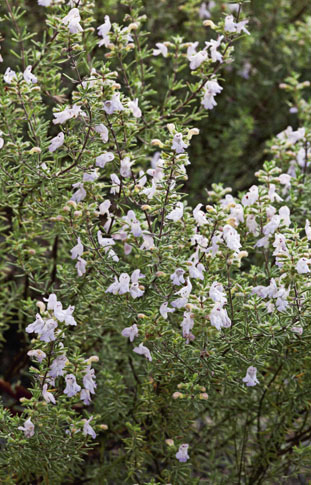
Conradina canescens
Conradina verticillata
• lavender
• summer
• 12–15 in. × 36 in.
• sun
• Z5–8, HT
Cumberland rosemary, wild rosemary. Sandbars along the Cumberland River and its tributaries in Kentucky and Tennessee. This low, bristly plant bears clusters of rosemary-like needle leaves on peeling reddish stems. Abundant displays of two-lipped, 0.5-in., lavender-pink flowers appear in summer, with the blossoms borne singly or in small clusters in the leaf axils. Lovely in containers, along a path or retaining wall, or in rock gardens where the fragrant foliage may be bruised by passersby.
‘Snowflake’ is white flowered. ‘Cumberland Snow’ is also white flowered, possibly identical.
Asparagaceae
lily-of-the-valley
Cherished for its delicious perfume—“Muguet de Bois”—lily-of-the-valley is an old-fashioned flower that remains a fine, if somewhat invasive, garden plant. Its expansive tendencies can be a virtue, for it makes an outstanding groundcover in cool, shady gardens, where its dense system of rhizomes suppresses weeds efficiently. In milder regions this plant is not as aggressive and may even struggle to bloom well.
Best grown in partial or full shade, in moist, fertile, well-drained soil. In cooler zones, lily-of-the-valley tolerates full sun if given midday shade. Plant the roots about 0.75 in. below soil surface with growing tips (pips) sticking through. Deer resistant. All parts of the plant are poisonous to humans (some advise wearing gloves while handling), but for centuries it has been used as a medicinal herb to treat heart problems, and the flowers are collected for posies and for their fragrant oils.
Lily-of-the-valley is excellent under tall trees, in shrub borders, or in fragrance and cutting gardens. Combine with spring bulbs, ferns, hellebores, or bold-leaved hostas. Avoid pairing with coral bells or other plants that could be swamped by the aggressive roots. Grow in containers to force early bloom indoors.
Propagate by seed (plants produce pea-sized, orange-red berries after bloom) in spring, or divide the roots in fall.
Convallaria majalis
• white
• spring
• 8–12 in. × 24 in.
• sun, part shade, shade
• Z2–7
Lily-of-the-valley. Northern temperate regions worldwide. Creeping rhizomes produce pairs of smooth basal leaves to 8 in. long. These are broadly oval on short petioles. Bell-like, 0.25-in. flowers, each on a short stem, are arranged along one side of smooth, arching stems. The cultivars tend to be less invasive than the species.
‘Albostriata’ has foliage beautifully striped longitudinally with creamy white.
‘Flore-Plena’ (‘Pleniflora’) has double flowers that persist longer than usual.
‘Fortin’s Giant’ is vigorous with wider leaves and large flowers.
‘Hardwick Hall’ has foliage rimmed with yellow.
‘Rosea’ has pale pink flowers.
Convolvulaceae
morning glory, bindweed
This genus is commonly overshadowed by Ipomoea, a related genus of showy-flowered annual vines that are also called morning glories. More often than not, the only Convolvulus that gardeners are likely to recognize is field bindweed, C. arvensis, an aggressive, troublesome, and invasive vine of European origin. Three species of Convolvulus, however, perform as more mannerly—though short lived—perennials that thrive in the milder regions of the United States and elsewhere. All offer appealing flower and foliage effects. The funnel-form flowers attract hummingbirds and a variety of butterflies. Convolvulus cneorum and C. sabatius are notably drought tolerant, fine additions to xeriscapes or water-conserving gardens.
Propagate by seed (scarified and soaked in water overnight) sown in spring or by softwood cuttings of young growth taken in late spring to early summer. Morning glory seeds are toxic; take care not to ingest them.
Convolvulus cneorum
• white
• late spring to early fall
• 2–3 ft. × 2–4 ft.
• sun
• Z8–10, HS
Bush morning glory, silverbush. Limestone hills in southern Europe. A woody perennial or subshrub with evergreen, lanceolate leaves, 1–2.5 in. long and 0.5–0.75 in. wide, that are covered with silky, gray hairs. In a sunny spot and trimmed annually in early spring, this plant makes a handsome, dense, and silvery mound; in partially shaded locations, Convolvulus cneorum tends to sprawl. Pink buds open into 1-in.-wide, white trumpets, centered with yellow. Requires a well-drained soil, prefers an alkaline pH, and tolerates sandy, nutrient-poor ones. Thanks to its reflective foliage, this species tolerates considerable dry heat, but not high humidity. Bush morning glory works well in rock gardens, containers, in the foreground of xeriscape plantings, and other exposed locations. Appropriate drought-tolerant companions include agastaches, prairie zinnias, and succulents.
‘Snow Angel’ has pink-flushed, white flowers on compact plants. Z7.
Convolvulus sabatius
syn. C. mauritanicus
• blue
• spring to fall
• 6–12 in. × 18–36 in.
• sun, part shade
• Z8–10, HS
Blue rock bindweed, ground morning glory. Italy and northern Africa. This trailing plant bears small, rounded, light gray-green, hairy leaves and light blue, funnel-shaped flowers. Sometimes requires periodic irrigation in arid climates. Excellent for rock gardens or edging, it also works well spilling over the edge of containers, window boxes, and hanging baskets. Prefers well-drained soils, tolerates a range of pH. Prune back stem tips at the beginning of the growing season to encourage new growth and more abundant bloom.
‘Moroccan Beauty’ (‘Blue Casbah’) forms a low blanket of silvery foliage with lavender flowers. 1–3 in. × 12–14 in.
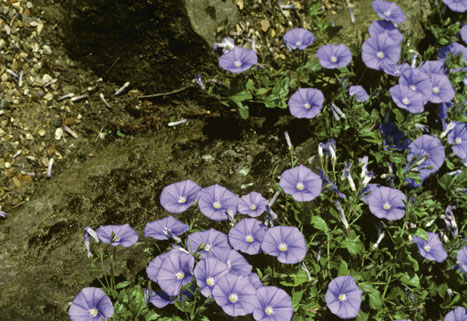
Convolvulus sabatius
Convolvulus tricolor
• blue, white, yellow, pink
• early summer to early fall
• 10–14 in. × 12–18 in.
• sun
• Z9–11
Dwarf morning glory. Mediterranean native commonly grown as an annual but perennial in mild-winter regions. It quickly forms a mound of stalkless, oval to elliptic, matte green leaves that bears a wealth of funnel-shaped flowers to 2.5 in. across. The blossoms are, as the species name suggests, typically tricolored; the wild type has a circle of blue surrounding one of white and a central eye of yellow, but horticultural cultivars offer other colors as well. Thrives in a range of moderately fertile, well-drained soils. Tolerant of heat and dry weather, dwarf morning glory is a colorful groundcover for sunny banks and rock gardens, an abundant source of color spilling over a retaining wall, edging a mixed border, or in containers and hanging baskets. Short lived but self-sows.
Enchantment Series offers compact selections with flowers in shades of blue, pink, red, white, and yellow. 16 in. × 12 in.
Ensign Series is a seed strain that includes ‘Blue Ensign’ (indigo blue with a white band and yellow eye), ‘Red Ensign’ (carmine red, white band, yellow eye), ‘Rose Ensign’ (rings of light pink, darker pink, and white ring, with a yellow eye), and ‘White Ensign’ (with a yellow eye).
‘Light Blue Flash’ has flowers of sky blue, white, and yellow
Asteraceae
tickseed
Despite its unappealing common name, this genus has become a perennial garden standby, an easy-to-grow group of plants that tolerates a range of soils and climates and bears colorful, showy daisy blossoms through a prolonged season of bloom. Heights vary considerably: some may reach 4 ft. tall and are useful for the back of a border or for interplanting with ornamental grasses; others are mounded and more compact at 18–30 in., ideal for midborder; still others top out at 12–15 in. tall and are perfect for containers or for edging. Most species are native to North America. They attract pollinating insects and butterflies and resist deer browsing. Most also tolerate dry soils and hot, sun-drenched sites, though in droughty situations irrigation helps to increase and prolong bloom.
Coreopsis flowers are daisy-like, 1.5–2.5 in. or more across, and are commonly colored in warm hues of yellow and red, though pinks and whites are increasingly available. The leaves are lance shaped, oval, or thread-like; the small, flat seeds do indeed resemble ticks.
Many of the species and older cultivars are relatively short lived, flourishing for just a few years before succumbing to old age. This, however, is less of a problem than it might seem, as tickseeds commonly self-sow in hospitable sites, providing their own replacements. Newer hybrids—of which there are a host—are generally less fertile and persist longer.
Full sun and well-drained soil are essential for most tickseeds, though some types tolerate partial shade. They partner well with other drought-tolerant sun lovers such as salvias, yarrows, and daylilies, and with other grassland natives including echinaceas, baptisias, and the shorter native warm-season grasses. Tickseeds are naturals for native plant and butterfly gardens, meadow plantings, and cottage gardens; they furnish outstanding cut flowers.
Stake taller types with cut brush or pea sticks to prevent sprawl, and deadhead fading flowers to prolong bloom. Cut stems back by half after the first flush of bloom to encourage rebloom. Be sparing with fertilizer; to maintain vigor divide mature plants every few years in spring as new growth begins. Tickseeds are susceptible to powdery mildew—in cooler climates where this might be a problem, choose resistant cultivars.
Propagate by seed, or division in spring, or by basal softwood cuttings.
Coreopsis auriculata
• yellow
• midspring to summer
• 12–36 in. high and wide
• sun, part shade
• Z4–9
Mouse-ear tickseed, lobed tickseed. Woodland edges and openings throughout the southeastern United States. This hardy, low-growing species bears small, hairy, lobed leaves in lush basal rosettes and along stems; in mild climates the foliage persists through most of the winter. The 1- to 2-in. flowers are bright yellow, and appear through early summer and then sparsely until frost.
‘Nana’ is dwarf, forming a mat of foliage with bright yellow flowers. 2–4 in.
‘Snowberry’ is more cold tolerant than the species. It has creamy-white flowers with burgundy-red centers. 32 in. × 24 in. Z3–8.
Coreopsis grandiflora
• yellow
• late spring to early fall
• 1–3 ft. × 2–3 ft.
• summer
• Z4–9, HT
Bigflower tickseed. Meadows, grasslands, and roadsides throughout eastern North America and in the south as far west as New Mexico, and California. A short-lived perennial that reseeds to provide its own replacements. Spatulate to lanceolate leaves; lower basal leaves are mostly entire, smaller stem leaves are often pinnately lobed. Flowers are solitary; deadheading is essential to prolong season of bloom and control prolific reseeding. Thrives in a range of well-drained soils, including poor, sandy, or rocky ones. Tolerant of heat, humidity, and drought; resistant to rabbits and deer.
‘Domino’ bears single, 2-in., yellow daisies with maroon centers. Comes true from seed.
‘Early Sunrise’ bears semi-double, 2-in.-wide, bright yellow flowers. 18–24 in. high and wide.

Coreopsis grandiflora ‘Early Sunrise’
‘Sunray’ produces prolific crops of large, bright yellow, double and semi-double flowers on 18-in. plants. Hardy to zone 3.
Coreopsis lanceolata
• yellow
• midspring to early summer
• 1–2 ft. × 1.5–2 ft.
• sun
• Z4–9
Lanceleaf coreopsis. Longer lived but similar to the preceding species. Prairies, fields, and roadsides in central and southeastern United States; another tough, drought- and heat-tolerant species that flourishes on poor and rocky, well-drained soils. The 1- to 2-in., composite flowers have eight petal-like rays, toothed at the tips, borne singly atop slender erect stems. Self-seeds prolifically and can be a nuisance in formal settings; reserve for wild, native, and meadow gardens where it forms large, showy colonies. Conscientious deadheading prolongs bloom time.
‘Baby Sun’ has golden-yellow blooms. To 1.5 ft.
‘Brown Eyes’ has golden daisies marked with maroon-brown centers. To 2 ft.
‘Double Sunburst’ has semi-double, golden-yellow flowers with prominent centers. Comes true from seed. To 1.5 ft.
‘Goldfink’ is compact, to 10 in.; single, golden-yellow blooms.
‘Sterntaler’ produces double, golden blooms marked with showy brown centers. 1–1.5 ft.
Coreopsis rosea
• pink
• early summer to early fall
• 1–2 ft. × 1.5–2.5 ft.
• sun
• Z3–8, HS
Pink tickseed. Nova Scotia to Maryland; requires a consistently moist but well-drained soil. This rhizomatous perennial forms dense, bushy clumps. Light green, grassy, linear leaves are borne in whorls, giving the plants an attractive, airy texture. Daisy-like, 0.5- to 1-in. flowers have toothless pink rays and yellow central disks. They are borne profusely and singly on short stalks for a lengthy bloom time. Does not tolerate heat and humidity well. Winter hardiness is sometimes a problem in cold-winter regions.
‘American Dream’ bears abundant 1-in., golden-centered pink flowers on compact 18-in. plants.
‘Heaven’s Gate’ has yellow-centered, pink flowers with a purple eye.
‘Sweet Dreams’ bears yellow-centered, white flowers with a raspberry eye.
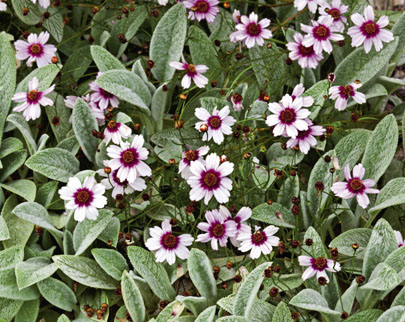
Coreopsis rosea ‘Sweet Dreams’ nestles among lamb’s ears
Coreopsis verticillata
• yellow
• late spring to late summer
• 1–3 ft. high and wide
• sun
• Z3–9
Threadleaf coreopsis, whorled tickseed. Eastern North America. Another heat- and drought-tolerant species that flourishes even on poor, rocky soils. The dark green, thread-like leaves provide a beautiful setting for bright yellow, daisy-like flowers borne singly in loose clusters. It spreads by rhizomes as well as seed and sometimes can be aggressive.
‘Moonbeam’ is compact, with creamy-yellow, golden-centered, 1- to 2-in. flowers. These are sterile, eliminating the threat of reseeding, thus making this cultivar a superior choice for borders and beds. Deadheading is tedious but extends bloom time. Demands full sun. To 2 ft.
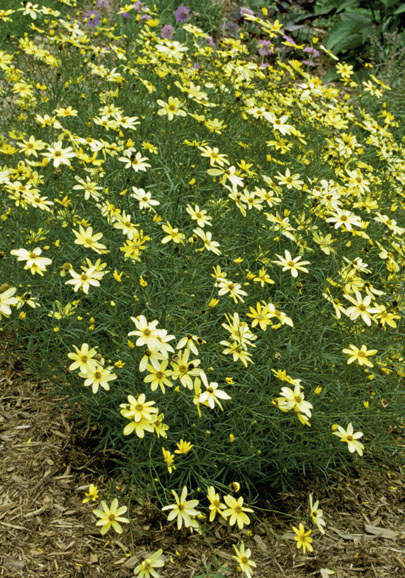
Coreopsis verticillata ‘Moonbeam’
‘Zagreb’ is more compact, to 12–15 in. high and wide, with 1- to 2-in.-wide, bright yellow, golden-centered flowers.
Other Notable Cultivars
‘Autumn Blush’. Pastel yellow blossoms with wine-red eyes. 32 in. × 24 in. Z4–9.
The Big Bang Series are exciting hybrids, bred by Darrell Probst, featuring well-branched plants that bear striking flowers from early summer into fall. Excellent for containers and edging or at the front of a border. ‘Cosmic Eye’ has yellow flowers with a wine-colored ring surrounding the orange center. Compact at 12–15 in. × 12 in. ‘Full Moon’ bears single, 3-in.-wide, canary-yellow flowers with orange centers. Foliage is glossy green. 24–30 in. × 30 in. ‘Galaxy’ produces double, yellow flowers on compact plants to 12 in. high and wide. ‘Redshift’ displays yellow flowers with crimson eyes in summer, turning all red as weather cools in fall. 12 in. high and wide. ‘Sienna Sunset’ flowers have soft-orange petals streaked with yellow and orange centers. 16–20 in. × 12–24 in.
‘Crème Brulée’ is similar to ‘Moonbeam’ but more vigorous, with larger, deeper yellow inflorescences, and brighter green leaves. Resistant to powdery mildew.
Limerock Series are grown as annuals in colder regions but perennial in zones 8–10, where they tolerate heat and humidity well. Extraordinarily floriferous, covering mounds of ferny green foliage with a solid sheet of flowers from early summer to midfall. Exceptional for containers or edging. Prefers moist soil. ‘Limerock Dream’ bears apricot-pink flowers in spring, turning coppery-orange in midsummer. 12–16 in. × 24–30 in. ‘Limerock Passion’ flowers are pinkish lavender. 16 in. × 30 in. ‘Limerock Ruby’ has 1.5-in.-wide, ruby-red flowers. 12 in. tall.
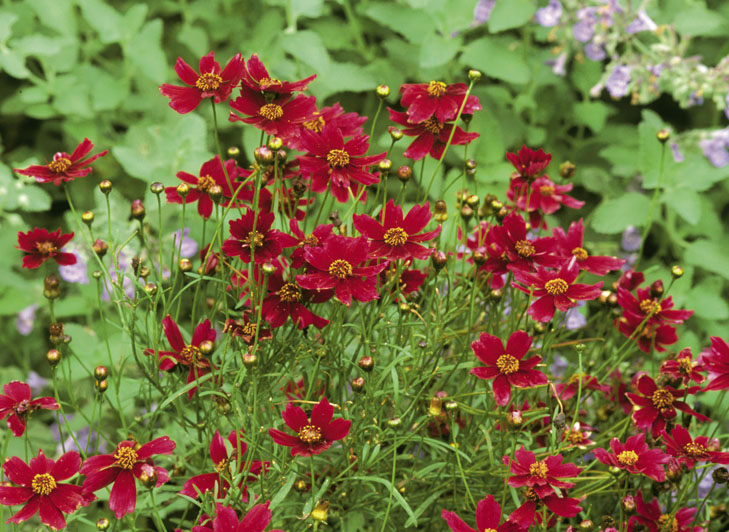
Coreopsis ‘Limerock Ruby’
‘Little Sundial’ is dwarf with bright yellow blooms with maroon centers. 10 in. high and wide.
‘Pinwheel’ has light yellow, petal-like ray flowers, curled like the vanes of a pinwheel. Sterile, does not reseed. Blue-green, mounded foliage. 24 in. × 30 in.
‘Tequilla Sunrise’ blooms with orange-centered, yellow daisies above variegated yellow-and-green foliage. 12–16 in. high and wide. Z5–9.
Cornaceae
dogwood
This genus is known for woody trees and shrubs, but one species deserves recognition as a perennial. Bunchberry, Cornus canadensis, is valuable as a groundcover in woodlands and other shaded situations where its dark lustrous foliage and charming spring floral display are cherished. It spreads gently by rhizomes, producing short twiggy stems that bear whorls of oval, 1-in. leaves at their tips. These may turn slightly reddish in fall before leaf drop. In late spring appear what seem to be pale, 1-in. flowers; actually, these are clusters of small, greenish flowers framed by a circle of four 0.5-in., pointed, white bracts. If pollinated, usually by solitary bees or bumblebees, the flowers give rise to clusters of green, pea-sized berries that turn bright red at maturity. These serve as food for birds, moose, deer, and other wildlife—hence the alternate common names, including crowberry, pigeonberry, and squirrelberry.
Propagate by seed sown outdoors in fall; germination takes two to three years. Or divide clumps in spring or fall.
Cornus canadensis
• white
• late spring to summer
• 4–6 in. × 15–24 in.
• part shade, shade
• Z2–7
Bunchberry, creeping dogwood, crackerberry. Greenland into Canada and Alaska, and south to Indiana, West Virginia, and Colorado; also northern Asia. In the wild, bunchberry favors damp, acid soils in bogs, seepage banks, and woodlands. Difficult to grow in warm climates, but thrives in cool summers in part shade. May be slow to establish. Excellent in wildlife gardens or with compatible groundcovers including partridgeberry, dwarf blueberries, heaths, and vinca under acid-loving flowering shrubs.
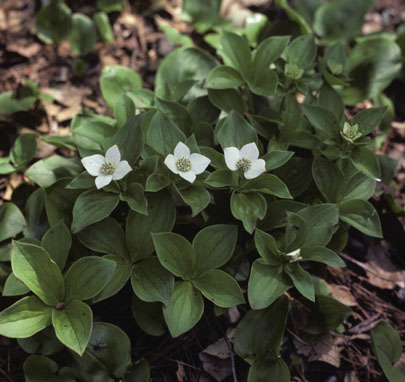
Cornus canadensis
Fumariaceae
fumewort
This genus was almost unknown in American nurseries until the latter part of the 20th century, but in the years since it has assumed a prominent place in our gardens. It deserves even wider planting. The generic name means “crested lark,” a reference to their exquisite spurred flowers; these can illuminate partially shaded parts of the landscape with an invaluable burst of color. Note that two popular species formerly included in this genus, Corydalis lutea and C. ochroleuca, have recently been reassigned to their own genus, Pseudofumaria.
Corydalis roots are fleshy or tuberous, and their leaves are finely divided; depending on the species they may be yellowish, bronzy, or light green, often infused with a bluish cast. Flowers are tubular and spurred, usually held in dainty loose clusters at the tips of succulent stems. Corydalis requires a consistently cool, moist soil high in organic matter; in cold climates mulch the plants well in winter. Most species excel in cool-summer regions, whereas few tolerate muggy heat and humidity in summer. Where they flourish, they make excellent companions for small bulbs, ferns, epimediums, lungworts, lilyturf, and other shade lovers in woodlands, along pathways, and in rock gardens. Deer resistant; tubers are sometimes dug and devoured by squirrels and chipmunks.
Propagate by seeds sown outdoors in fall or indoors with stratification followed by bottom heat (65–75°F).
Corydalis cheilanthifolia
• yellow
• spring
• 6–18 in. × 6–12 in.
• sun, part shade
• Z3–8, HS
Fernleaf corydalis. China. Very finely divided foliage, bronzy green with stronger bronze hue when young. Flower clusters held above the leaves and on separate stems. Fleshy rooted. Seeds about; collect seed when ripe (black) and sow in place. Resents transplanting. Beautiful with early miniature narcissus.
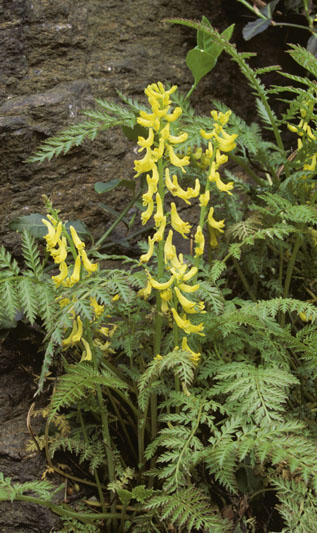
Corydalis cheilanthifolia
Corydalis elata
• blue
• late spring to early summer
• 16 in. × 12 in.
• part shade
• Z6–8, HS
Blue corydalis, blue false bleeding heart. Sichuan Province, China. Cobalt-blue flowers appear after the foliage has emerged. This species is easier to grow and more heat tolerant than most Corydalis flexuosa selections, and not as prone to going dormant in summer heat.
Self-seeds once established. Be alert for rust, slugs, and aphids.
Corydalis flexuosa
• blue
• late spring to summer
• 12–15 in. × 12 in.
• part shade
• Z5–8, HS
Blue corydalis. Western Sichuan Province, China. Summer dormant growing from small bulbs. Light green foliage, sometimes flushed with purple, is twice divided into three. Long-spurred, bright blue flowers, white at the throat, crowd into terminal and axillary racemes. Humus-rich soil that drains freely is ideal.
‘Blue Panda’. Spurred, elongated, light blue flowers, pinkish and yellow tipped at the mouth. Summer dormant but fall rebloom. 10 in.
‘China Blue’. Fragrant, dark blue flowers, purple at the mouth. Often summer dormant; mulch to cool soil and retain moisture. 16 in.
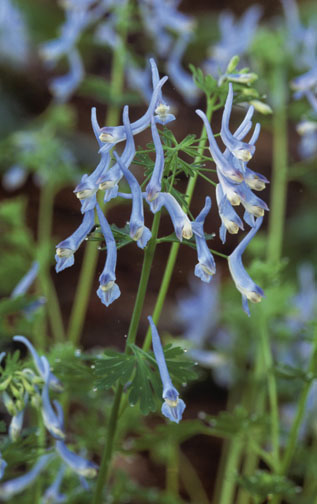
Corydalis flexuosa ‘China Blue’
‘Père David’ has clear blue flowers and divided leaves touched with red or purple. 12 in.
Corydalis solida
syn. C. halleri
• red-purple
• spring
• 6–12 in. × 8 in.
• part shade
• Z4–8
Purple corydalis, fumewort. Eastern Europe. Gray-green, ferny, 3-in. leaves emerge early in the spring from tuberous roots. Spikes of as many as 20 narrow-spurred, 1-in., tubular blossoms cluster at stem tips. After a brief bloom time the foliage yellows and disappears tidily.
‘Beth Evans’. Very floriferous with pink flowers accented with white throats. Z6–8.
‘George Baker’ has red flowers. Z6–8.
Other Notable Cultivars
‘Berry Exciting’ is well named with its bright purple-red flowers set against golden leaves. Summer dormant. 10 in. Z5–9.
‘Blackberry Wine’ has lacy, bluish green foliage and fragrant, deep maroon flowers from late spring to early summer. 10 in. Z5–8.
‘Canary Feathers’ has upright spikes of bright yellow flowers set against bluish foliage. Blooms in spring into summer and sporadically as the temperatures cool. Great in rock gardens or along woodland paths. 7–8 in. Z6–9.
Asteraceae
cosmos
Come spring you’ll find six-packs of annual cosmos, Cosmos bipinnatus and C. sulphureus, in every garden center; much harder to obtain, but just as rewarding, are their perennial relatives. In fact, only two of the perennial cosmos species are available commercially: C. atrosanguineus and C. peucedanifolius.
Provide a humus-enriched, well-drained, moist soil in a sunny spot—cosmos tolerate part shade but bloom may suffer. These perennials are tuberous-rooted; in cold-winter regions where they are not hardy (both species are vulnerable to temperatures below 5°F), the tubers should be dug in fall and stored indoors over the winter. Replant outdoors when soil has warmed the following spring.
The flowers of both perennial species resemble those of the more familiar annuals: they have rounds of petal-like ray flowers surrounding a plush central button of golden disk flowers. They also have the same airy aspect, with the daisies perched atop long, wiry stems. Their somewhat sprawling habit can be disciplined by staking, but still appears casual and charming. Better choices for a cottage garden than a formal border, they are also effective to lighten the aspect of a formal floral display. Outstanding as cut flowers.
Pests and diseases are seldom serious although aphids may attack overly lush or unhealthy plants. Protect from deer.
Propagation is by seed or division of established clumps.
Cosmos atrosanguineus
• maroon
• midsummer to early fall
• 2–3 ft. × 1–2 ft.
• sun, part shade
• Z7–10
Chocolate cosmos. Mexico. Bushy plants with dark green, compound leaves, pinnately divided into ovate to lance-shaped segments. Flowers measure 1.5 in. in diameter, and are borne atop slender stems; they smell of chocolate mixed with vanilla. Flowering is more prolific in older plants. The flower color makes a good counterpoint to silver-foliaged plants including wormwoods and lavenders, and is especially outstanding in containers. Butterflies are drawn to the flowers.
‘Chocamocha’ is compact. 12 in. high and wide.
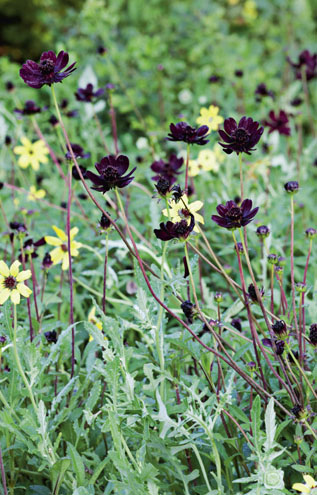
Cosmos atrosanguineus and yellow Berlandiera
Cosmos peucedanifolius
• pink
• late spring to early fall
• 24–30 in. × 18–24 in.
• sun, part shade
• Z7–10
Perennial cosmos. This South African species is new to the garden scene and still of limited availability. Plants may straggle the first year but fill in to make more shapely mounds thereafter. Deep green foliage is topped with unscented, pink flowers borne over a long season.
‘Flamingo’ has lavender flowers.
Brassicaceae
colewort
These wild relatives of cabbages have varied uses (for example, the seeds of Abyssinian mustard, Crambe abyssinica, are pressed to yield a super-fine industrial lubricant, used as a substitute for sperm whale oil), but only two species earn their keep as ornamentals. Colewort, C. cordifolia, was a common feature of Victorian landscapes, but its imposing size, which appealed to that expansive era, caused downsizing gardeners in the 20th century to reject the plant. The current generation of designers, however, is turning once again to this gigantic flower to play with the sense of scale in smaller plots. Meanwhile, less impetuous gardeners are rediscovering its more modestly proportioned relative, sea kale (C. maritima), growing it both for its traditional use as an edible green and now for its visual appeal. Both species offer bold foliage and clouds of honey-scented small, white flowers. They work well in beds and borders with other perennials and shrubs, and are alike in preferring a rich, well-irrigated, well-drained soil. Pollinators flock to them, especially the cabbage white butterfly (Pieris rapae), whose caterpillars devour brassica crops. Deer may make a meal of them also.
Propagation is by seed; these plants form deep taproots and should not be disturbed once they have become established in a site.
Crambe cordifolia
• white
• late spring to early summer
• 4–7 ft. × 2–3 ft.
• sun
• Z5–8
Colewort. Caucasus Mountains of eastern Europe. Colewort forms a 2- to 3-ft. basal mound of crisp, lobed, wrinkled green leaves, each of which may measure 12–14 in. across. From this rises a tall, sometimes head-high stem that bears what seems to be a hovering cloud of minute, four-petaled, white flowers, giving the effect of gypsophila (baby’s breath) on steroids. Staking is recommended, as is vigilance in protecting the foliage from slugs and caterpillars. A striking specimen or accent within the border, allow sufficient room to achieve full development. Best seen backed by dark evergreens or a wall or solid fence. Interesting among dark-leaved shrubs, including Weigela Wine and Roses (‘Alexandra’).
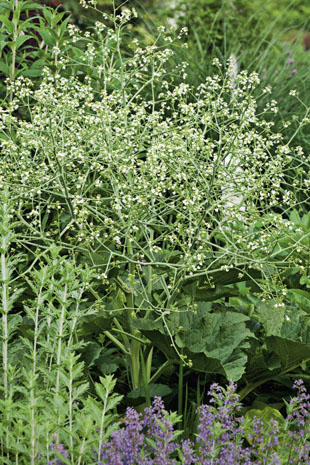
Crambe cordifolia
Crambe maritima
• white
• early to midsummer
• 24–36 in. × 24–30 in.
• sun
• Z4–9
Sea kale. Coastal areas of northern Europe. The mound of kale-like large, leathery, powder-blue, ruffled-edged leaves make this an outstanding foliage and textural plant. A secondary benefit is the large clusters of small, sweet-scented flowers that hover over the leaf-cushion during flowering season. Tolerates sandy soils and salt spray; an excellent plant for seaside gardens. Can be used as an edging, massed, or as a specimen plant in containers and borders. Edible.
Asteraceae
hawk’s beard
Athough not in the top rank of ornamental flowering perennials, the dandelion-like flowers of hawk’s beard provide a welcome splash of color in cottage garden borders, raised beds, or rock gardens. They require average, moisture-retentive, well-drained soil, and are not fussy about soil pH. Easy to grow from seed.
syn. C. kitaibelli
• orange
• summer to fall
• 6–12 in. × 12 in.
• part shade
• Z5–7
Golden hawk’s beard. Mountain meadows of the European Alps, Italy, and the Balkans. Upright with rosettes of shiny oval leaves to 4 in. in length, shallowly lobed or undulate along the edges. Solitary, 1-in.-wide, orange or fiery reddish orange daisy flowerheads top stems covered with black and white hairs. Self-seeds readily, especially in gravel.
Crepis incana
• pink
• early to midsummer
• 10–12 in. × 12 in.
• sun
• Z5–7, HS
Pink dandelion, pink hawk’s beard. Greece. Clump forming with grayish, dandelion-like leaves to 5 in. long. Clear pink to magenta flowerheads are borne on erect, branched stems. Seldom self-seeds. Lovely in rock gardens against gray rocks. Received the Award of Garden Merit from the Royal Horticultural Society.
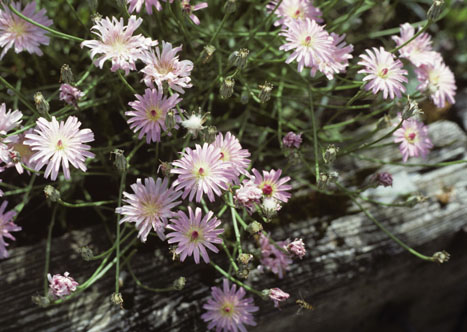
Crepis incana
Iridaceae
montbretia, coppertips
“All the world’s a stage,” and a sense of timing is just as important in the garden as on Broadway. Crocosmias earn star billing by blooming precisely when the perennial gardener needs flowers most, from midsummer into fall when many other standbys are waning. Crocosmia inflorescences are spectacular, too: 4 to 20 funnel-shaped or tubular blossoms in brilliant shades of red, orange, or yellow are borne in sprays along the tip of a wand-like stem. The long, blade-like leaves are also attractive and add structure to a border.
Most of the crocosmias in the nursery trade are hybrids, often resulting from crosses of several species. This diverse heritage makes them exceptionally adaptable. They thrive in well-drained, organic-enriched, moisture-retentive soil, but thanks to their cormous roots, crocosmias are able to withstand substantial drought. Hardy to zone 6, or in some instances to zone 5, especially when protected with a winter mulch. In colder regions, lift the corms after first frost and store over winter as for gladiolus.
Crocosmias prefer full sun, except in hot climates where they appreciate partial shade. Bloom becomes less abundant as clumps become crowded, but division restores plants to vigor.
Most visually effective when planted in multiples, crocosmias are outstanding for summer beds and borders as well as among shrubs, and in meadows with grasses and wildflowers. In informal areas, especially close to water, they are spectacular combined with bold-leaved ligularias, large-leaved hostas, and tall ferns. They also make fine container plantings, perhaps with tall floss flower, bluebeard, or mountain mint. Enjoy them indoors as a source of elegant, eye-catching cut flowers.
Deer resistant, attracts hummingbirds. Spider mites may damage foliage and impair flowering unless controlled. Some of the most vigorous hybrids, which are sometimes called montbretias, have proven invasive in areas of the US Pacific Northwest.
Propagate by dividing older congested clumps in spring before growth commences. Offsets sprout at the base of the main corms; remove and replant to further increase stock. Species may be started from seed sown indoors in a warm location in late winter.
Crocosmia aurea
• yellow, orange-red
• early to late summer
• 24–36 in. × 6–12 in.
• sun, part shade
• Z6–9
Falling stars, montbretia. Forests and river banks in South Africa. Spreads by stolons from corms, forming colonies in hospitable sites. Downward-facing flowers, to 1.5 in. in diameter, are carried on branched stems, as many as ten to a spike. These are followed by seedpods that take on an orange hue as they ripen, then split to reveal shiny black seeds with a bright orange covering. Cold sensitive; provide winter protection in cool-winter zones.
Crocosmia masoniorum
• orange
• mid- to late summer
• 24–36 in. × 4–18 in.
• sun
• Z6–10
South Africa. Frequently misspelled as “masonorum” in the nursery trade. Upfacing, brilliant orange or orange-red flowers, borne in profusion, 12 to 30 per stem. Proliferates rapidly and may even become invasive in hospitable sites.
Other Notable Cultivars
‘Bright Eyes’ (‘Walbreyes’) is compact, to 20 in., with red-eyed, orange blossoms. Z6–9.
‘Emberglow’ bears burnt orange-red flowers on 40-in. stems. Z5.
‘Emily McKenzie’ (‘Lady McKenzie’) carries large, maroon-splotched, orange blooms on 30-in. stems. Z6.
‘Golden Fleece’ (‘George Davison’, ‘Citronella’) is an heirloom from 1902. Small, lemon-colored flowers on 2- to 2.5-ft. stems. Z5–9.
‘Little Redhead’ (‘Walrhead’) is compact, to 20 in., bearing tomato-red flowers with yellow throats. Z6–9.
‘Lucifer’. This popular hybrid has intense glowing scarlet-red flowers. 2–4 ft. × 18 in. Z5–9.
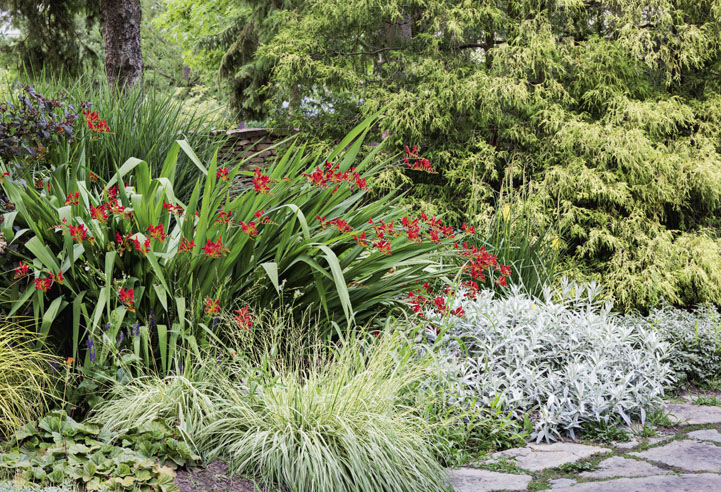
Crocosmia ‘Lucifer’
Primulaceae
cyclamen
The most familiar of the cyclamens is Cyclamen persicum, the Persian, florist’s, or greenhouse cyclamen that is often forced into flower for the holiday season and sold by the millions as decorative houseplants or to be planted out in frost-free areas. They have been hybridized extensively for compact growth, attractively marked foliage, diminutive size, jewel colors, and more attributes. However, as beautiful as they are with their attractive heart-shaped foliage and brightly colored, swept-back petals, few succeed outdoors year-round in colder gardens. Fortunately, the same beauty is also found in hardier species that also hail from the eastern Mediterranean.
Cyclamen grow from corm-like tubers that gradually expand with age. From these emerge plain or variously silver-marked, rounded or heart-shaped leaves borne on succulent stems, above which rise swept-back flowers in reds, pinks, and white, mostly blotched at the nose with deep red. Cyclamens grow best in a slightly alkaline, well-drained soil. They go dormant after blooming and should then be allowed to rest; ideally, keep the soil barely damp. All parts of the plants are mildly toxic if ingested, but are still acceptable to browsing deer. Sometimes known as sow bread, alluding to the fact that pigs root for the tubers in the wild.
If flowers are pollinated, seed capsules develop at the tips of spiraling stems and split when seed is mature. Sow as soon as ripe. Protect seedlings and young plants from digging squirrels.
Cyclamen cilicum
• white, pink
• fall
• 2–3 in. × 6–8 in.
• sun, part shade
• Z6–9
Hardy cyclamen. Evergreen woodlands of the mountains of southern Turkey. Pale pink to rosy flowers blotched with purple on the nose. Deep green, rounded or heart-shaped leaves, boldly marked with silver, appear with or just after the flower buds in fall. Bloom lasts for several weeks; the foliage persists into spring. There is a white-flowered form. Add composted pine needles to the soil to raise acidity and increase drainage. Excellent in dry shade under deciduous trees and shrubs. Good for containers.
Cyclamen coum
• white, pink
• winter to early summer
• 2–3 in. × 6–8 in.
• part shade, shade
• Z4–9
Western Black Sea coast of Bulgaria, east to Iran, Turkey, Lebanon, and Israel. Rounded, deep green leaves patterned with silver, or plain but lustrous. After the leaves have appeared, flowers bloom in several shades of pink, rimmed with white at the snout and stained purple red. Provide a site with diffuse light, especially under tall deciduous trees where soil is humus rich and moisture retentive but not waterlogged. Tolerates drought well. Plant tubers shallowly, slightly above soil level; appreciates a winter mulch in cold regions. Sometimes catalogs separate clones with different leaf markings into groups such as the “Pewter Group.”
‘Album’ (f. albissimum) has white flowers marked with carmine at the nose.
‘Silver Leaf’ bears exquisite heart-shaped, silvery leaves with a dark green center.
Cyclamen hederifolium
syn. C. hederifolium ‘Rosenteppich’, C. neapolitanum
• white, pink
• late summer to early fall
• 4–5 in. × 6–8 in.
• sun, part shade, shade
• Z4–8
Ivy-leaved cyclamen grows wild from southern France to the Balkans, and along the northern Mediterranean and Aegean Sea to western Turkey. The hardiest species, it does best in soil generously enriched with humus to improve soil tilth and moisture retention. Mulch in summer, and in regions with intense sunlight protect from midday rays. Excellent under high deciduous trees, where a colony may increase and thrive for many years; in time, the tubers may grow to 3 in. or more across. Nodding flowers and foliage appear at the same time, or the pointed flower buds may precede the foliage that then persists through the winter months into the following spring. Gray-green leaf blades are usually marked with purplish silver, and held at an angle on long pedicels (stalks). Plant the tubers as soon as you receive them, less than 1 in. deep. Plants are very variable. Suitable for container culture.
‘Album’ (‘Perlenteppich) has all-white flowers.
Cyclamen purpurascens
syn. C. europaeum
• red, purple
• summer to fall
• 4–5 in. × 6–8 in.
• part shade, shade
• Z5–9
Purple cyclamen. Central and southern Europe. This woodlander is happy in alkaline soil amended with plenty of composted leaf mold; less tolerant of summer drought than some other species. The dark reddish purple flowers are fragrant and start to bloom at the same time as the leaves emerge in mid- to late summer and into early fall. The foliage remains evergreen, sometimes for ten or so months. Not a great seed producer, except in very favorable conditions. A sugary coating envelops the seed coat to attract ants that serve as seed disseminators.
Asteraceae
cardoon, artichoke
Only one species of this Old World genus finds a place in our gardens. It is most familiar in the form of subspecies Cynara cardunculus subsp. flavescens, the edible artichoke; unfortunately, relatively few gardeners know of the species itself, the highly ornamental, easily grown, and edible cardoon, C. cardunculus.
Propagate by seed, by the division of mature plants in spring, or by root cuttings taken in winter.
Cynara cardunculus
• purple, lavender
• late spring to early summer
• 3–6 ft. × 1–3 ft.
• sun
• Z7–9
Cardoon, artichoke thistle. Native to the lands surrounding the western and central Mediterranean, this plant has the appearance of a huge, spectacular, and unexpectedly elegant thistle. The foliage and form are bold, forming a highly sculptural, vase-shaped fountain of arching leaves, upright stems, and, in season, stately flowers. Lower leaves may measure 3 ft. long (this size decreases as the leaves ascend the stems), silver-gray on top, white and felted with hairs below, deeply lobed, and spiny. The 2- to 3-in. flowers, borne on branching gray stems, are composed of dense, symmetrical tufts of violet-purple filaments set into prickly spined, cup-shaped, purplish bases.
Cardoon requires a sunny site and well-drained soil. Though it prefers a rich soil, it tolerates poor ones and has escaped from the garden to become a troublesome weed in areas of California and the semi-arid West. At the northern end of its range (zone 7) it performs best in a sheltered site; a good subject for seaside gardens. A natural for xeriscapes or low-water gardens, cardoon’s silvery foliage provides an attractive complement to shrubs or flowering plants with red or bronze foliage; try it with Weigela Wine and Roses (‘Alexandra’) or purple smokebush. It’s blue-violet flowers harmonize well with other blues such as lungworts, monkshoods, and delphiniums, or make a stunning “color echo” combination with purple alliums. Its strong, sculptural form helps to create architectural and visual definition in a sunny border. It also makes a striking container planting and the flowers, when cut and dried, are outstanding in dried arrangements.
Normally trouble free, cardoons may be subject to root rot in moist climates in less than well-drained soils, and are also susceptible to slugs and aphids.
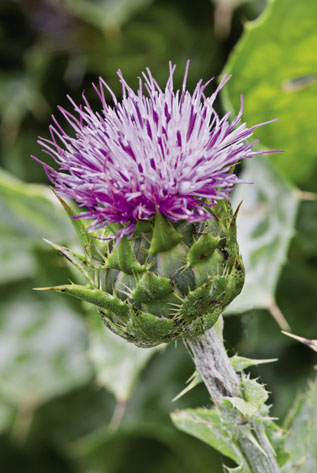
Cynara cardunculus in flower
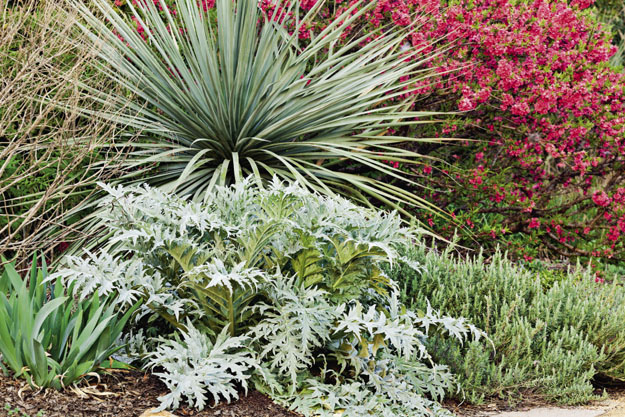
Silvery gray–leaved Cynara cardunculus shows off surrounded by Nolina and Lorapetalum
Boraginaceae
hound’s tongue
True, vivid blue is a color rarely found in flowers and thus is much sought after by gardeners; this makes hound’s tongues real finds. Not all are suitable for perennial gardens; although attractive, Cynoglossum amabile is biennial, and common hound’s tongue, C. officinale, whose burr-like seed clusters snag onto clothing and animal fur, is an unwelcome invasive weed. However, there is one species, described here, that is a well-behaved and desirable perennial.
Hound’s tongues are rather coarse plants with bristly leaves and curled sprays of tubular forget-me-not flowers clustered like a scorpion. These expand and continue to bloom over several months. Provide a sunny or partly shaded spot where the soil remains moist but not waterlogged; it need not be too rich.
Propagate by seed sown in spring or fall or by division in spring.
Cynoglossum nervosum
• blue
• late spring to summer
• 18–24 in. × 24 in.
• sun, part shade
• Z5–8
Hairy hound’s tongue. Himalayas. This is an upright, branched grower with a rosette of prominently veined, slender basal leaves. Cymes of brilliant blue flowers, each about 0.5 in. across, bloom over several weeks. Protect from intense southern sun; withhold fertilizer to avoid floppy growth, but do not allow dry out.
Other Notable Cultivars
Wild comfrey (Cynoglossum virginianum), a North American native, has very bristly stems and pale blue flowers over a shorter season. 1–2 ft. tall.
Orchidaceae
ladyslipper orchids
This genus defies the common conception of orchids as tree-dwelling, tropical plants; ladyslipper orchids are not only ground dwelling, but many are remarkably cold hardy, with one species, Cypripedium guttatum, flourishing on the Alaskan tundra. A total of 11 species are native to North America.
Cypripediums have long, pubescent, pleated, green leaves; the flowers, either solitary or borne in sparse terminal racemes, have three sepals (the lower two often joined), two petals, and an inflated, pouched (slipper-like) lip. These are slow-growing plants, with some species requiring a decade or more to progress from seed to flowering age in the wild. In addition, some cypripediums, notably the pink ladyslipper (C. acaule), are extremely difficult to maintain in cultivation. Fortunately, several species adapt well to cultivation, and a host of new hybrids are more vigorous and tolerant than their wild parents.
If you decide to try your hand at these connoisseurs’ flowers, be sure that the plants you purchase have been nursery propagated and grown—the commercial collecting of cypripediums from the wild has had a disastrous impact on wild populations. One clue to a nursery-propagated plant is the price, which is typically substantial; bargain ladyslippers are almost certainly collected from the wild and seldom fare well in gardens. When they find a situation they like, cypripediums self-seed or spread by stolons to form large colonies. Gardeners, however, are far more likely to experience them as shy and solitary jewels to be displayed in a semi-shaded spot in woodland gardens among slower-growing ferns, epimediums, or, in the case of hybrids, among dwarf hostas. The preferences of the various species differ slightly, but generally a loose, well-drained, moist, organic-rich soil is adequate. A site that receives two to three hours of direct sunlight early or late in the day, with dappled light otherwise, is ideal. Do not dig in new plants; instead, stretch the roots out horizontally over the surface of the prepared soil and then cover with a thin layer of compost and a mulch of shredded leaves or conifer needles. Water attentively so that soil does not dry out, especially during the first growing season.
Propagate by division; seed propagation is best left to the experts and is very slow.
Cypripedium calceolus
• yellow-and-maroon
• mid- to late spring
• 9–30 in. × 12 in.
• part shade
• Z3–8
Yellow ladyslipper. Open woods with moist, calcareous soils across Europe and through Asia. Prefers neutral to mildly alkaline soil (pH 6.5–7.5). Pleated leaves to 8 in. long; large, yellow, slightly fragrant flowers are borne one or two to a stem. This is the easiest cypripedium to grow in the garden, succeeding on most neutral to slightly acid loams.
Cypripedium candidum
• white
• midspring
• 4–14 in. × 9–12 in.
• sun, part shade
• Z3–6
White ladyslipper, prairie ladyslipper. Moist grasslands and meadows in northeastern and north-central North America. More sun tolerant than other ladyslippers, this species prefers neutral to slightly alkaline (pH 6.6–8.5), consistently moist soils. Two to four pleated green leaves, to 2.5 in. wide and 6 in. long, are borne on the upper halves of stout, upright stems. Solitary flowers may reach 1 in. long with a white pouch and greenish yellow sepals and petals.
Cypripedium parviflorum
• yellow
• midspring to early summer
• 12–24 in. × 9–12 in.
• part shade
• Z4–7
Small yellow ladyslipper. Deciduous and hemlock woodlands from Alabama to Nebraska, and east to Massachusetts and North Carolina. Bears four to seven ovate leaves, 8 in. × 4 in., and one or two 1.5-in. flowers; pouch is dark yellow, sepals and petals are maroon or streaked with maroon. Prefers neutral to slightly acid (pH 6.0–7.0), consistently moist soils.
var. pubescens (greater yellow ladyslipper) is found in moist deciduous woods and swamps throughout North America, except in California, Oregon, and Nevada. It differs from the type by having flowers to 2.25 in. long and green sepals and petals streaked with maroon. This species is one of easiest cypripediums to transplant and establish. Z3–8.
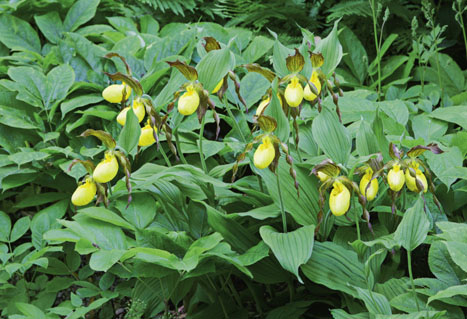
Cypripedium parviflorum var. pubescens
Cypripedium reginae
• white-and-pink
• early summer
• 2–2.5 ft. × 1 ft.
• part shade
• Z3–7
Showy ladyslipper. Eastern and central North America. Clusters of sturdy, hairy stems bear one to two flowers each; 2- to 3-in. blossoms have white petals and sepals, deep rose pouch. Prefers neutral to slightly acid, consistently moist soil. One of the most spectacular species of the genus.
Other Notable Cultivars
There are numerous hybrids, and in general these are easier to grow than the species:
‘Aki’ has large, plum- to pink-striped flowers with twisted, pinkish sepals. 18 in. Z4–7.
‘Gisela’ bears flowers with a creamy-yellow pouch streaked with burgundy and backed by three large, dark burgundy sepals. 15 in. Z4–7.
‘Hank Small’ displays flowers with a deep yellow pouch backed by long, twisted, cinnamon-colored sepals. 18 in. Z4–7.
‘Inge’ flowers have a large, ivory pouch set against twisted, amber-purple sepals. Vigorous and fast growing. 16 in. Z4–7.
‘Ulla Silkens’ is vigorous and floriferous. A mature clump may bear 100 large burgundy and white slippers, each backed by three large, pure white sepals. 2 ft. Z3–7.
Orchidaceae
marsh orchid
These wonderful tuberous terrestrial orchids deserve a broader use in North America; even the most modest European gardens frequently display a striking patch or two. Healthy specimens of marsh orchids produce spikes of as many as 60 or more bird-like, two-lipped flowers in dense, 6-in. racemes, with vibrant colors ranging from pink, lilac, purple, to white with contrasting spots on the lip.
A rich source of color for partly shaded woodlands, rock gardens, and meadows, marsh orchids prefer a damp but not waterlogged soil that is deep and rich in humus.
Flattened, finger-like tubers give rise to slender, lance-shaped leaves, usually mid-green and often covered with dark spots. Each tuber grows for a year and then is replaced by a new tuber sprouting from its tip. Plant in fall; a summertime topdressing of organic matter encourages marsh orchids to spread. Although these plants aren’t the easiest to grow, the rewards for success are great.
Marsh orchid tubers resent disturbance, but may be divided in spring. Alternatively, sow seed in containers of soil obtained from a site where these plants are already growing—a symbiotic fungus must be present for the seeds to germinate.
Dactylorhiza foliosa
syn. D. maderensis, Orchis maderensis
• purple
• summer
• 1–2 ft. × 1 ft.
• part shade
• Z7–8
Madeiran marsh orchid. Madeira. Lustrous, broadly lance-shaped leaves, generally without spots. Bloom spikes may reach 6 in. long, crowded with intense purple flowers, with contrasting speckles on the lip. Perhaps the easiest species to grow. Broad-leaved or western marsh orchid (Dactylorhiza majalis) from western and central Europe is similar but blooms somewhat earlier with foliage usually heavily marked with chocolate-purple.
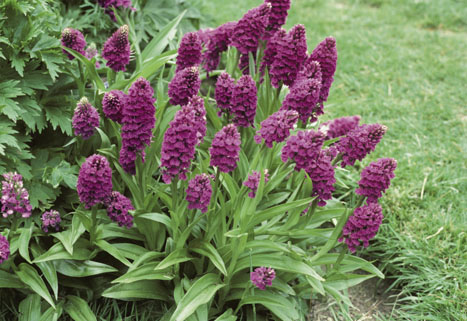
Dactylorhiza foliosa
Dactylorhiza praetermissa
syn. Orchis praetermissa
• purple
• early summer
• 8–26 in. × 12 in.
• part shade
• Z6–8
Southern marsh orchid. Northern Europe. Robust spikes of light purple flowers, each daintily marked with darker purple on the lip. Leaves may be spotted as well but not always. Similar Algerian Marsh orchid (Dactylorhiza elata) produces its cylindrical blooms a little later. The spikes are robust and closely set with 0.75-in. flowers. Unmarked leaves.
Saxifragaceae
umbrella plant
Another genus with but one species, Darmera offers a more-compact but visually stimulating alternative to giant-leaved Gunnera. Ideal for smaller gardens.
Propagate by seed sown in spring or fall or by division in spring.
Darmera peltata
syn. Peltiphyllum peltatum
• pink, white
• early to midspring
• 2–4 ft. × 3–4 ft.
• sun, part shade, shade
• Z5–9, HS
Umbrella plant. Streamsides in mountain woodlands of southwestern Oregon and northern California. The five-petaled, white to bright pink flowers emerge in spring before the leaves, and are borne in spherical cymes or flat-topped clusters atop tall, bristly, branching stems that sprout from the rhizomatous roots. Becoming dense and matted, the roots provide effective erosion control on wet soils. The parasol-like, peltate leaves, lobed along the edges, measure 10–12 in. across, forming lush, dark green mounds that turn a spectacular shade of red in fall. Umbrella plant tolerates full sun when rooted in consistently damp soil but is more at home in partial shade. It makes a strong statement in waterside plantings or bog and rain gardens. Prefers cool summers and dislikes the combination of heat and humidity. Generally trouble free, but leaves may scorch if plants are subjected to drought. Deer resistant.
Propagation is by division, but the tough clumps are not for the fainthearted. Once established, they are difficult to eradicate.
‘Nana’ is a dwarf form that seldom tops 18 in. tall.
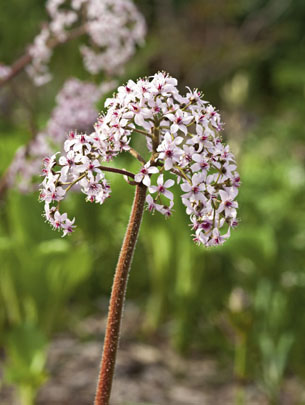
Spring blooms of Darmera peltata
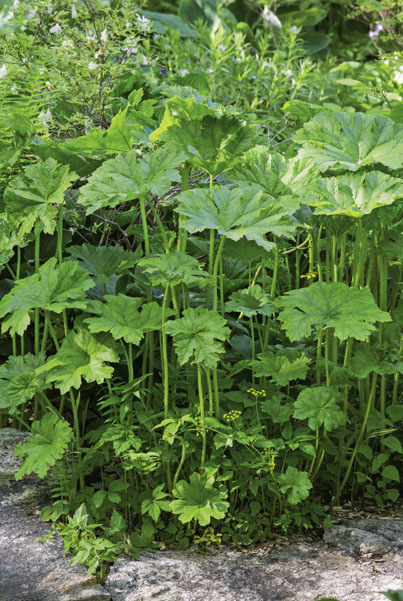
Darmera peltata foliage
Aizoaceae
ice plant
These southern African succulent plants are easy to grow, requiring little care, and provide a convenient as well as attractive solution for troublesome hot and droughty areas of the landscape. They are also promiscuous: there are 100 or so species and they interbreed freely in the wild, causing considerable debate among botanists trying to sort out the ice plant family tree.
Ice plants provide vivid splashes of color in the landscape and their mats of jellybean-like foliage are often seen blanketing steep banks and hillsides beside highways where they generally flourish without any care. They actually prefer rocky, average to poor soil, as long as it drains well. The drainage is non-negotiable: ice plants will surely die in their first winter if planted in waterlogged clay or any other soil that remains persistently wet. Even where the drainage is good, a gravel topdressing or mulch is beneficial to facilitate water runoff around the crowns of the plants.
Although ice plants tolerate partial shade, their bloom is most abundant when grown in full sun. Partner them with other succulents such as sedums, sempervivums, opuntias, crassulas, and red hot poker aloes in crevices between rocks, in raised beds, on dry, nutrient-poor banks, or containers. Deer resistant.
Propagate from seed at about 70°F, or take stem cuttings in spring or summer. Increase cultivars vegetatively.
Delosperma cooperi
syn. Mesembryanthemum cooperi
• magenta
• early summer to late fall
• 3–5 in. × 24–36 in.
• sun, part shade
• Z5–9, HS
Hardy ice plant, Cooper’s ice plant, trailing ice plant. Native to rocky slopes of central southern Africa, hardy ice plants are adapted to very well-drained but average soils. This fleshy creeper has cylindrical, light green leaves 1–2 in. long; these may become red in cold temperatures. Showy solitary, daisy-like, 2-in., hot-pink flowers with white anthers cover the plants all summer until frost. Very tolerant of drought, and invaluable in xeric gardens; excellent as a groundcover on difficult dry, sunny banks, as well as being well suited to rock gardens, containers, and raised beds. Fast growing and considered an exotic invasive in some areas. Melts out in the humidity of the southeast United States, but excellent in coastal gardens.
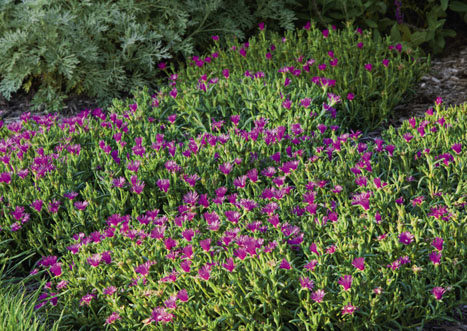
Delosperma cooperi
Delosperma dyeri
• orange, coral
• spring to fall
• 2–3 in. × 18–20 in.
• sun
• Z5–9
Red mountain ice plant. Native to the mountains of South Africa’s Eastern Cape. A prolific bloomer, red mountain ice plant covers itself with shiny, white-eyed, coral- and watermelon-red starry flowers for a period of several months. Provide a sunny spot with very free drainage. Drought tolerant. Especially handsome in rock or raised gardens.
‘Psdold’ has scarlet flowers. 2007 Plant Select winner.
Delosperma nubigenum
• yellow
• spring
• 4 in. × 24 in.
• sun
• Z6–9
Yellow ice plant. Found at high altitudes of the Lesotho Mountains of South Africa, this species tolerates more humidity than most. Low, succulent, evergreen mats of pointed, oval, bright green leaves that become watery green (like green grapes) in winter, sometimes tinged with red. They thrive in poor, rocky soil with little water, so are excellent for dry and even xeric gardens as ground cover, on walls, as edgings, or in rock gardens. Do not irrigate. In spring these easy-to-grow plants are covered with bright yellow, orange-eyed daisies that attract butterflies.
‘Basutoland’ produces masses of bright yellow flowers in late spring into summer. Oval, lettuce-green leaves. Tolerates bright shade as well as sun. Great for raised beds and containers. 2–4 in. Z5–9
Other Notable Cultivars
‘Beaufort West’ sports small, light pink daisies above cushions of fat, succulent, 1-in. leaves. Z5–7, HS.
‘Eye Candy’ belongs to a group of smaller-flowered, white-eyed ice plants bred in Japan. Carmine-red flowers, maturing to orange. Spring blooming. Z5–7, HS.
‘Fire Spinner’ is exceptionally hardy with white-eyed, brilliant orange-and-magenta flowers, 1.5 in. across. Plant Select winner in 2012. Z5–8.
‘John Proffitt’ (Table Mountain) is considered superior to similar Delosperma cooperi. Long-blooming, glistening, bright magenta daisies. Plant Select winner in 2002. Z6–8.
‘Kelaidis’ (Mesa Verde). Another Plant Select winner in 2002. Salmon-pink daisy flowers on compact plants from spring to fall. Tolerates light shade. Z4–8.
‘Pink Ribbon’ is bicolored pink-and-orange. All summer bloom. Z5–11.
Ranunculaceae
larkspur
The hybrid delphiniums that are cultivated to such perfection in English mixed borders, with their head-high, regal spires of vividly colored blossoms, are rightfully iconic. However, they are also finicky plants that in the United States perform well only in such cool, moist regions as the Pacific Northwest or coastal New England, and even there require plenty of nurturing. This has led too many American gardeners to dismiss delphiniums out of hand. In fact, this remarkably diverse genus offers hardy species adapted to almost every region of our country. Indeed, many are native to this continent. Additionally, in recent years breeders have introduced new strains of hybrids that offer many of the assets of their English relatives, but combine them with a more vigorous, self-sufficient constitution.
Few perennials are as effective as delphiniums in providing a vertical accent in beds or borders. Although the pattern of growth varies somewhat with the species, delphiniums typically produce clusters of upright, sometimes branching stems, crowned in season with flowers borne in spikes or racemes, sometimes in panicles. Each flower consists of five petal-like sepals surrounding a “bee” of two to four smaller true petals at the center, and commonly with a spur projecting from the back. Although blue is the color associated with delphinium flowers in the popular imagination, delphinium blossoms include pigments for red and yellow as well; depending upon the balance of pigments, flowers can range from pale cerulean to deep blues and violets to pinks, reds, yellows, and white. Delphinium leaves may be basal or alternate on the stem, and are palmately lobed or divided.
Delphiniums prefer a well-drained, humus-rich soil and thrive in full sun to light shade. Recommended care includes regular deep watering during spells of rainless weather, feeding in early spring and fall with a balanced (avoid high-nitrogen products) slow-release fertilizer, and staking to support the individual flower spikes of taller hybrids. Cut spent spikes back to their bases to encourage rebloom of laterals.
Pests and problems are legion, and include slugs and snails on succulent young growth, and black-spotted foliage caused by cyclamen mites; curled and distorted leaves are usually a symptom of aphids; yellow and stunted plants may indicate nematodes. Black, foul-smelling decay at the base of plants is caused by bacterial crown and root rot; powdery mildew can disfigure stems and foliage, and stunt growth. The flowers attract butterflies, bees, and hummingbirds, but they resist deer and rabbits.
Very few perennial delphiniums will tolerate the combined heat and humidity of southeastern US summers; in that region, they are more commonly treated as winter annuals.
Delphiniums are poisonous in all or some of their parts, and cause skin irritation in some people. Protect your hands with gloves. Never decorate food plates with these flowers.
Plants can be started from seed or propagated by dividing healthy plants. Cuttings of young shoots root readily in spring.
Delphinium ×belladonna
• various
• spring to summer
• 3–4 ft. × 2 ft.
• sun
• Z3–10, HS
Belladona delphinium. Of garden origin. A group of hybrids that derives principally from crosses between Delphinium elatum and D. grandiflorum. Characterized by finer foliage and somewhat smaller stature than the classic border delphiniums, the belladonna hybrids require less staking than their loftier relatives. They bear loose racemes of single or double, 1.5- to 2-in. flowers on branching stems over an extended season; deadheading promotes another flush in late summer. Mildew resistant.
‘Belladonna’ bears light blue, single flowers.
‘Bellamosum’ (‘Bellamosa’) has dark blue blossoms.
‘Casa Blanca’ has pure white, single flowers.
Connecticut Yankee Hybrids produce single flowers in shades of white, blue, lavender, and purple on numerous branched stems. Seldom need staking; ideal for small gardens. Compact at 24–30 in. × 10–14 in.
Delphinium cardinale
• red
• spring to summer
• 6 ft. × 2 ft.
• sun
• Z7–10, HS
Scarlet larkspur. This Californian thrives on well-drained soils in hot, dry regions, with occasional deep irrigation. Palmately divided leaves, with 1-in., vivid scarlet flowers with yellow bees. Plants become semi-dormant after bloom; withhold water until growth resumes. Propagate from seed.
Delphinium ×elatum
• various
• late spring to early summer
• 3–6 ft. × 2 ft.
• sun, part shade
• Z3–7, HS
Tall hybrid delphinium. Of garden origin. The quintessential English border delphiniums were bred by crossing Siberian Delphinium elatum with D. exaltatum and D. cheilanthum. This hybrid group comes with double and single flowers in shades of white, yellow, pink, blue, and purple.
Such tall, imposing flowers require adequate support. Install three stakes as tall as the ultimate projected height in a triangle around each plant, early in the growing season; tie in stems periodically as they extend upward. Propagate from soft cuttings or start from seed.
Blackmore and Langdon Strain, long a favorite from California, has exceptionally large flower spikes that reach a height of 5 ft. or more; blossoms in hues ranging from creamy yellows through blues and purples to pink, often with a contrasting bee at the center of each flower. Usefulness in North American gardens is limited by sensitivity to humid heat.
Blue Fountains Strain is dwarf at 2.5–3 ft. tall in shades of blue. Available as seed.
New Millennium Series. A collection of 14 color-themed strains of delphiniums bred by Terry Dowdeswell of Dowdeswell’s Delphiniums, Wanganui, NZ. Double or single flowers, often with a contrasting bee. They are winning popularity for their superior hybrid vigor and improved resistance to disease and environmental stress. Available as seed; each strain offers subtly different expressions of the basic type. 3–5 ft. ‘Blue Lace’ has light, sky-blue petals with a pinkish tinge. ‘Innocence’ sports fluffy, fully double, pure white flowers. ‘Pink Punch’ has frilled flowers in pink and purple shades, with striped bees. ‘Royal Aspirations’ is deep sapphire to navy blue with contrasting white bees.
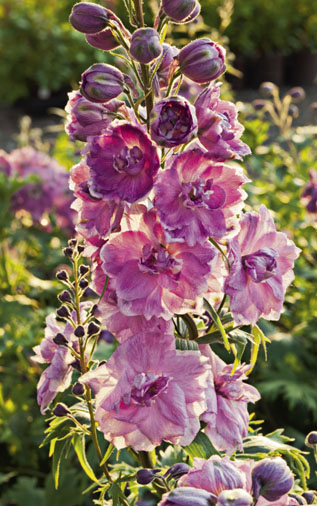
Delphinium ×elatum ‘Pink Punch’
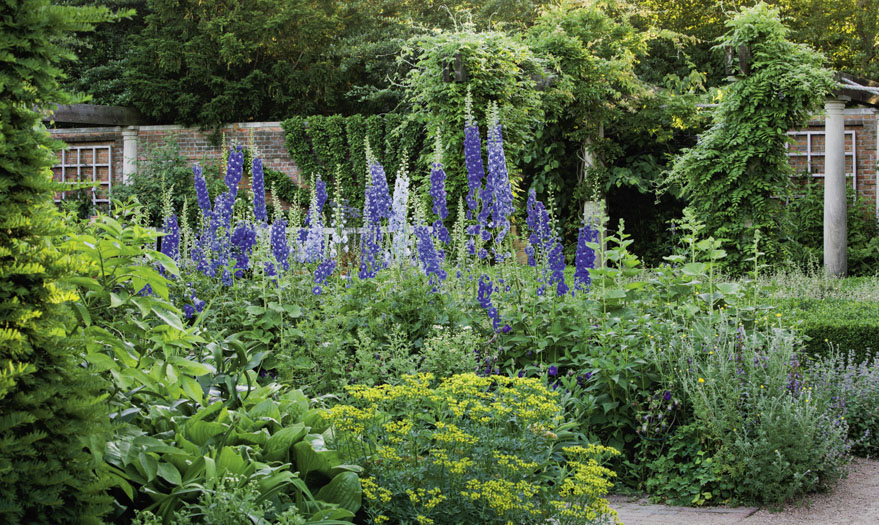
Delphinium ×elatum ‘Royal Aspirations’
Pacific Giant Strain is another favorite. True to their name, in perfect conditions these California-bred cultivars can reach a height of 8 ft. Semi-double, 3-in. blossoms in white, pink, lavender, and blue. Garden favorites since their introduction in the 1930s, the Pacific Giants have, according to experts, degenerated over the decades, losing vigor and the purity of their colors.
‘Princess Caroline’ has pink flowers. 24 in. tall.
‘Red Caroline’ represents a breeding color breakthrough, a border delphinium with double, true-red blossoms. Stems are 4- to 6-ft. Propagate vegetatively.
Delphinium grandiflorum
• blue
• spring to summer
• 1–2 ft. × 1–1.5 ft.
• sun
• Z3–8
Chinese or Siberian delphinium, Siberian larkspur. Russia and China. Forms compact, bushy mounds of deeply palmately divided, dark green leaves and loose, airy racemes of blue or white flowers. Typically short lived but self-seeds readily.
‘Blue Mirror’ bears gentian-blue flowers over a prolonged season.
Delphinium nudicaule
• red
• spring to summer
• 1–2 ft. × 1 ft.
• sun, part shade
• Z4–10, HS
Dwarf scarlet larkspur. California and Oregon. Single or double, long-spurred, orange-red flowers. Intolerant of winter damp as well as summer humidity, but appropriate in southern California. Often short lived.
‘Laurin’ has bright scarlet flowers.
• blue, white
• spring to summer
• 1.5–2 ft. × 1–1.5 ft.
• sun
• Z6–10, HS
Chinese delphinium. Western China. This bushy, compact species is suited to the front of a bed or border, or containers. Hirsute leaves are divided into three segments; 1.25-in. flowers borne in branched racemes. Start from seed.
Sky Lights Strain bears white, pale blue, or deep blue flowers. Blooms the first year from seed. 10–12 in. tall.
Delphinium tricorne
• white, blue-purple
• early spring
• 18–24 in. × 9 in.
• sun, partial shade
• Z7–4
Dwarf larkspur. Native to eastern and midwestern North America, this species blooms for three weeks in early spring. It bears 0.75- to 1-in., lavender-blue to dark purple flowers with white bees, with occasional all-white-flowered specimens. Prefers average to moist, humus-rich soils; self-sows readily before going dormant with summer’s onset. Attracts bees and butterflies, and ideal for wildlife or native plant gardens, and on the edge of light woods. Combine with wild sweet William seed.
Caryophyllaceae
pink
Although this genus of 350 species includes many with exquisitely beautiful and often sweetly scented flowers, until recently American gardeners have made little use of dianthus. Carnations (Dianthus caryophyllus) might be standbys in the cutting garden, and alpine gardeners have long prized the neat, cushion-forming species for their rock gardens, but the demanding nature of most cultivated dianthus—older types tolerated neither poor drainage nor summer heat and humidity—and their relatively short season of bloom made them infrequent choices for perennial gardens. Over the last couple of decades, however, plant breeders have successfully addressed these two limitations in their new introductions. As a result, dianthus is claiming increased space in our gardens, even in the muggy southeastern United States, where traditionally dianthus were grown almost solely as winter annuals.
The common name for these flowers—pinks—may seem to derive from the rosy hues so common among dianthus blossoms, but actually it is a reference to the petals’ frilly edges, which look as if they’ve been cut or “pinked” with a tailor’s pinking shears. Another old name is “clove pink”—the deliciously spicy scent common to these flowers formerly made them a popular ingredient for potpourri, and for flavoring wines and ales. Modern cooks garnish salads and other cold dishes with edible dianthus petals. Scent, fortunately, is one of the qualities emphasized by contemporary dianthus breeders who have introduced a number of hybrids with outstanding perfumes.
Borne singly or in few or many-flowered panicles, cymes, or heads, dianthus flowers are usually colored in shades of white and pink to red, often with a contrasting central eye. Pairs of grassy, often glabrous, blue-gray or gray-green leaves form dense mats or cushions that are commonly evergreen or semi-evergreen.
Dianthus require a well-drained soil, ideally with a neutral to alkaline pH; mulch with limestone chips if soil is acid. Poor drainage promotes root rot and rust. They grow best in full sun, though light afternoon shade can be beneficial where the sun is intense. Many of the new hybrids can be raised from seed and often bloom their first year. Deadhead routinely for possible bloom later.
Deer resistant and generally pest free, dianthus may suffer from powdery mildew in humid weather, especially where air circulation is poor. Compact forms provide neat edgings for the front of a border or bed, and they flourish if tucked into a soil-backed stone wall; mat-forming cultivars thrive if set into the cracks of a dry-laid stone pavement. Taller species make long-lasting cut flowers.
Propagate named cultivars by taking 2- to 3-in.-long cuttings from side shoots stripped off with a bit of the main stem (a heel) or from “pipings,” shoot tips snapped off at a node. Dianthus also layer easily.
• various
• late spring to late summer
• 10–18 in. high and wide
• sun
• Z3–10
Cottage pink, border carnation, Allwood pink. Of hybrid origin: Dianthus caryophyllus × D. plumarius. Tufted plants with grass-like, grayish green foliage. Solitary, single, semi- or fully double, 1.5- to 2-in.-wide flowers with pinked petals are often bicolored.
‘Agatha’ is compact, long lived, and cold hardy; semi-double, pink flowers with darker eye, and outstanding fragrance. 10 in. high and wide.
‘Alpinus’. Extra-compact plants form neat mounds of blue-green foliage beneath strongly perfumed, single flowers in shades of pink and red, often with contrasting darker eye. Early summer to frost. Available as seed. 6–9 in. tall.
‘Aqua’ has 12-in. stems bearing fragrant, double, white flowers.
‘Doris’ bears perfumed, semi-double, salmon-pink flowers with a deep rose eye.
‘Frosty Fire’ bears cherry red, double flowers flecked with white. Fragrant, drought and heat resistant. 12 in.
Dianthus amurensis
• lavender blue
• late spring to late summer
• 6–12 in. × 12–15 in.
• sun, part shade
• Z3–8
Amur pink. This compact species displays the toughness one would expect of a Siberian native. Long lived and drought tolerant once established.
‘Siberian Blue’ bears lavender-blue, 0.5- to 1-in.-wide blooms in small but abundant clusters over blue-green foliage; the flowers offer the closest to true blue found in this genus. Unscented, best in gritty soils, and ideal for rock gardens or containers.
Dianthus barbatus
• various
• late spring to early summer
• 1–3 ft. high and wide
• sun
• Z3–10
Sweet William. Southern Europe, Asia. A short-lived perennial or biennial that is often grown as an annual (especially in regions with hot summers). This cottage gardening favorite is useful for cutting and in sunny mixed borders. It bears dense, many-flowered, flat or domed clusters of single, semi-double, or double flowers in white through shades of pink to crimson; commonly multicolored. Often fragrant, individual flowers measure 0.5–1 in. in diameter. They attract bees, hummingbirds, and butterflies. Dark green, glossy, strap-shaped leaves. A source of long-lasting, strong-stemmed cut flowers; encourage prolonged bloom and preserve vigor of plants by cutting stems of fading flowers off at ground level to prevent seed set. Best in cool climates but tolerates heat where summers are dry.
‘Dunnett’s Dark Crimson’ has deep crimson flowers with a white eye.
‘Heart Attack’, one of the best cultivars for hot, humid regions, bears dark red, almost black, carnation-like flowers on 12- to 18-in. stems from early spring through summer. May persist for many years; unusually long lived for this species. Z4–8.
Indian Carpet is a dwarf strain, with flowers in white through shades of pink to red, often with contrasting bands. Late spring to summer. 6–12 in. Z3–9.
‘Newport Pink’ produces fragrant, single, coral-pink flowers that bloom from late spring through early summer. 18–24 in. × 2 ft. Z4–11.
‘Sooty’ has mahogany foliage and maroon flowers from spring through early summer. Fragrant. 12–18 in. × 9–12 in.
Dianthus deltoides
• various
• late spring to early summer
• 6–18 in. × 12 in.
• sun, part shade
• Z3–10, HS
Maiden pink. Northern Europe. Among the cold-hardiest dianthus, maiden pinks are exceptional for this genus because they thrive in partial shade. Forming loose mats of evergreen, narrowly linear to lance-shaped leaves, these plants are covered with 0.75-in., slightly fragrant flowers. Blossoms of unimproved specimens are typically deep pink with a darker band at the base of the petals. Shear off fading flowers for neatness, to prevent seed set, and to encourage rebloom in fall. Cover with evergreen boughs through winter in cold climates; crown rot may afflict plants grown on poorly drained soils. Excellent for rock gardens, edgings, and containers.
‘Confetti Cherry Red’ bears a profusion of candy apple–red flowers. Deadhead for fall rebloom. 6 in. tall.
‘Zing Rose’ bears deep rose-red blossom in late spring and, if deadheaded, again in fall. 6–12 in. ‘Zing Salmon’ is similar but with bright salmon-pink flowers.
Dianthus gratianopolitanus
syn. D. caesius, D. suavis
• various
• spring to summer
• 6–12 in. × 12 in.
• sun
• Z3–10, HS
Cheddar pink. Western and central Europe. Another cold-hardy dianthus that is sensitive to summer humidity, though some cultivars are more tolerant than others. Grassy, gray-green to blue-gray, evergreen foliage spreads in dense mats, making this species an outstanding choice for border edging, tucking in between the stones of a wall, or spilling down a sunny bank. Bears an abundance of solitary, single or double flowers in spring; shear off fading flowers and pinch back straggling foliage to promote dense growth and intermittent summer rebloom.
‘Bath’s Pink’ bears clove-scented, single, pink flowers marked with magenta ring; heat and humidity tolerant, thriving as far south as Atlanta. 1994 Herbaceous Perennial Georgia Gold Medal Winner. 8 in.
‘Feuerhexe’ (‘Firewitch’) grows 3–6 in. tall and to 12 in. wide. Cold hardy, but tolerates heat and humidity. Bears heavy crops of single, clove-scented, hot-pink blossoms in late spring. 2005 Perennial Plant of the Year.
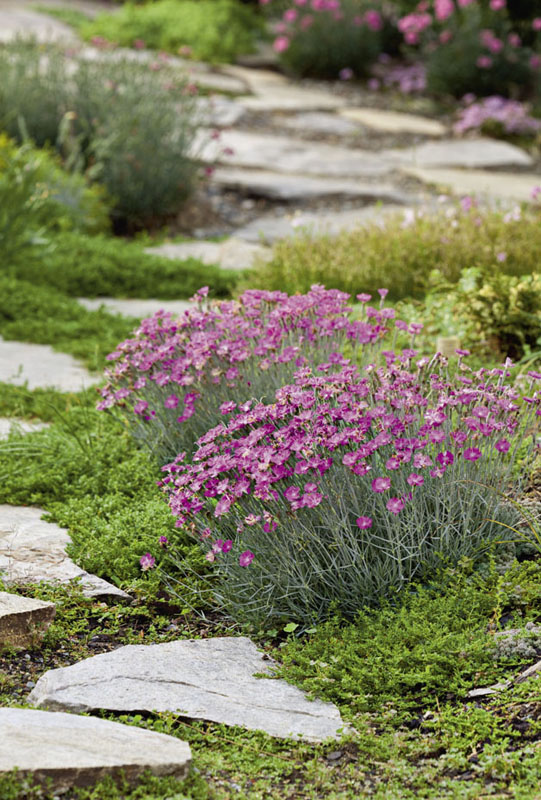
Dianthus gratianopolitanus ‘Feuerhexe’
‘Tiny Rubies’. Dense mats of deep green foliage, 10–12 in. across, covered with 4-in.-tall, tiny, double, unscented, deep pink blossoms. Tolerates heat and humidity. Beautiful as a groundcover or to edge a path.
‘Wicked Witch’ is a sport of ‘Feuerhexe’ that bears cherry-red flowers.
Dianthus knappii
• yellow
• late spring to midsummer
• 12–18 in. × 9–12 in.
• sun
• Z3–9
Hairy garden pink. Eastern and central Europe. The only yellow-blooming dianthus has 0.5- to 1-in.-wide flowers with no fragrance. Lanky stems, with an open growth habit, support fine-textured, pubescent, grayish foliage. Blooms during its first year from seed.
‘Yellow Harmony’ offers larger flowers and tidier, more upright growth than the species.
Dianthus plumarius
• various
• summer to fall
• 6–12 in. × 8–24 in.
• sun
• Z3–10, HS
Cottage pink, grass pink. This heirloom flower, brought to the United States from Europe in Colonial times, was a favorite of old-time cottage gardeners. Cottage pinks form loose tufts or mats of evergreen, blue-green foliage; in season it bears clusters of single or double, usually fragrant flowers, elevated 12 in. above the leaves. Long blooming, especially if deadheaded. A nostalgic addition to bouquets, cottage pinks make fine edgings for beds and borders, and thrive in sunny rock gardens. Requires a moist, humus-rich soil.
‘Birmingham’ bears fragrant, double, white flowers. Heat and humidity tolerant, and well adapted to the southeastern US gardens where it blooms in spring. Z4–8.
‘Cyclops’ has single flowers in red, pinks, and white. 12 in.
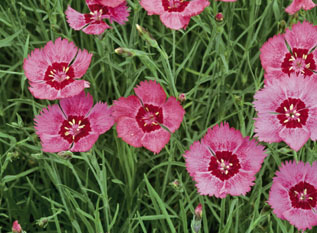
Dianthus plumarius ‘Cyclops’
‘Mrs. Sinkins’ has exquisitely perfumed, fully double, white flowers. Largely replaced by modern selections; the calyx tends to split causing the flower to “blow.”
Romance Mix produces single flowers in a wide range of pinks, many bicolored.
Sweetness Mix blooms the first year from seed, bearing sweet-scented flowers in shades of rose, pink, carmine, and white. Compact, excellent for containers and bedding. 4–6 in.
Dianthus superbus
• various
• late spring to early summer
• 12–30 in. × 24 in.
• sun
• Z4–8, HS
Lilac pink. This Eurasian native performs as a short-lived perennial or biennial. Grass-green tufts of narrow, evergreen leaves are borne on lax, branching stems. Fragrant, lacy-edged, 1.5- to 2-in., single flowers, paired or solitary, range in color from pink to mauve. Prefers a rich, moist soil. Reseeds readily.
‘Crimsonia’ is more compact than the species with fragrant, crimson blossoms on 20-in. stems.
‘Primadonna’ bears bright pink, perfumed flowers with lacy-edged petals.
Scrophulariaceae
twinspur
Despite the fast-growing popularity of these long-blooming flowers, most gardeners mistakenly believe that all diascias are annuals. In fact, though many of the 75 members of this genus are indeed annuals, others perform as perennials in the warmer regions of the United States. At least one species is reliably perennial as far north as Hartford, CT, Cincinnati, OH, and Spokane, WA.
Natives of southern Africa, where rain falls in summer, twinspurs provide fine-textured mounds or mats of glossy green foliage and a succession of vivid flowers that continues for weeks or even months on end. The 1-in. leaves are ovate and toothed; the five-lobed flowers resemble those of snapdragons, except that each twinspur blossom sports (as the common name indicates) not one but two spurs. The flowers cluster at the stem tips.
Their sprawling habit of growth makes diascias ideal for spilling out over the edges of a border, over the lip of a container, or tucked in among stones in a rock garden. Some selections are more upright. Though sensitive to cold, diascias are heat hardy, tolerating intense sun as long as they are provided with sufficient water. Soil should be fertile, humus-rich, and well drained.
Twinspurs provide abundant color in the garden especially during spring and fall when night temperatures are still cool. They mix well in containers and in the landscape, notably with late spring bulbs and early alpine perennials, including rock cress and perennial candytuft. Other good companions include heucheras and heucherellas for their foliage throughout the season, miniature hostas, bacopas, and small ferns. In window boxes they are charming with calibrachoas, verbenas, and trailing ornamental oreganos.
Cut back in late winter or early spring to promote new growth. Deadhead regularly and pinch off branch tips periodically to encourage continued flowering and bushier growth. Diascias are rarely troubled by insects or diseases, but are vulnerable to snails and slugs; deer and rabbits leave them alone.
Propagate by soft cuttings of young growth or sow seed directly into the garden one to two weeks before the local last-frost date; alternatively start indoors six to eight weeks earlier.
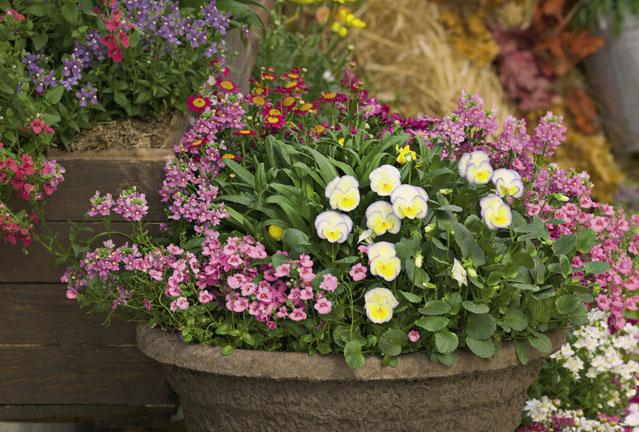
Diascia ‘Wink Pink Imp’
Diascia barberae
• pink
• midspring to fall
• 9–12 in. × 12–18 in.
• sun
• Z8–11
Twinspur. Mountains of southern Africa. Perennial where winter temperatures seldom drop below 10°F; they are grown as annuals in colder regions. Flowers, to 0.75 in., are pink with yellow throats. When bloom flags in summer heat, shear plants to promote another flush in fall.
‘Genta Giant Pink’ is compact with large, pink, snapdragon-like flowers. Excellent for containers and as a groundcover. The Genta Series from Israel has stronger stems and is more upright than some strains.
Diascia integerrima
syn. D. integrifolia
• pink
• spring to fall
• 18 in. × 30 in.
• sun, part shade
• Z6–10
Hardy twinspur. A native of southern African mountains and thus an unusually cold-hardy species. It forms an upright clump of wiry, branching stems; the narrow leaves are mostly basal, with a few smaller ones up the stems. The pink flowers, up to 0.75 in. across, are borne in terminal racemes. They open in sequence over a long season, from the bottom progressing upward with new buds continually forming at the stem tips. Protect from full sun in hot climates.
‘Coral Canyon’ bears coral flowers with darker pink centers. Very long blooming. Tolerates dry soil. 15 in. × 18 in.
‘Pink Adobe’ bears pale salmon-pink flowers, maroon at the throats. Appropriate for xeriscapes. 15 in. × 18 in.
Diascia rigescens
• pink
• summer to fall
• 10–12 in. × 15–20 in.
• sun, part shade
• Z7–9
Twinspur. Southern Africa. Trailing with semi-upright, branching stems clothed with heart-shaped leaves, toothed along the edges. Flowers are in various shades of pink, arranged along the stems in close erect spikes.
Other Notable Cultivars
There are numerous cultivars, with many more appearing on the market annually. Many of these have resulted from new technology applied to plant breeding, including tissue culture.
‘Blue Bonnet’ has pink flowers flushed with blue. 8 in. × 2 ft. Z8.
Flirtation Series, currently only with pink or orange flowers, promises self-cleaning plants that do not require deadheading. However, when bloom decreases in response to hot nights, a shearing keeps the plants neat and encourages a further flush of bloom when nights cool. 8–12 in. Z7–10.
Flying Colors Hybrid Series offers flowers in a range of pinks, apricot, and red on compact, heat-tolerant plants. Plants tolerate light fall frosts. Z8–9. A Proven Winners introduction.
Picadilly Series was introduced from Holland and includes blues and lilac.
‘Ruby Field’ has masses of strong salmon-pink flowers from summer to fall. 10 in. × 24 in. Z8–9.
Sun Chimes Series offers large, coral, rose, blush-pink, peach, and coppery-purple flowers on mounded plants. The rose- and red-flowered selections are trailing types; excellent for hanging baskets. Z8–9.
Wink Series blooms abundantly all season in containers and in the landscape. Flowers are sterile and self-cleaning. Cold tolerant. 10–12 in. Z5–8.
Fumariaceae
bleeding heart
Bleeding hearts are one of the cottage garden plants that many of us remember from the gardens of our youth, and the virtues that made them popular then are just as relevant today. Indeed, the breeders have been busy with this genus, so there are many more cultivars from which to choose.
Several species of bleeding heart are native to North America; in the wild, they are usually found growing in partly shaded, damp spots among trees. The leaves are deeply divided and they often have a bluish cast that contrasts appealingly with the colorful flowers. The heart-shaped, mostly pink or white flowers are charmingly dainty, with inner petals protruding from the outer ones. Both flowers and leaves are carried on brittle, succulent stems.
Provide bleeding hearts with humus-rich, well-drained, moisture-retentive soil. Some selections tolerate sun well, especially in cool-summer regions, although only a few are happy in heat and humidity. As a group, they are best in light or partial shade, always with damp but not waterlogged soil.
Compatible companions for bleeding hearts include woodland natives such as bloodroot, columbines, Christmas fern, and wide blue sedge. Appropriate non-natives include spring bulbs, hellebores, lungworts, and hostas; lily-of-the-valley also mixes well. Bleeding hearts are excellent for brightening up beds and borders in spring, as a skirt around flowering shrubs, and for the edges of woodlands and paths. Compact selections are in scale in rock gardens and raised beds. Butterflies and hummingbirds often forage the flowers and foliage of bleeding hearts, making them appropriate for planting in wildlife gardens. Resistant to deer and rabbits.
Propagate by seed sown in containers as it becomes ripe or in spring. Divide named cultivars in early spring.
Dicentra cucullaria
• white
• early spring
• 6–9 in. × 9 in.
• part shade
• Z3–7
Dutchman’s breeches, stagger weed. Native to open clearings in the woods from Nova Scotia south to North Carolina, and west to Kansas. Small, white tubers give rise to blue- green, finely dissected leaves that disappear quickly after bloom time. Spurred, white, 0.5-in. flowers, shaped like baggy, upside-down Dutchman’s trousers, are arranged on short stems along arching, pinkish stems. Needs humus-rich soil. Toxic to livestock, but formerly used as a remedy for syphilis. Squirrel corn, Dicentra canadensis, is similar, but has less ferny foliage and heart-shaped, white flowers. Avoid planting too deeply. Becomes dormant shortly after blooming.
Dicentra eximia
• pink
• late spring to fall
• 12–24 in. × 18 in.
• part shade
• Z4–9
Fringed bleeding heart, turkey corn. Native to rich woodlands of the eastern United States, especially in the Appalachian region. Mounds of finely dissected, 6- to 18-in.-long, gray-green leaves rise from scaly, fleshy rootstocks and persist through the season if kept moist. Each arching, pink-tinged stem bears several nodding, rosy-pink, heart-shaped flowers on short pedicels (flower stems). The 1-in.-long flowers are produced for several weeks and then sporadically till fall. Seeds about. In the garden, plant with columbines, wild gingers, lungworts, woodland phlox, and other spring shade lovers. There has been a great deal of hybridization between this species and the western or Pacific bleeding heart, Dicentra formosa; many selections may be hybrids, although attributed to one species or the other. Other species are also involved.
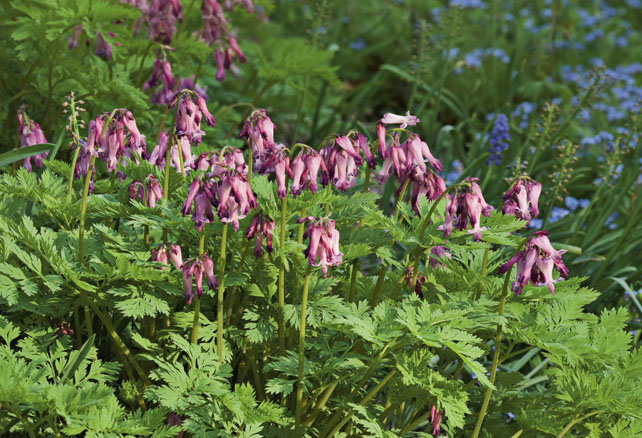
Dicentra eximia
‘Alba’ produces mounds of bright green, cut leaves and white flowers tipped with yellow. 12–30 in. Z3–9.
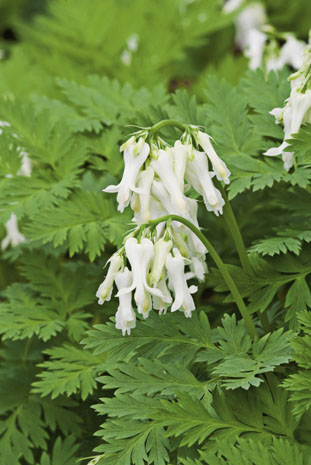
Dicentra eximia ‘Alba’
‘Bacchanal’ has dusky red flowers in mid- to late spring. Gray-green leaves. 18 in. Z3–9.
‘Dolly Sods’, an introduction from Plant Delights Nursery in North Carolina, has pale pink flowers and is reputed to be the most heat tolerant of the bleeding hearts. Suitable for regions with hot, humid summers. Z3–8.
Heart Series, bred in Japan, has produced the following superior compact selections, all with lacy, bright blue-gray leaves. ‘Burning Hearts’ has deep rosy-red, heart-shaped flowers rimmed with white. 10 in. ‘Ivory Hearts’ has clean white flowers. 12 in. ‘Candy Hearts’ blooms with deep rose flowers. 6–12 in. All must remain damp in summer, and bloom longer with routine deadheading to the base. Z5–9.
‘King of Hearts’ has carmine flowers above compact, 6-in. foliage mounds in late spring. This older selection has similar genetics to the Heart Series. 9–18 in. Z3–8.
‘Langtrees’ is possibly the best white. Charming delicate clusters of white hearts contrast with finely dissected, gray leaves. 12 in. Z4–8.
‘Luxuriant’ is a popular selection for its late spring, cherry red flowers and bluish leaves. Very long blooming; sterile. Tolerates summer heat only if kept moist. 12–18 in. Z3–9.
‘Stuart Boothman’ (‘Boothman’s Variety’) has wonderful dissected, 4- to 8-in.-long, strong blue-green leaves that contrast beautifully with 0.5- to 1-in., deep rose flowers. 12 in. Z3–9.
‘Zestful’. Deep rose flowers above ferny, blue-green foliage. Almost nonstop blooming, even through warm weather if kept moist. 12–18 in. Z3–9.
Dicentra formosa
• pink, red
• early spring to early summer
• 15 in. × 18 in.
• sun, part shade
• Z3–8
Western bleeding heart, Pacific bleeding heart, lyreflower. Native to moist woodlands, along streambanks, and in meadows from northern California to British Columbia—but not to Formosa; the specific epithet means “beautiful.” Similar to Dicentra eximia, spreading by underground rhizomes, this species colonizes quickly but not invasively. Rosy mauve-pink flowers hang from brittle, succulent stems; the basal foliage is finely dissected and bluish green. A nectar plant for hummingbirds and adult Clodius Parnassian (Parnassius clodius) butterflies and a larval plant for the caterpillars; ants spread the seeds. Valued in folk medicine in spite of all parts of the plant being toxic. Divide when dormant.
‘Aurora’. More compact and possibly superior to ‘Alba’, with longer-blooming white flowers above mounds of ferny, blue-green leaves. Spring to summer. 12–15 in.
‘Sweetheart’ has white flowers. 15 in.
Rutaceae
gas plant, burning bush
This genus is composed of a single species. Its common names refer to a phenomenon often described but seldom actually witnessed: reportedly, the inflammable oil that gives the foliage its lemon scent volatilizes in hot weather, and on a still summer afternoon may supposedly erupt in a flash if ignited with a lit match. Fortunately, this is the least of the plant’s attractions.
Gas plant is easygoing, growing in any average, well-drained garden soil, though it prefers a moist, fertile, and organic-rich one. Best adapted to full sun, it also tolerates light shade, and though slow to mature—it may take several years for a seedling to reach the flowering stage—once established in the garden it is very long lived and requires little maintenance.
Planted singly or massed in a border, herb, or cottage garden it makes an imposing statement; it blends well with daylilies, campanulas, and irises. Pests, including deer, and diseases rarely afflict gas plant seriously. Contact with its foliage may cause a rash in some individuals.
Propagate by seed, planting the new seed as soon as it ripens. Once this taprooted plant is established, it resents disturbance, making division and even the transplanting of mature plants risky.
Dictamnus albus
syn. D. fraxinella
• white, pink, red, lilac
• late spring to early summer
• 2–3 ft. × 1.5–2.5 ft.
• sun
• Z3–8
Gas plant, burning bush. Native to southwestern Europe, and southern and central Asia to China and Korea. Upright clumps of erect, rigid stems that typically don’t require staking. The foliage is light green, glossy, and pinnate with an elegant appearance, and releases a lemon scent when bruised or crushed. Showy five-petaled, 1-in. flowers have prominent wispy, upcurving stamens, and are borne in racemes at the stem tips; they may be mauve, pink, or white, etched with purple veins. Attractive star-shaped seedheads follow.
var. purpureus bears flowers that are pale to deep purple-pink, with darker veins.
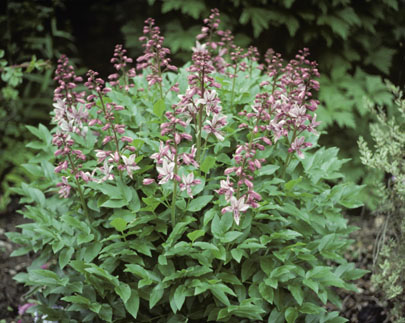
Dictamnus albus
Iridaceae
wand flower
These natives of South African grasslands and mountain meadows are not as widely cultivated in the United States as they might be, although several mail-order nurseries carry some of the species. Wand flowers follow a pattern of growth similar to that of their relatives, the crocosmias: they form bulb-like, underground stems called corms that on a hospitable site multiply over the years to make a gradually increasing group of plants. The linear, deep green, 36-in. leaves are grassy and somewhat stiff, and from mid- through late summer they are topped with elegant arching flower stems. These are furnished with spikes of funnel- or bell-shaped flowers that hang on hair-like threads and sway in the slightest breeze, like some exquisite catch dangling from a fishing rod—hence the other common names: angel’s fishing rod and fairies’ fishing rod.
Wand flowers are most attractive as specimens tucked in between paving stones or clustered beside ponds and pools. They also show well when grouped or massed in sunny beds and borders. Wand flowers grow especially well in the Pacific Northwest. Where winters are too cold for them to grow as perennials outdoors, they make great subjects for containers; bring the pots indoors to overwinter as for dahlias and gladioli. Wand flowers are also good conservatory, cool greenhouse, or sunroom subjects.
Plant corms in spring when the soil has warmed, about 3–5 in. deep. A sheltered, sunny spot where the soil drains well but is humus rich is ideal. Keep well watered during the growing season. Delay cutting back scruffy foliage until new growth emerges in spring. Pests and diseases are seldom a problem. Usually considered to be rabbit and deer resistant, although some have reported extensive browsing by deer.
Propagate by division in spring; these plants resent disturbance and may take a couple of years to bloom after division. Species may be started from seed, sown as soon as it is ripe, and overwintered in a cold frame or other protected spot; seedlings require as much as six to seven years of growth before blooming.
Dierama dracomontanum
syn. D. pumilum, D. hernia
• coral
• midsummer
• 24–30 in. × 12–24 in.
• sun
• Z8–10
Dragon mountain wand flower, Drakensberg hairbell. From grassland regions of the Drakensberg mountain range. This compact species has coral or even brick-red, flaring trumpet flowers, above a tuft of stiff grassy leaves.
Dierama pulcherrimum
• pink
• mid- to late summer
• 4–6 ft. × 3 ft.
• sun
• Z7–10
Fairy’s wandflower, African hairbells. Zimbabwe, southern Africa. Evergreen tufts of 3- to 4-ft.-long, strappy, 0.5-in.-wide leaves rise from the ground and, in time, develop into substantial clumps. High above the leaves, elegant wiry stems bear delicate, tubular, bell-shaped, 1-in. flowers of pink, magenta, and sometimes white. Each stem may carry 12 to 15 of these flowers, each suspended by a hair-like thread. Keep well watered during the growing season, but allow to dry off if possible during dormancy. Do not cut back foliage in winter.
‘Album’ has flared, pure white flowers.
‘Blackbird’ has dark wine-purple flowers dangling from 3-ft., arching stems.
‘Silver Dawn’ has blush-pink flowers.
Slieve Donard is a mixed strain with flowers in various shades of pink, wine, and red. 3 ft. tall.
Iridaceae
Cape iris
These beautiful iris relatives make valuable additions to beds and borders throughout the warmer regions of the United States. Native to open grasslands and bush, mountain cliffs, and damp forest edges in Africa and Australia. They have rhizomatous roots from which spring erect, sword-shaped basal leaves that are tough and leathery, arranged in narrow fans like those of German irises. The flowers are iris-like as well, flattened and borne on branched stems; the lifespan of individual flowers is short, but they open in bursts.
Cape iris tolerate a wide range of soils, even poor, dry ones, though they grow best in soils of average fertility. Good drainage is a must, for the roots and crown of these plants soon rot in persistently damp soils, or even if habitually overwatered. They flourish in sun or partial shade, with the latter being better in regions of intense sunlight. In colder climates Cape iris may be cultivated in containers in sunrooms and conservatories. Pot them into a well-drained, soil-based mix and water freely during bloom time; allow to dry off as the plants become dormant.
To propagate, sow seed in spring or fall, or divide the rhizomes with a foliage fan after flowering.
Dietes grandiflora
• white
• spring to summer
• 3–4 ft. × 4 ft.
• sun, part shade
• Z9–11
Wild iris, fairy iris. Grows along the margins of forests in the Eastern Cape of South Africa. Forms large clumps of stiff, sword-like leaves, up to 3 ft. in length, that rise in fans from underground stems. Slender, upright, 3-ft. stems carry lovely 4-in.-wide, white flowers that are blotched with yellow, and have lavender-flushed styles. Large seed capsules follow and split to reveal polished, brown seeds. The blooms come in flushes of flowers, each blossom lasting a day or two. Butterflies and pollinating insects are attracted to the blooms. Tolerant of urban pollution and poor growing sites close to highways and in shopping centers. Mass or use as an accent plant in containers, beds, and borders.
Dietes iridioides
syn. Moraea iridioides, D. vegeta
• white
• late spring to summer
• 18–24 in. × 15 in.
• sun, part shade
• Z8–11
Fortnight lily. This species from southern and east African grasslands produces its countless yellow-blotched, white flowers with lavender-flushed styles from spring into summer. The evergreen basal leaves, to 24 in. long, are dark green and remain attractive after bloom time. Do not cut back the fans of foliage except to remove shabby leaves. Tolerates light shade well.
Plantaginaceae
foxglove
This genus, formerly included in the Scrophulariaceae, includes both perennials and biennials—though because the biennials commonly reseed to reemerge as volunteers year after year, they too function as durable additions to the garden. Whatever their lifespan, foxgloves, with their carillons of bell-shaped blossoms, define old-fashioned charm and grace, and are stars of any cottage or wild garden that happens to host them.
Perhaps it is due to their role in folk medicine—foxgloves are a source of digitalin, a potent drug for the treatment of a variety of cardiac conditions—that the flowers were traditionally associated with fairies and the supernatural in their European, northwest African, and western Asian homelands. The presence of this drug makes the plants toxic, which in turn makes them unfit for a garden with children but also resistant to deer and rabbits.
When started from seed, foxgloves form basal rosettes of foliage during their first year of growth, sending up their tall spikes of flowers the following spring or summer. Removing the flower stalk after its blossoms fade encourages the production of side shoots and a second, smaller flowering. This treatment, however, reduces the amount of seed the plant produces and so discourages self-seeding. Rich, moist, well-drained soil is best for foxgloves, and in hot, sunny regions they prefer a site with some afternoon shade. They are sometimes susceptible to powdery mildew and leaf spot, aphids, mealybugs, slugs and Japanese beetles, and will not tolerate waterlogged conditions in winter.
Foxgloves’ vertical habit of growth makes them valuable punctuation for more spreading perennials, especially those that also favor partial shade such as hostas, astilbes, heucheras, and alchemillas; planted in groups, foxgloves show up well against a backdrop of shrubs or a wall. Foxgloves are attractive to hummingbirds and pollinating insects, and make striking cut flowers.
Propagate by seed, or by division of established plants in spring or fall.
Digitalis ferruginea
• brown, white, yellow
• midspring to early summer
• 3–5 ft. × 1–1.5 ft.
• sun, part shade
• Z4–8
Rusty foxglove. A biennial or short-lived perennial, native from southern Europe to the Caucasus. Leaves are deep green, crinkled, and borne in a basal rosette; the pendulous to horizontal, tubular flowers are 0.75–1.5 in. in length, creamy yellow to honey brown with rusty veining inside. Requires a consistently moist though well-drained soil. Excellent for woodland gardens or moist meadows.
‘Yellow Herald’ (‘Gelber Herold’) reaches a height of 5 ft., and bears pale yellow flowers.
Digitalis grandiflora
syn. D. ambigua, D. orientalis
• yellow
• midspring to early summer
• 2–3 ft. × 1–1.5 ft.
• sun, part shade
• Z3–8
Yellow foxglove. Native to woods and stream banks from Europe to western Asia, this species thrives with a moist, organic-rich soil, but also tolerates dry shade. It produces a basal clump of fine-toothed, semi-evergreen foliage, from which emerges a tall stalk of soft yellow, 1.5- to 2-in., bell-shaped flowers that are speckled brown inside. Digitalis lutea, straw foxglove, also has yellow flowers but these are quite small, on 2-ft.-tall plants.
Digitalis purpurea
• pink, purple, white
• midspring to early summer
• 2–5 ft. × 1–2.5 ft.
• sun, part shade
• Z4–8
Common foxglove, Mary’s thimble. Native throughout much of Europe, this species is biennial and produces a basal rosette of light green, oblong leaves in the first year’s growth; the flowers are borne the second year in terminal, one-sided racemes atop leafy spires. Closely spaced, the individual flowers are pendulous, 2–3 in. long and tubular; they are colored dark rose-pink to purple, or occasionally white with purple and white spots marking the interior—like landing lights at an airport showing the way to the nectar for pollinating bees. Common foxglove reaches its peak about the same time as roses begin to bloom and provides an elegant counterpoint to those shrubs. They are also attractive with columbines, blue stars, and peonies.
‘Pam’s Choice’ has large, white bells heavily marked with deep maroon inside the lower lip and on the throat. One-sided spikes. A special favorite of hummingbirds.
‘Sutton’s Apricot’ has apricot-pink flowers. Comes true from seed.
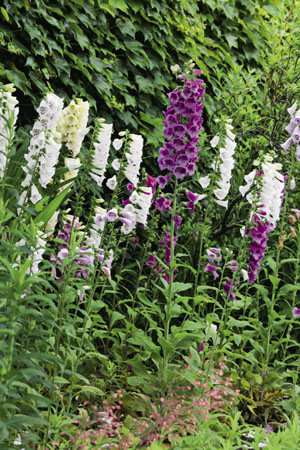
Digitalis purpurea
Other Notable Cultivars
×mertonensis, the “strawberry foxglove,” bears spikes of coppery rose flowers in midspring to early summer. 3–4 ft. Z4–8.
Camelot Hybrids are extra tolerant of sun and heat. They bloom the first year from seed with rose, pink, lavender, white, or cream flowers. 3–4 ft. Z3–8.
Excelsior Hybrids bear flowers all round the stems in shades of yellow, pink, apricot, purple, and white. 5 ft. Z4–8.
Foxy Hybrids are compact, to 2–3 ft., and carry flowers in pastel shades of purple, pink, red, cream, yellow, and white. Blooms in five months from seed, in its first year if started early indoors. Z4–8.
Polkadot Hybrids have extra-large flowers in rose, light apricot with a yellow interior, or dark apricot. Flowers are sterile (produce no seed) so the season of bloom is prolonged and the plants are reputed to be more reliably perennial. To 3–5 ft. Z4–8.
‘Spice Island’ has large, apricot-peach flowers dusted with light brown. They are carried in dense spikes throughout the summer. Plants are strongly upright and branch well. Evergreen. 1–2 ft. Z4–9.
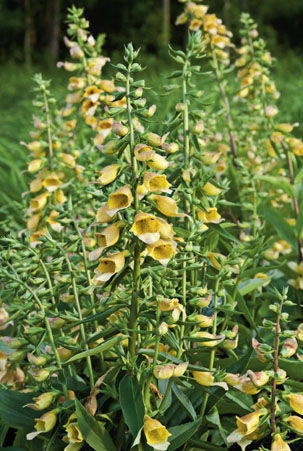
Digitalis ‘Spice Island’
Berberidaceae
umbrella leaf
This much-neglected genus is perfect for shaded woodland areas of the garden where its various species mix well with other woodlanders including white baneberry, bleeding hearts, blue cohosh, wild gingers, and primulas. Umbrella leaf is an apt name for these close relatives (and lookalikes) of May apple. Arising from stout rhizomes, umbrella leaves produce stout stems that serve as the central supports of large, peltate leaves; several clumps together look like a small army of 2-ft.-tall, green umbrellas in the woods. In spring the plants bear clusters of short-lived, small, white flowers that are followed by blue berries.
Soil should be moist but not necessarily boggy, and high in humus. A sheltered location with part shade is ideal. Deer and rabbits usually—but not always—ignore this species. The two Asian species are seldom seen in the United States.
Divide in spring or start from seed; seedlings take two to three years to reach blooming size.
Diphylleia cymosa
• white
• late spring
• 2–3 ft. × 1–2 ft.
• part shade, shade
• Z4–7
American umbrella leaf. Native to damp, shaded woodlands of the southern Appalachians, this fine plant deserves a much wider audience. The stout, jointed rhizomes produce a single, cleft leaf, perhaps 24 in. across; each of the rounded, deeply lobed segments is toothed along the rim. The flower stems bear two smaller but deeply two-lobed stem leaves (to 15 in. across) and end in an upright, umbel-like flat cluster of up to ten or more 0.5-in., six-petaled, white flowers. The 0.5-in. berries that follow are bright dusty blue and quite showy on red stalks. Umbrella leaf is a great addition to shaded native plant and wild gardens, or among shade-loving shrubs, perhaps with fern companions.
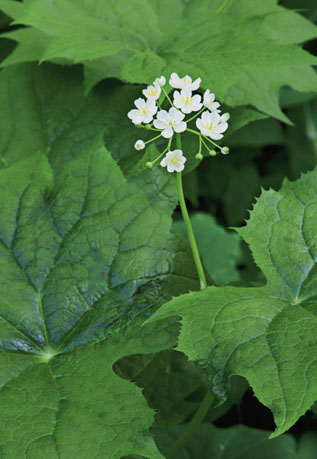
Diphylleia cymosa
syn. Diplarrhena
Iridaceae
flag iris
This genus includes two Australian species, which, despite being popular as garden perennials in their native country, are too little used in the United States. Flag irises are lovely in sheltered borders, and benefit from being set close to the house for extra warmth, even in warm zones. Combine them with shrimp plant, justicias, and Melianthus (honey bush) for foliage and flower contrast. In regions where they aren’t reliably hardy, grow flag irises in containers in a sunroom or greenhouse, and set them outside in summertime.
Pests and diseases are seldom serious. Deer seem to ignore these plants.
Divide clumps in spring or start from seed with protection in spring or fall.
Diplarrena latifolia
• white
• early summer
• 3 ft. × 2–3 ft.
• sun, part shade
• Z8–10
Western flag iris. This Tasmanian native is similar to but slightly more cold tolerant than Diplarrena moraea; reportedly hardy to 18°F. It is also taller, with wider, lance-shaped leaves and longer flower scapes (leafless stems). The flowers are white with yellow and purple splashes at the centers.
• white
• early summer
• 24 in. × 14 in.
• sun, part shade
• Z9–10
Butterfly flag iris, white iris, butterfly flag. Native to Tasmania and southwestern Australia. Forms clumps of slender, evergreen, iris-like foliage springing from rhizomatous roots. In season, these sprout wiry scapes that bear clusters of three to six honey-scented, 1- to 2-in., white flowers, just above the foliage. Each flower has three rounded, white outer petals and three smaller inner petals that are white and yellow, commonly marked with purple. Prefers moist but well-drained, humus-rich, sandy soil; tolerates slight frosts. A reliable and attractive addition to cottage gardens, meadows, and rock gardens; the neat, evergreen foliage makes this useful for container displays perhaps with trailing morning glory vine and ‘Diamond Frost’ euphorbia.
Convallariaceae
fairy bells, Solomon’s seal
This genus of Asian woodland natives offers a number of fine garden perennials. Until recently, it also included half a dozen North American natives as well, and though botanists have renamed these as Prosartes and reclassified them as members of the lily family, these species are still commonly sold under their former names, so we’ve kept them here.
These are not flamboyant plants; their attractions, though considerable, tend more to the discreetly elegant. Their bell-shaped or star-shaped blossoms are modest, but they are combined with attractive foliage and berries; their adaptation to shade makes them very useful for shady borders and woodland gardens. When selecting a site for fairy bells, dappled sunlight is ideal, but they do tolerate full shade. They prefer humus-rich, moist but well-drained soils with a somewhat acid pH—they do not tolerate drought. Thanks to their rhizomatous root systems, fairy bells tend to spread once established, although they do so at a manageable rate, making them valuable groundcovers. They are natural companions for other shade lovers such as hostas, astilbes, and ferns.
Propagation is by seed, sown in the fall and overwintered in a cold frame or other protected spot, or by division of mature plants in early spring.
Disporum cantoniense
• white
• midspring to early summer
• 4–6 ft. × 2–3 ft.
• part shade, shade
• Z5–9
Cantonese fairy bells. A highly variable Chinese species that has upright or arching stems bearing lanceolate, green, variegated, or even purple leaves, typically 5 in. long and 2 in. broad. White, pale yellow, or even red flowers. Noted plant explorer Dan Hinkley has introduced two outstanding cultivars:
‘Green Giant’ produces bamboo-like shoots that emerge in shades of pink, white, and green, before maturing to deep green. Fragrant, creamy-white, bell-shaped flowers followed by black fruit in fall. 6 ft. Z7–9.
‘Night Heron’, whose leaves open a lustrous deep red-burgundy in spring before fading to greenish purple in summer. Creamy, bell-shaped flowers are borne in terminal clusters atop 5- to 6-ft. stems, and are followed by glistening black-purple fruit. Z5.
Disporum flavens
• yellow
• early to midspring
• 24–30 in. × 9–12 in.
• part shade, shade
• Z5–8
Fairy bells. A Korean species that forms a slowly spreading clump. Lanceolate leaves may reach 6 in. long; flower buds appear at the stem ends with the new growth in spring, opening into small clusters of tubular, 0.5- to 1-in.-long, soft yellow flowers. Berries that ripen to black in late summer follow the flowers; fall foliage color can be an attractive yellow.
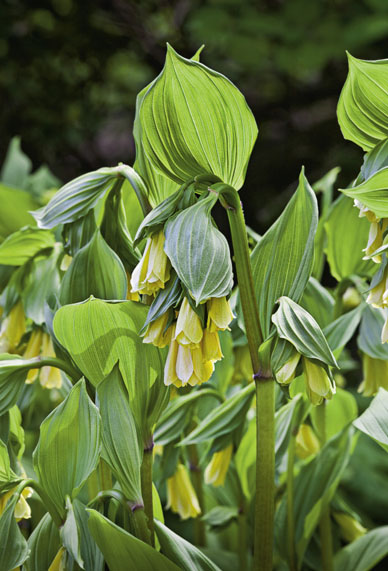
Disporum flavens
syn. Prosartes lanuginosa
• yellow
• early to late spring
• 1–3 ft. × 1 ft.
• part shade, shade
• Z4–7
Yellow fairy bells, yellow mandarin. Native from Ontario south through Appalachian region to Alabama. Forms patches of delicately branched, zigzagging stems bearing ovate, glossy green leaves to 6 in. long and 2 in. wide, with prominent veins from base to tip. Flowers, that may reach up to 0.8 in. long, are yellow-green, nodding, and bell shaped, flaring at the mouth. Bright red berries follow in fall.
Disporum sessile
• white
• early to midspring
• 2 ft. × 3 ft.
• part shade, shade
• Z5–8
Japanese fairy bells. This eastern Asian native requires an evenly moist, rich, acid soil. Where these conditions are met, growth tends to be rapid, developing into dense clumps of stemless, lanceolate, bamboo-like foliage. Showy, white, bell-shaped flowers dangle from stems. Good for the front of the border and edgings as well as woodland gardens.
‘Variegatum’ is compact, with white-and-green-striped flowers and foliage. To 16 in. tall.
Primulaceae
shooting star
This group of simply beautiful, ephemeral native plants blooms in spring, but when hot weather begins they go dormant and escape the heat underground. The best-known species is common shooting star, Dodecatheon meadia, a midwestern and eastern US native. Several other species are western US natives, with many from the Pacific Northwest. Tricky to grow and rarely available, these are cherished by specialist gardeners, particularly alpine plant enthusiasts. Be sure to purchase plants from reputable dealers who propagate their stock, rather than digging it from the wild, as wild populations are endangered in some states.
Typically, shooting stars produce a basal rosette of smooth, spatulate leaves, from which rises a naked stem (scape) topped with an umbel of charming pendent flowers like upside-down cyclamen. The number of flowers per stem varies, but may reach seven to ten or more. Each “shuttlecock” flower points downward with protruding, prominently pointed stamens and anthers like a beak. A spot shaded from noon and afternoon sun is best, where the soil remains moist but is not wet or waterlogged. Plant shooting stars along shaded pathways, in rock gardens, or in native and light woodland gardens. They also do well in troughs and other containers.
Propagate by division in spring, after flowering but before summer dormancy, or by seed sown as soon as it is ripe and allow it to overwinter outdoors. Seedlings require up to six years to reach blooming size.
Dodecatheon meadia
syn. D. pauciflora
• pink, white
• spring
• 12–24 in. × 6–12 in.
• sun, part shade
• Z4–8
Shooting star, Ohio shooting star, American cowslip. Native to glades, woodlands, and rocky bluffs from Wisconsin, east to Pennsylvania, Virginia, and further south, where they are shaded from intense sun and soil remains moist during the growing season. Tolerates alkaline soils. Thick, fleshy, and smooth basal leaves yellow and die as bloom time ends and plants enter summer dormancy. The lightly fragrant flowers range in color from white through pinks to a deep purplish pink, and are 1 in. long with strongly reflexed or swept-back petals, a yellow ring at the mouth, and exserted brown stamens. Attractive to foraging bees for their pollen. Plant in drifts or groups, but plan ahead for the foliage to disappear in summer. Christmas and other ferns, fringed bleeding hearts, partridgeberry, and maple-leaved alumroot are excellent companions. Reportedly resistant to deer and rodents.
‘Alba’ has pure white flowers
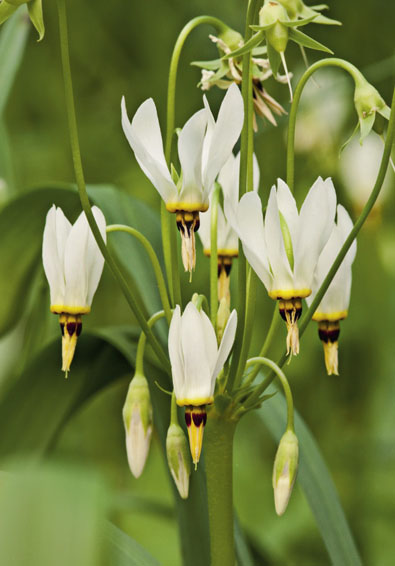
Dodecatheon meadia ‘Alba’
‘Aphrodite’ is a “good doer,” vigorous with purplish pink flowers on 18- to 24-in. stems. Possibly a hybrid.
‘Queen Victoria’ is showy with larger, light purplish pink flowers on red stems. Sterile.
Asteraceae
leopard’s bane
If you seek variety to spice up the spring garden, something to add distinction to the usual mix of bulbs and pansies, the yellow, daisy-like flowers of leopard’s bane could be your answer. Leopard’s banes are easy to grow, although in hot climates, they will retreat into dormancy in summer. In such areas, placing them where they are protected from the midday sun and keeping their roots moist can help to maintain a foliage presence until fall. However, it’s probably easier to simply accept this tendency and fill the gap they leave with annuals, or to pair leopard’s banes with later-blooming perennials.
Arising from tuberous or rhizomatous roots, leopard’s bane bears alternate, heart-shaped basal leaves and oval stem leaves. The 2-in.-wide daisy flowers are solitary or several may cluster at the stem tips. Taller species and selections are excellent for cutting; some are double flowered. Doronicum plantagineum, at 2–4 ft., and D. pardalianches, at 3 ft., are appropriate for planting in informal wild gardens. Seldom browsed by deer or rabbits.
Divide when plants are dormant or start from seed. Deadhead spent blooms to prevent self-seeding.
Doronicum columnae
syn. D. cordatum
• yellow
• spring
• 2–3 ft. × 2 ft.
• sun, part shade
• Z4–7
Spanish leopard’s bane. Spain. Tuberous roots spread quite quickly and develop large clumps of rather coarse, 6- to 8-in.-long leaves. These are kidney shaped, smooth along the edges, and borne on long petioles. Flowers, to 1–2 in. wide, top branched stems; they consist of narrow rays surrounding a bright yellow central disk. This is a fine butterfly plant, appropriate for larger gardens where space is available. To ensure vigorous plants, divide every two to three years in spring when plants are dormant.
Doronicum orientale
syn. D. caucasicum
• yellow
• spring
• 12–24 in. × 15 in.
• sun, part shade
• Z4–7, HS
Caucasian leopard’s bane. Southeast Europe, Turkey. This species is one of the earliest of the daisy family to bloom in spring and if well grown puts on a dramatic show. Thick rhizomes produce a mound of soft, kidney-shaped, toothed leaves that usually disappear into dormancy after bloom time. Upright, sticky, unbranched stems terminate in solitary, lemon-yellow flowerheads. Slender yellow rays (petals) surround a bright yellow center of disk flowers. Good for cut flowers and in beds and borders. This species is not acclimated to regions where summers are hot and humid. Poisonous to livestock and humans if ingested.
‘Finesse’ has starburst daisies on 18-in. stems. Excellent for cutting and in rock gardens. One of the earliest to bloom. Good massed along stream banks or as accents in shaded borders.
Leonardo is compact with low mounds of emerald-green leaves. Abundant flowers. Excellent for spring containers or as an edging plant. Easy to force in pots in a sunroom or conservatory for winter color. A Proven Winners introduction. 6 in. tall.
‘Little Leo’ makes low mounds of dentate, triangular leaves. Free blooming with semi-double, dark yellow-centered, yellow daisies. 12 in.
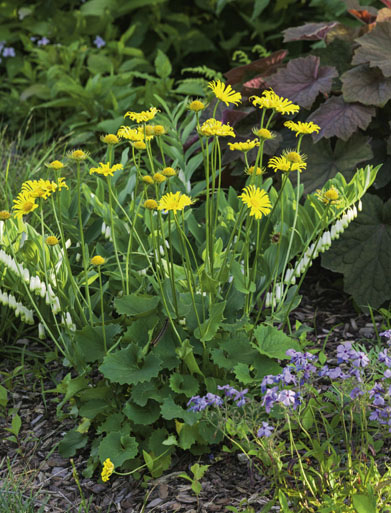
Doronicum orientale ‘Little Leo’
‘Magnificum’ has single, 2-in. flowers a little earlier than ‘Finesse’. Dark green, heart-shaped leaves. Probably a hybrid. 2–2.5 ft. tall
‘Spring Beauty’ (‘Frühlingspracht’) has double flowers. Susceptible to fungal diseases in warm, humid summers. 12–16 in.
Fabaceae
canary clover
This genus includes a dozen or so natives of the Mediterranean region and the Canary Islands, only one of which is cultivated in ornamental gardens.
Best grown in a fertile, alkaline soil that has free drainage, this plant requires little or no irrigation once established, even in semi-arid regions. Where drainage is suspect, mix grit into the hole prior to planting; hairy canary clover does not tolerate wet feet. Winter temperatures much below 20°F damage the top growth, but the plants typically resprout from the roots even after temperatures as low as 5°F. Maintenance is low, and the flowers self-clean, avoiding the need for deadheading. Self-seeds occasionally.
Canary clovers’ soft, fuzzy aspect makes this a good choice for softening the edge of a path, for sunny rock gardens, or spilling over low rocks in xeriscapes. They do best in regions where summer humidity is low.
Propagate by seed. Germination is accelerated, if the seed coats are scarified or nicked.
Dorycnium hirsutum
syn. Lotus hirsutus
• pinkish white
• late summer to early fall
• 12–24 in. × 36 in.
• sun
• Z8–10
Hairy canary clover, gray broom. Canary Islands. This low, evergreen subshrub—a perennial with a woody base—combines exceptional drought tolerance with an unusual, eye-catching appeal. It demands a sunny spot to thrive and it is the sun that highlights its most attractive feature: the soft, gray-white hairs that cover the clover-like, triple leaflets that glow silver when strongly illuminated. The pea-shaped, 0.75-in.-long, white flowers, veined with pinkish red, are of secondary importance. They are borne in 1- to 1.5-in. umbels of four to ten, in the leaf axils and at the branch ends. Following the flowers is a display of short, round, red-brown seedpods.
Lamiaceae
dragonhead
Many of the dragonheads are annual or dwarf shrubs and so outside the purview of this book, but the genus also includes a number of perennials that deserve a spot in sunny gardens. Their whorls of gorgeous blue flowers, aromatic foliage, adaptation to sun, and attraction for foraging butterflies, birds, and bees certainly earn them a trial. Furthermore, deer seldom browse them.
As with most members of the mint family, dragonheads’ stems are square in cross section and the tubular flowers are two-lipped, grouped in whorls in the leaf axils or in terminal clusters that may reach 10 in. in length.
Plant dragonheads in a sunny or only lightly shaded spot, where the soil drains well. It does not have to be overly rich—average soil is fine, but these plants will not tolerate winter wet. If necessary, amend the soil in the planting hole to improve drainage. Protect from intense afternoon sun.
Dragonheads are easy to grow and are best propagated from soft tip cuttings or by division of established clumps in spring or fall. Seed is somewhat tricky but is usually successful if it receives a cold spell after sowing indoors.
Dracocephalum argunense
syn. D. ruyschiana var. speciosum, D. speciosum
• blue
• early to late summer
• 12 in. × 10–12 in.
• sun, part shade
• Z4–8
Dragon’s head. Native to grasslands of northeastern Asia and Siberia, this species is ideal for sunny rock gardens, in containers, or at the front of flower borders. It makes neat mounds of slender, deep green, 1-in., needle-like leaves similar to those of rosemary; stems are topped with terminal spikes of blue, hooded flowers, similar to related sage, with a pale blue lip. Drought tolerant and easy care, but does not tolerate winter wet. Bees flock to the flowers in summer; fine in a wildlife garden or near beehives.
‘Fuji Blue’ has brilliant blue flowers. Z5.
‘Fuji White’ (for Mt. Fujiyama) has snowy white flowers with a blue-tinged lip. Z5.
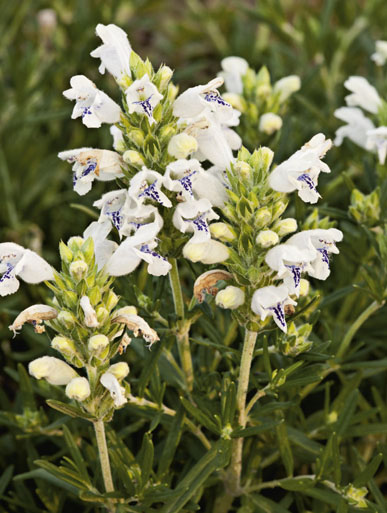
Dracocephalum argunense ‘Fuji White’
Dracocephalum grandiflorum
• blue
• summer
• 10–12 in. × 6–8 in.
• sun
• Z3–8
Dragon’s head. Siberia. Rising from rhizomatous roots, 1- to 2-in., toothed leaves on long stalks form a basal rosette. Erect flower stems are clothed in opposite pairs of stemless (sessile), oval leaves. Prominently hooded, 1.5-in., intensely blue flowers are spotted with violet on the lower lip, and cluster at the stem tips and nodes.
‘Altai Blue’ has pairs of softly hairy, serrated, dark green leaves and strong dark blue flowers arranged in whorls and at the stem tips. The lips of the flowers are whitish, decorated with dark spots. 8 in. tall.
Dracocephalum ruyschiana
• blue
• early to late summer
• 18–24 in. × 12 in.
• sun
• Z3–7
Siberian dragon’s head, northern dragonhead, Nordic dragonhead. Central Europe. The aromatic foliage of Siberian dragon’s head is known for its essential oils and was used tradionally to make tea said to imbue courage. Erect with slightly hairy stems; typical hooded, blue flowers. Must have free-draining soil. Ideal in rock gardens, between patio cracks and crevices, and in xeriscapes.
‘Blue Dragon’ has whorled spikes of 1-in., clear dark blue flowers on erect, sometimes hairy stems, above the evergreen mass of aromatic, rosemary-like foliage. Good drainage is essential, but tolerant of drought when established. 12–15 in. Z4–7.
Araceae
dragon arum
For hermits wishing to be left alone, or those really looking to one-up a friend or neighbor, no plant is more perfect! From tuberous roots, dragon arum produces large, flat, Jack-in-the-pulpit-like flowers the color of rotting meat and smelling as bad, but only for a couple of days. The odor attracts countless flies that pollinate the flowers. These bloom in spring and summer under the partial shade of light woodlands. The spotted basal leaves are divided into segments, sometimes considered to be reminiscent of a dragon’s claw.
Resistant to deer, rabbits, and rodent browsing. Increase by removing offsets from the tuberous roots in spring or fall.
Dracunculus vulgaris
• purple
• spring to summer
• 3–5 ft. × 2 ft.
• part shade, shade
• Z6–10
Dragon arum, voodoo lily, stink lily. Native to the Balkans, Greece, Crete, and the Aegean Islands. The red-purple spathe of this species may reach 3 in. long, with undulating edges, around an upright, slender, blackish “Jack” (the spadix), 12–18 in. or more in length. Coined “Viagra lily” by Tony Avent of Plant Delights Nursery, these plants are both erotic and exotic. Provide well-drained soil and a site in part or even heavy shade. In cold regions, lift the tubers and protect over winter as for elephant ear. Slow to get started in spring. To maintain vigor it is wise to remove offsets from the tuberous roots every few years. The roots are toxic, so handle carefully and with gloves. Following the flower, green berries, which mature to orange-red, appear at the base of the spadix.
Crassulaceae
liveforever
These close relatives of echeverias and sedums, mostly native to the southwestern United States and Mexico, are valuable in desert gardens or in summer containers in temperate zones. They also do well and are popular as indoor plants for frost-free sunrooms and conservatories in cold-winter regions.
Although most species tolerate a very light frost, they are better suited to warm climates in sun or light shade inland; only Dudleya arizonica and D. saxosa survive the intense sun of Arizona. Dudleyas are well suited for xeric and rock gardens, wildlife and native gardens, succulent gardens, or as edgings along paths of dry gardens. Excellent as companion plants for native sages, cacti, succulents, and grasses.
Leaves may be arranged in a flattened basal rosette or may develop into tubular clumps, spreading by suckers. Flowers do not emerge from the top of the stems, as do echeverias, but rather emerge from further down the stem. Soil must drain freely; these succulents will not survive wet winter conditions. If necessary, set the crown of the plant on an angle to encourage surface rain to drain away. A mulch of gravel is also helpful. Infestations of mealybugs are sometimes serious, especially on indoor plants.
Propagate by seed in spring; seed germinates well at about 60°F. Alternatively, take stem cuttings in spring and early summer. Allow cuttings to dry for a few days to callus before inserting in a sandy rooting medium.
Dudleya brittonii
• yellow
• midwinter
• 6–24 in. × 15 in.
• sun
• Z9–11
Silver dollar plant, chalk dudleya. Baja California. Grown for its evergreen, silver foliage, silver dollar plant may sometimes be found without its gray, waxy coating, but these plants are not as popular. It makes neat, compact plants with juicy, spatulate leaves of a watery sea-green color, covered by waxy bloom. Flower stems are bright red and very showy combined with the starry, pink-bracted yellow or orange flowers above. As the plants mature, the old dead leaves hang on and form a rough “tutu” on the main stem.
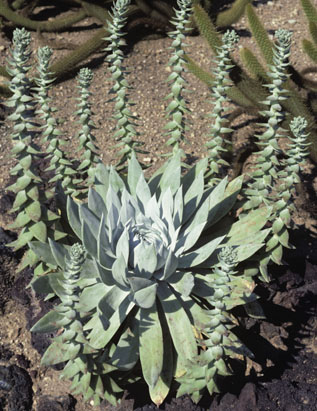
Dudleya brittonii
Crassulaceae
hens-and-chicks
There are groups of plants on which collectors fixate and the genus Echeveria is prominent among them. It includes approximately 150 species of succulents and countless hybrids, many of which, although attractive, can seem redundant to the uninfatuated. The good news is that almost any choice will be a good one: hens-and-chicks combine striking architectural forms—typically precise, tight rosettes of fleshy leaves—with vivid colors, ease of cultivation and, for a bonus, long-lasting, Dr. Seuss-like flowers.
Echeverias originated in the high plains, mountainsides, and cliff faces of Central and South America and, although exceptionally drought tolerant, they prefer regular irrigation during periods of active growth. Let dry out between waterings and provide a gritty, very well-drained soil. Tolerant of full sun or part shade; where intense sunlight combines with high heat, protect from midday sun.
Elegant, non-invasive groundcovers for rock and gravel gardens, echeverias’ tolerance for drought makes them ideal for xeriscapes. Exceptionally handsome as container plantings, which in cold-winter regions may be overwintered indoors, providing an opportunity to explore the many fine but frost-intolerant species, such as Echeveria elegans, E. nodulosa, and E. setosa.
Pests include aphids (especially on the flowers) and mealybugs. Sensitive to overwatering; not browsed by deer.
Propagate by removing and replanting rooted offsets or by rooting individual leaves.
• red
• spring to early summer
• 6 in. × 12 in.
• sun, part shade
• Z8–11
Red-edge echeveria. Mexico. Forms broad rosettes, often solitary, of red-edged, apple-green leaves, each tipped with a spine. Red, 0.75-in. flowers with yellow-tipped petals arranged in a one-sided spike on 20-in. stems.
‘Lipstick’ has leaves neatly edged with intense red.
Echeveria nodulosa
• red
• summer
• 1–2 ft. × 2–3 ft.
• sun, part shade
• Z9–11
Painted echeveria. Southern Mexico. Sprawling, branched stems, 1–2 ft., carry 5-in.-wide rosettes of pointed, chartreuse-green leaves, striped with red at mid-leaf and on the margins. Red flowers tipped with yellow borne in small sprays on erect stems shrouded with bracts the same color as the foliage.
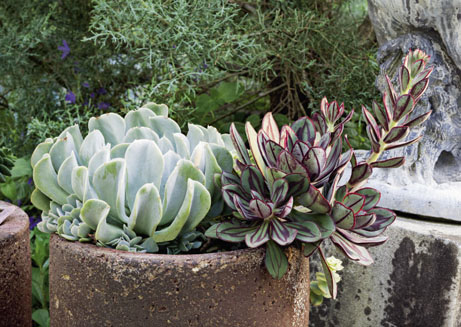
A beautiful container with red-striped Echeveria nodulosa
Echeveria runyonii
• yellow-and-orange
• summer
• 1 ft. high and wide
• sun, part shade
• Z7–11
Runyon’s echeveria. Mexico. Commonly sold under cultivar name ‘Topsy Turvy’ in reference to the growth habit of the keeled, pale blue-gray leaves that curve upward, with their tips pointing inward to the center of the rosette. Fast growing, quickly forming a mound with individual rosettes measuring as much as 1 ft. in diameter. Perhaps the cold hardiest of echeverias, reported to be hardy to 7°F by Tony Avent of Plant Delights Nursery. Grown for foliage.
Echeveria shaviana
• pink
• midspring to early summer
• 2.5 in. × 6 in.
• sun, part shade
• Z9–11
Mexican hens. Mexico. Rosettes of frilly, blue-green leaves, to 6 in., that take on a pink blush in strong light. Bears sprays of bell-shaped, pink flowers. Grown for its foliage.
‘Blue Giant’ is extra-large, with blue-green foliage. 6 in. × 12 in.
‘Pink Frills’ bears young, mauve-purple leaves at the centers of the rosettes that age to silvery blue-green.
Other Notable Cultivars
There are numerous and varied cultivars, mostly grown for their foliage. This is a sampling of what’s available.
‘Black Knight’, very dark chocolate, pointed leaves and a long season of striking red flowers, typically in autumn and winter.
Compact Glow is slow growing with pink, crinkled, undulating leaf edges; leaf blade is bluish gray-green. 6–12 in. Z9–11.
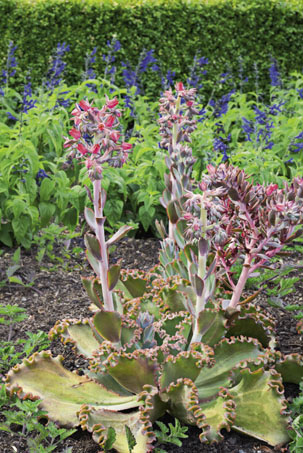
Echeveria Compact Glow
‘Jade Point’ has deep green, glossy, densely packed, elongated leaves tipped with red.
‘Perle von Nurnberg’ displays broad leaves, green-gray around the outside of the 8-in. rosettes, deep pink toward center.
Asteraceae
purple coneflower
Its easy-care ways and long season of bloom has put Echinacea at the very top of the “essential perennials” list for many gardeners. And purple coneflowers are getting better all the time: during the past decade, plant breeders, most notably those at ItSaul Nursery, the Chicago Botanic Garden, and Terra Nova Nurseries, have been releasing all sorts of exciting new cultivars and hybrids. Now, in addition to the familiar single, purple (and sometimes white), daisy-type blossoms, a host of echinaceas with flowers in exotic colors and forms, and often fragrant, are appearing in catalogs and garden centers. Yellows and oranges have been added to the color palette, as well as outrageous double-flowered forms and some with top knots.
Purple coneflowers are vigorous plants, clothed with mostly coarse, dark green, bristly hairy foliage on strong, branching stems. Basal leaves usually have long petioles and may be toothed along their edges; stem leaves are narrower, often without petioles. The stems terminate in solitary, daisy-like flowers, good for cutting. The ray flowers (petals) surround a raised, prickly central disk that persists after flowers fade.
Purple coneflowers do best in sunny spots but tolerate light shade. They thrive in most well-drained soils, and even endure periods of drought once established; wet feet, however, especially in winter, is usually fatal. Plant in late spring or early summer so the roots have time to become established before cold weather arrives. Pollen and nectar-collecting songbirds, bees, and butterflies are frequent visitors through summer and fall. Regular deadheading results in an extended season of bloom. Allow late-season flowers to go to seed, to provide food for birds—seedeaters feast on the oil-rich seeds inside the central fruiting cone.
Purple coneflowers are versatile garden plants from the designer’s perspective. Use tall selections among shrubs or at the back of the border, or mass them in informal meadows, wildlife gardens, or native plant gardens. Dwarf selections are ideal for containers, especially when combined with foliage plants such as coleus, gauras, or fountain grass. Seldom browsed by deer or rabbits, but mildew and Japanese beetles may be a problem.
Propagate species by seed sown outdoors in fall or in containers in spring and chilled for four weeks to break dormancy. Divide named cultivars and hybrids in spring.
Echinacea pallida
• purple
• summer
• 2–3 ft. × 1–1.5 ft.
• sun, part shade
• Z10–3, HT
Pale purple coneflower. Open areas along roadsides, fields, and grasslands of the eastern United States. Thrives in most soils, even poor ones, as long as they are well drained. Tolerates heat, humidity, and drought well, and is a good subject for gardens in the southeastern United States. The mound of narrow, dark green leaves contrasts well with the light purplish, sweet-scented flowerheads above. These have extremely reflexed rays, giving the heads the appearance of a shuttlecock. Ideal in meadows, native plant gardens, and wildlife gardens, or massed in open spaces where they naturalize over time. Can also be used as a temporary summer hedge, perhaps interplanted with tall ornamental grasses.
Echinacea paradoxa
• yellow
• summer
• 1–3 ft. × 1–1.5 ft.
• sun
• Z5–8
Yellow coneflower, Ozark coneflower, Bush’s purple coneflower. Open areas of the Ozark region of Missouri and Arkansas in fertile, free-draining sites. Erect stems are topped with fragrant, showy, bright yellow, 3-in. flowerheads with swept-back rays surrounding a raised, chocolate-colored disk. Provide full sun and well-drained, even somewhat dry soil—very drought tolerant when established. Not as vigorous as Echinacea purpurea; may need support. If planting in fall, it is important to plant sufficiently early to give roots time to grow in well before very cold weather. New plants may not bloom the first summer. Group or mass to provide impact in meadows, or native plant and wildlife gardens. Striking at the back of the border, among shrubs such as chaste tree and butterfly bush, or Miscanthus and other bold ornamental grasses.
‘Hula Skirts Yellow’ is a particularly fine selection with larger flowers.
Echinacea purpurea
syn. Rudbeckia purpurea
• purple, white
• summer
• 2–4 ft. × 1.5–2 ft.
• sun, part shade
• Z4–9
Purple coneflower, eastern purple coneflower. Florida and Texas north into Ontario. These plants were a dominant species of the prairies, and in gardens are especially handsome when massed in meadows or with other natives in wild gardens. They have strong root systems and must be planted before midsummer to establish and grow deep. The flowerheads of these traditionally purple or whitish daisies may reach 6 in. or so across, with slightly drooping ray flowers. The deep brown central disk becomes cone-like as it matures. Stiff orange bracts protrude from the cone.
Other Notable Cultivars
Countless selections and cultivars of purple coneflower are in the marketplace, with more almost daily. Hybrids are mostly the results of crossing Echinacea paradoxa, E. purpurea, and E. angustifolia. Below is just a small sampling of what is available.
‘Art’s Pride’ (Orange Meadowbrite) was the first orange coneflower—a color breakthrough—to appear on the market. Striking 5-in., coppery-orange flowerheads; slender, reflexed rays encircle raised, dark brown cones. 2–3 ft. Z3–8.
‘Coconut Lime’ was the first white, double-flowered, purple coneflower; the flowers start out light green, maturing to greenish white. The full topknot of flowers, orange in the center, is long lasting above a fringe of drooping, white rays. 2–2.5 ft. Z4–9.
‘Fragrant Angel’ has very large, fragrant, white flowers with gold cones. Partner with tall gayfeathers and daylilies. Prefers humus-rich soil. 3 ft. Z4–9.
‘Green Envy’ is an unusual large-flowered novelty. The black, green-centered cones are surrounded by long ray flowers, pale green at the tips and pink toward the cone. A Mark Veeder selection. 3 ft. Z4–9.
‘Green Jewel’ is perfect as a cut flower for St. Patrick’s Day. The fragrant, bright green, 4-in. flowerheads have jade-green rays and deep green cones. Sturdy and compact, but demands good drainage. Ideal for containers. 1.5–2 ft. Z3–8.
Harvest Moon (‘Matthew Saul’) belongs to the Big Sky Series from ItSaul Nursery. Single, sorbet-yellow daisies with raised, orange cones on strong, branched stems. Broad ray flowers, gently reflexed, overlap slightly. 2–2.5 ft. Z4–9.
‘Hot Papaya’, a double Dutch selection, has fully double, fiery-red pompon heads above a skirt of paprika-colored rays. Strong, maroon-marked stems. 2.5–3 ft. Z5–9.
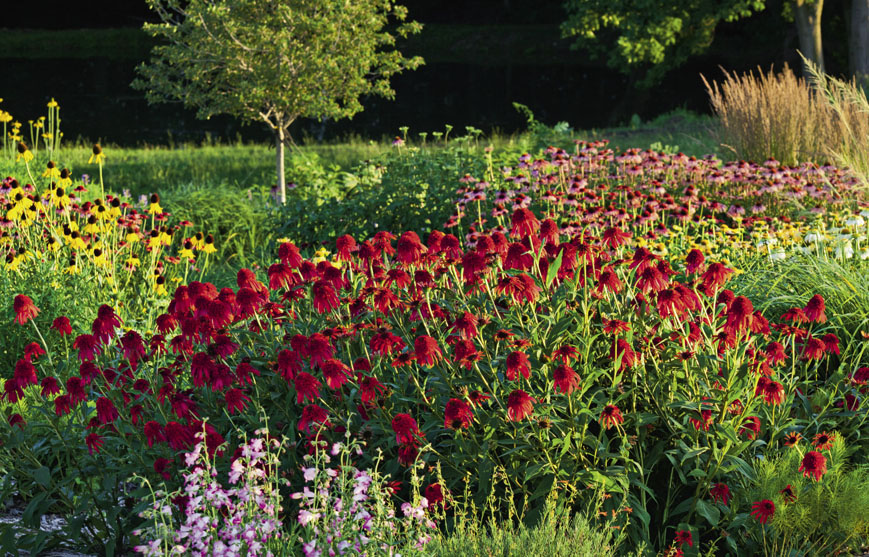
Echinacea ‘Hot Papaya’ and others make this garden shine
‘Kim’s Knee High’, perennial dwarf purple coneflower, has strongly reflexed, purple-pink ray flowers and prominently raised, orange cones. Ideal in limited spaces. Drought tolerant. 1–2 ft. Z3–9.
‘Magnus’ was the 1998 Perennial Plant Association (PPA) Plant of the Year. Its hot-pink flowerheads accented with a copper-brown cone may reach 3–4 in. across on very strong stems. The broad rays are carried horizontally. Dramatic with ‘Pomegranite’ yarrow. 2.5–3 ft. Z3–9.
‘Milkshake’ is a selection from the Dutch double-flowered Cone-factions series. It has strongly reflexed, vanilla cream ray flowers above which the usual central cone is smothered with double, vanilla-cream flowers. 3 ft. Z5–9.
‘Pink Double Delight’ offers “in-your-face” bright pink, double flowers. 1.5–2 ft. Z4–8.
‘Razzmatazz’ was the first fully double (anemone type), purple coneflower on the market. It has an eye-popping rounded topknot of bright pink, double flowers and a fringe of drooping, dark purplish pink ray flowers. Long blooming; deadhead routinely. Suitable for containers, at the front of the border, and as cut flowers. 2.5–3 ft. Z4–8.
‘Rubinsturn’ has carmine ray flowers that are held horizontally. Considered by some to be superior to the older ‘Magnus’. Grown from seed stock. 40 in. Z4–9.
‘Sunrise’ (Big Sky Sunrise). Fragrant, light greenish yellow daisies accented with a green-maturing-to-orange cone make a cool color combination. 2.5–3 ft. Z4–9.
‘Tiki Torch’ is eye-catching with 3-in.-wide daisies; drooping, brilliant pumpkin to orange rays surround rounded, reddish cones. 2.5–3 ft. Z4–9.
‘Tomato Soup’ has flowers that truly are the color of real red, ripe tomatoes. Large flowerheads, 5 in. or more across, bear slightly drooping rays around brown cones. 32 in. Z4–9.
‘White Swan’. Possibly the best white cultivar. Heat, drought, and humidity tolerant even in poor soil. Vigorous, bears plenty of flowers with slightly drooping rays on strong erect stems. 2–3 ft. Z3–8.
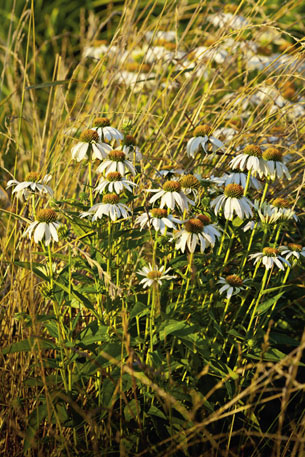
Echinacea ‘White Swan’
Asteraceae
globe thistle
This wide-ranging genus includes 120 or so species that are native from western Europe to central Asia, and south into the mountains of tropical Africa. None is native to North America, but most are enthusiastic self-seeders and can be weedy in US gardens if allowed to proliferate unchecked, though none as yet have proven invasive.
These are plants to use with caution then, but their spiny, silvery foliage combined with prickly, globular heads of flowers gives them an architectural quality that can be invaluable as a focal point in a sunny, dry border or bed. As specimen plantings, displayed by themselves, they have a steely, modernist elegance, yet they also blend easily into cottage gardens, perhaps because their strong presence enables them to keep their own identity within a lush, informal chaos. Globe thistles also make striking cut flowers, fresh and dried. Attractive to birds, butterflies, and bees, they are sometimes attacked by aphids, but in general have no serious insect or disease problems. Deer ignore them.
Globe thistles thrive on dry, shallow, and rocky soils as well as ordinary garden loams, as long as the soil is well drained and not overly fertile. They are taprooted, and hard to dig or transplant once established. Taller types, especially when grown on rich soils that encourage soft, lanky growth, may require staking.
Propagate by seed; divide mature clumps in spring, or root cuttings taken in early spring.
Echinops bannaticus
• blue
• early to late summer
• 4–6 ft. × 1.5–2 ft.
• sun
• Z4–9
Globe thistle. Southeastern Europe. Bears spiny, large (to 14 in.), deeply dissected leaves on stiff, fibrous, sometimes branching stems. Foliage is green above with downy-white underside. Produces showy (to 2 in.) gray-blue, globular flowerheads at stem tops over six to eight weeks in summer. Can self-seed prolifically; deadhead to keep from becoming a weed.
‘Blue Glow’ is somewhat compact and has intense steel-blue flowerheads. 4 ft. tall.
‘Star Frost’ is slightly more compact than ‘Blue Glow’ and bears heads of pearly white flowers. To 40 in.
Echinops gmelinii
• blue
• early to late summer
• 18–24 in. × 6–9 in.
• sun
• Z3–8
Globe thistle. Central Asia, Mongolia, China. Forms erect clumps of stiff stems with spiny-edged, oblong leaves that are green above and downy white underneath. Bears globular, white flowerheads to 1 in. across.
Echinops ritro
• blue
• mid- to late summer
• 3–4 ft. × 2–2.5 ft.
• sun
• Z3–8
Small globe thistle. Central and eastern Europe to central Asia. This species has woolly, deeply lobed, thistle-like, green foliage. Golf ball–sized, steel-blue heads, excellent for cutting. Deadhead to prevent excessive self-seeding.
‘Veitch’s Blue’ has powder-blue flowers and steel-blue leaves, silvery beneath.
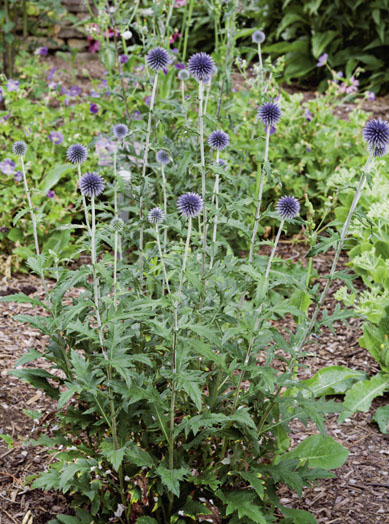
Echinops ritro ‘Veitch’s Blue’
subsp. ruthenicus ‘Platinum Blue’ has 2-in., steel-blue flowerheads and silvery, pointed, serrated leaves.
Echinops sphaerocephalus
• white
• early summer to early fall
• 3–6 ft. × 2–3 ft.
• sun
• Z3–10
Great globe thistle. Southwestern Europe through Siberia and China. Bears silvery, slightly spiny, deeply dissected leaves, to 14-in. long, on branching, hairy stems. Globular, white, 2-in. flowerheads borne at the stem tips through summer.
‘Arctic Glow’ is compact with mahogany stems and white flowers. 3 ft. × 1.5 ft.